Answer the call of the wild in September with a two-week self-drive itinerary that spans Iceland’s breathtaking Ring Road.
This 14-day Iceland September itinerary is timed perfectly to offer you the best of Iceland—vibrant landscapes with fewer people, at a lower cost, and under the ethereal glow of the Northern Lights.
Along with a suggested route, overnight stops and places to visit, I’ve also included photography tips to help you along the way.
So, whether you’re looking for famous sights or off-the-beaten-path marvels, get ready to explore the essence of Iceland’s rugged beauty with us.
Note: All the attractions on our 14-day itinerary were accessed using a 2WD hire car.
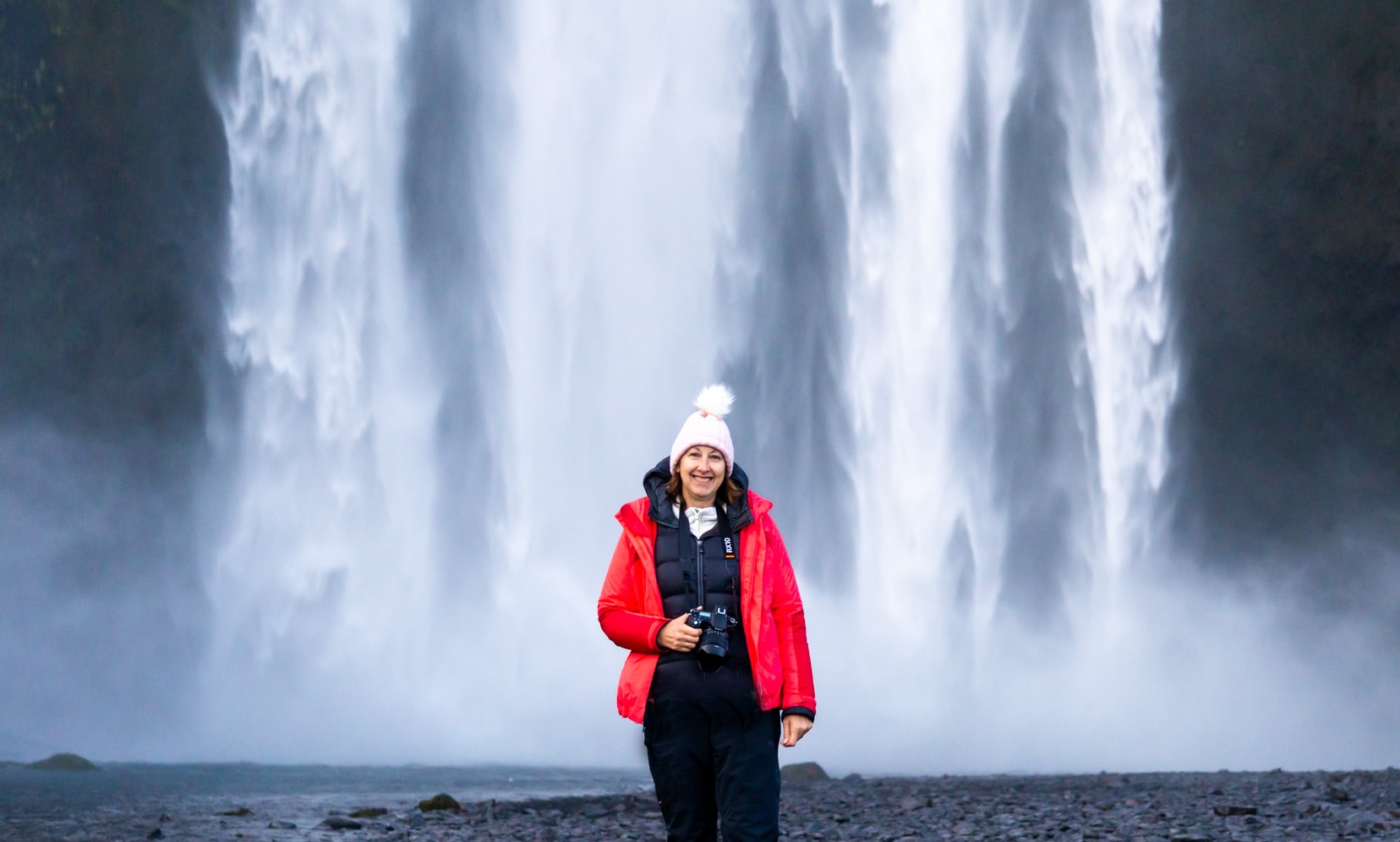
Iceland September Itinerary: 14-Day Ring Road Overview
Iceland’s Ring Road is 1332 km (828 miles) long, making it the country’s longest road. It can be travelled in either direction, but we travelled anticlockwise.
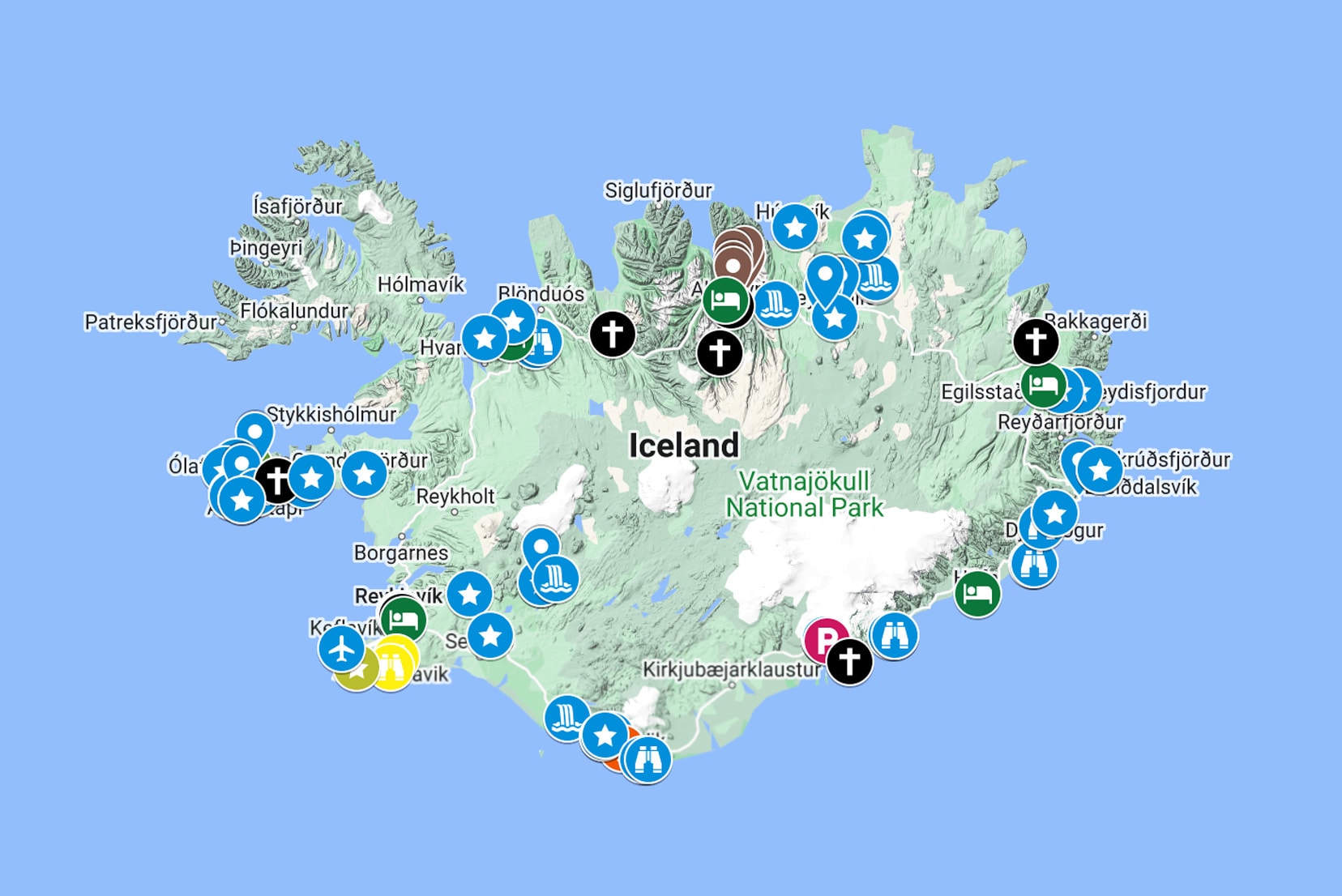
Day 1 – Reykjavik
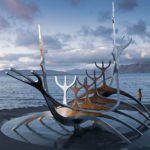
- Sun Voyager
- Hallgrimskirkja
- Monument to the Unknown Bureaucrat
- Tjörnin Lake
- Harbourside Old Fisherman Huts
- Chase the Northern Lights
🏡 Overnight Accommodation: Reykjavik
Day 2 – Golden Circle Route
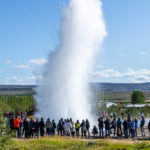
- Þingvellir (Thingvellir) National Park
- Kerið Crater
- Geysir field, including ‘Strokker‘
- Gullfoss Waterfall
- Seljalandsfoss Waterfall
🏡 Overnight Accommodation: Skógar (near Vik)
Day 3 – Vik (closest town)
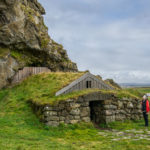
- Seljalandsfoss waterfall
- Rutshellir Caves
- Drangurinn í Drangshlíð (ancient rock dwellings)
- Skógafoss waterfall
- Kvernufoss waterfall
🏡 Overnight Accommodation: Skógar (near Vik)
Day 4 – Vik (closest town)
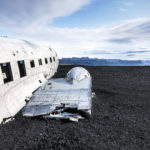
- Solheimasandur plane wreck
- Dyrhólaey (rock arch in the sea)
- Reynisfjara Beach
🏡 Overnight Accommodation: Höfn
Day 5 – Höfn (closest town)
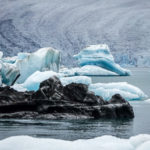
- Hofskirkja
- Svartifoss, Magnúsarfoss, Hundafoss waterfalls
- Jökulsárlón Glacier Lagoon
- Diamond Beach
🏡 Overnight Accommodation: Höfn
Day 6 – Seydisfjordur (closest town)
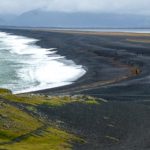
- Hvalnes Nature Reserve Beach and Hvlanes Lighthouse
- Eggin í Gledivik (egg sculptures)
- Hafnarnes Lighthouse
🏡 Overnight Accommodation: Egilsstaðir (near Seydisfjordur)
Day 7 – Seydisfjordur (closest town)
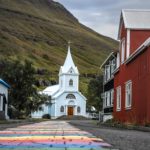
- Seyðisfjörður (Seydisfjordur) Blue Church
- Seydisfjordur rainbow road
- Geirastadakirkja
🏡 Overnight Accommodation: Egilsstaðir (near Seydisfjordur)
Day 8 – Akureyri (closest town)
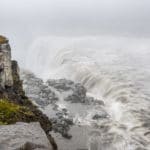
- Detifoss, Selfoss, Goðafoss waterfalls
- Asbyrgi Canyon
- Hverir lava fields
- Grjótagjá Cave
- Myvatn Lake
- Goðafoss waterfall
🏡 Overnight Accommodation: Akureyri
Day 9 – Akureyri (closest town)
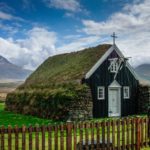
- Akureyri church
- Akureyri Botanical Gardens (Lystigarðurinn)
- Saurbæjarkirkja church
🏡 Overnight Accommodation: Akureyri
Day 10 – Blönduós (nearest town)
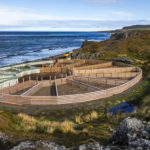
- Víðimýrarkirkja (turf church)
- Vatnsdalsholar hillocks
- Hvitserkur (sea rock arch)
- Hamarsrétt (sheep corral)
🏡 Overnight Accommodation: Hvítserkur (near Blönduós)
Day 11 – Ólafsvík (nearest town) on Snæfellsnes Peninsula

- Ingjaldshóll Church
- Skarðsvík Beach (site of Viking burial)
- Saxhólar Crater
🏡 Overnight Accommodation: Olafsvik
Day 12 – Olafsvik (nearest town) on Snæfellsnes Peninsula
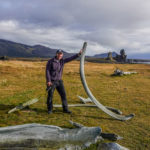
- Shipwreck debris on Djúpalónssandur Beach
- Lifting stones on Djúpalónssandur Beach
- Malarrif Lighthouse and Saltús Museum
- Londrangar rock pinnacles
- Bárðar Saga Snæfellsáss statue
- Gatklettur stone arch of Anarstapi
🏡 Overnight Accommodation: Olafsvik
Day 13 – Ólafsvík (nearest town) on Snæfellsnes Peninsula
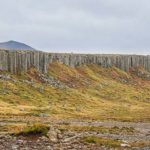
- Búðakirkja church
- Ytri Tunga seal watching
- Gerðuberg basalt columns
- Ölkelduvatn mineral spring
🏡 Overnight Accommodation: Reykjavik
Day 14 – Reykjavik

- Reykjavik
Video: Iceland in 2 Minutes
Before we dive into the details of our 14-day itinerary, here’s a quick 2-minute video to give you a taste of the stunning landscapes and adventures that await you in Iceland
Why Visit Iceland in September?
September heralds the start of fall in Iceland, offering a quieter time to visit but allowing for a more intimate experience of Iceland’s natural wonders.
Travelling to Iceland in September offers numerous advantages.
Here’s why we chose to visit:
- Shoulder Season Benefits: Enjoy lower costs and fewer crowds; cheaper flights and accommodations (compared to peak times); and better availability to hotels and car rentals.
- Pleasant Weather: September’s weather conditions are generally favourable. We experienced a few intermittent showers, but not enough to force us indoors.
- Northern Lights: This out-of-world wonder of nature becomes visible in September. We had our best sightings of the Northern Lights, but more on the lights later in the post.
- Moderate Temperatures: Expect a comfortable temperature range between 5 to 10°C. However, temperatures dipped markedly in the vicinity of Jokulsarion Glacier Lagoon.
- Outdoor Accessibility: Without snow cover, driving is safer, and hiking trails are more navigable. We did not experience any snow.
- Autumn Scenery: Any fall colours can enhance the warmth of your photographs.
- Extended Daylight: There’s still ample daylight, between 11.5 to 14.5 hours, to explore attractions.
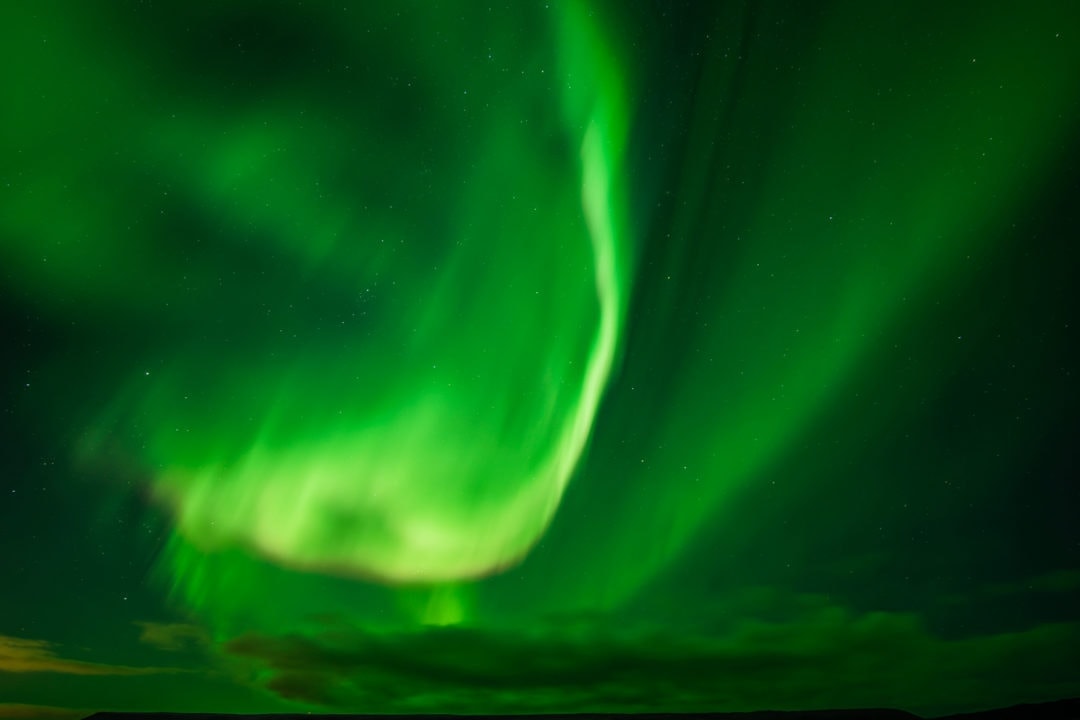
Planning Your Travels to Iceland?
- 🏥 Travel insurance: We recommend World Nomads or Safetywing
- ✈️ Flights: Use Skyscanner for flight booking deals
- 🚘 Need to hire a car? We use and recommend DiscoverCars
- 🚐 Camper Hire: We recommend Motorhome Republic
- 🪪 Need an International Driver’s License? Order online here
- 🐕🦺 Pet Care: Use TrustedHousesitters and have an animal lover look after your pet for FREE (Use our Discount code: LIFEJOURNEY25 for 25% off)
Map: Iceland Ring Road Attractions – September
To use this map, expand it using the square symbol on the top right-hand side and then look to the key on the left-hand side. By clicking each location, you will find the corresponding position on the map.
- Blue circles with a star denote an attraction;
- Dark Green circles denote overnight accommodation;
- Black circles denote churches;
- Yellow circles denote viewpoints;
- Brown circles denote alternative routes to the toll road;
- Orange denotes the DC3 plane wreck;
- A Light Green circle denotes an alternative option.
September in Iceland Itinerary – Our 14-day Extravaganza
Iceland is so different from the many countries we have visited. This remote island accentuates nature’s rawness.
Being able to get so close to so many of the island’s attractions, plus the sheer diversity of the landscapes, made it an extraordinary and memorable experience.
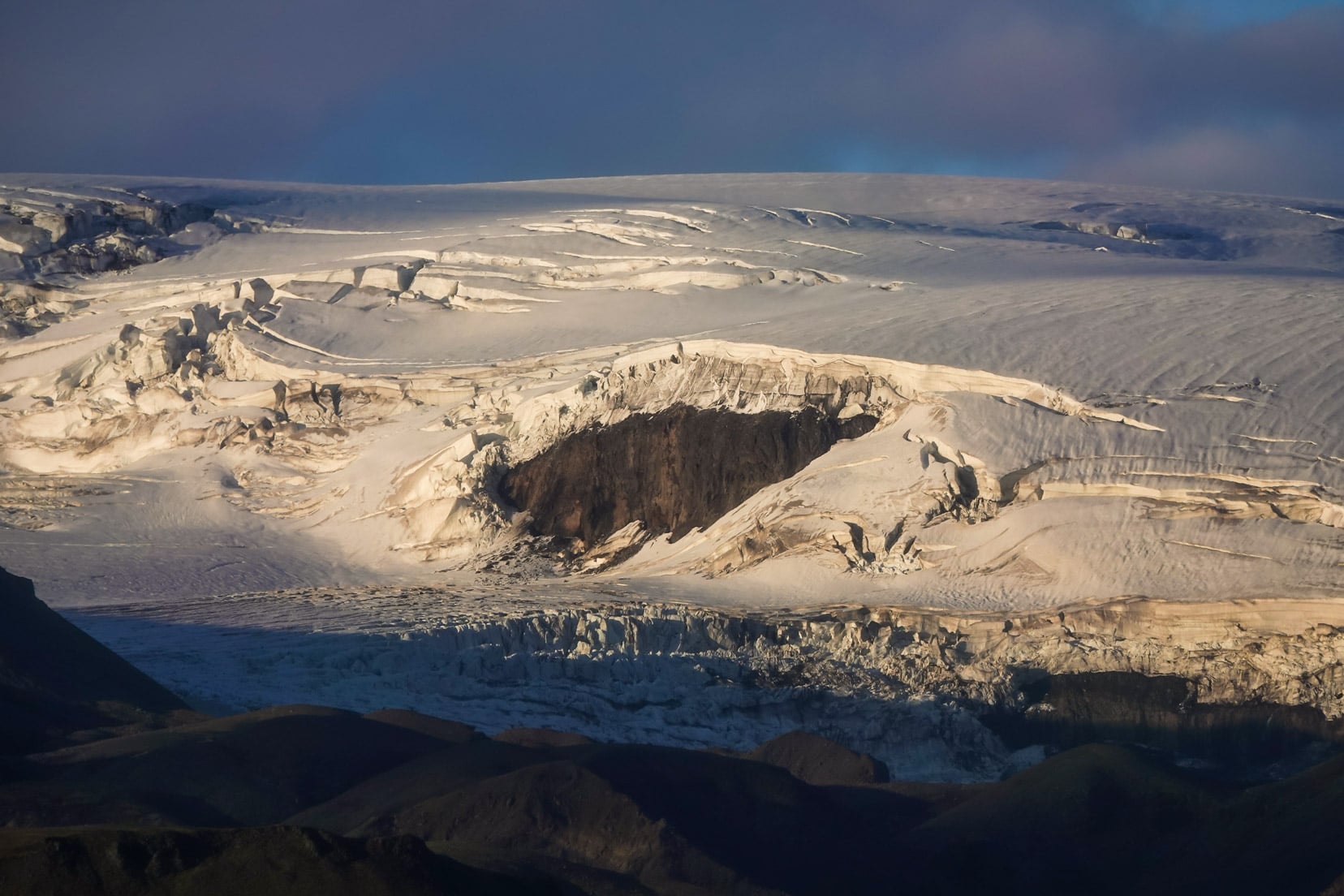
Day 1: Explore Reykjavik
🏡 Overnight Accommodation: Reykjavik
When we arrived at Keflavik Airport, 50km from Reykjavik, our priority was to pick up the hire car. Many rental car companies are based near the airport, so we took the free airport shuttle bus.
Once you’ve got your car, here’s what you can look forward to in Reykjavik:
- Sun Voyager,
- Hallgrimskirkja,
- Monument to the Unknown Bureaucrat,
- Tjörnin Lake,
- Harbourside Old Fisherman Huts
Sun Voyager
As a photographer, one of my favourite places to visit in Reykjavik is the Sun Voyager, which is easily the most famous sculpture in Iceland.
Sun Voyager reflects the artist’s impression of a ‘promise of undiscovered territory, a dream of hope, progress and freedom’.
📸 Photography Tip
This is a popular tourist attraction. We visited close to sunset, and it was quite busy, so waiting for an opportunity to shoot when people weren’t in the way was a challenge.
Shooting at either sunrise or sunset does attract the softest light in your image. Be mindful of the wind if using a tripod.
During our September visit, the sunset was more or less perpendicular to the angle of the shot below, thereby maximising the effect of a polarising filter.
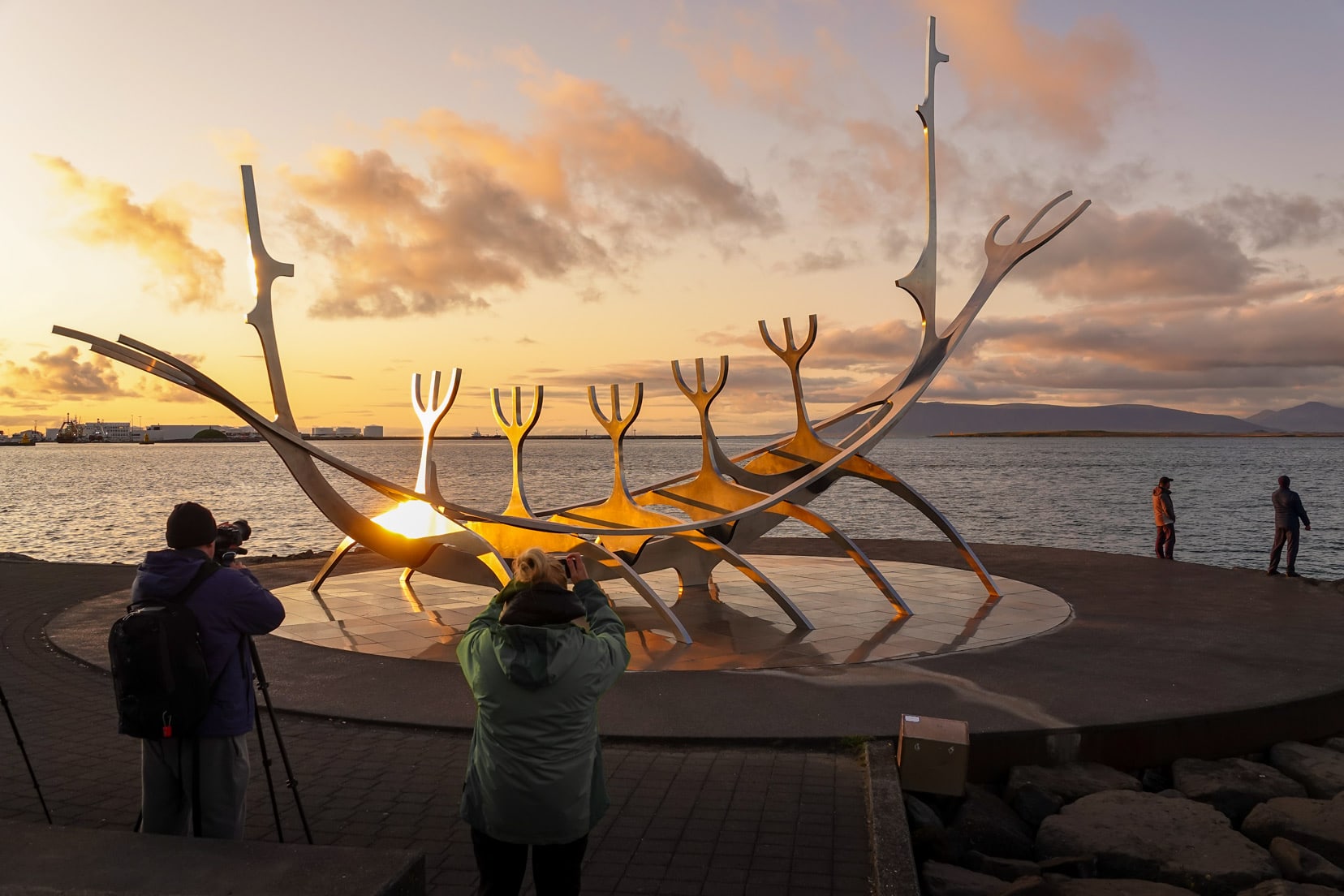
Hallgrimskirkja
The Lutheran Church of Hallgrimskirkja dominates Reykjavik’s skyline. What grabbed my attention was its unique architecture. The church’s architect was moved by shapes formed by cooling lava.
Iceland’s basalt columns provided the inspiration for the church’s unique design. The same architect designed the Akureyri Church (we visited Akureyri later).
Above the bell tower is an open-air observation deck. Tower opening times can be found on the Hallgrímskirkja website.
📸 Photography Tip
Consider capturing the tall, sweeping basalt columns to amplify the structure’s alignment with nature.

Monument to the Unknown Bureaucrat
The Monument to the Unknown Bureaucrat is a somewhat distinctive piece of art. It isn’t attractive, but it certainly makes you stop and ponder.
The head and upper torso are blocks of bland basalt, said to represent the bureaucrat’s thankless, anonymous job.
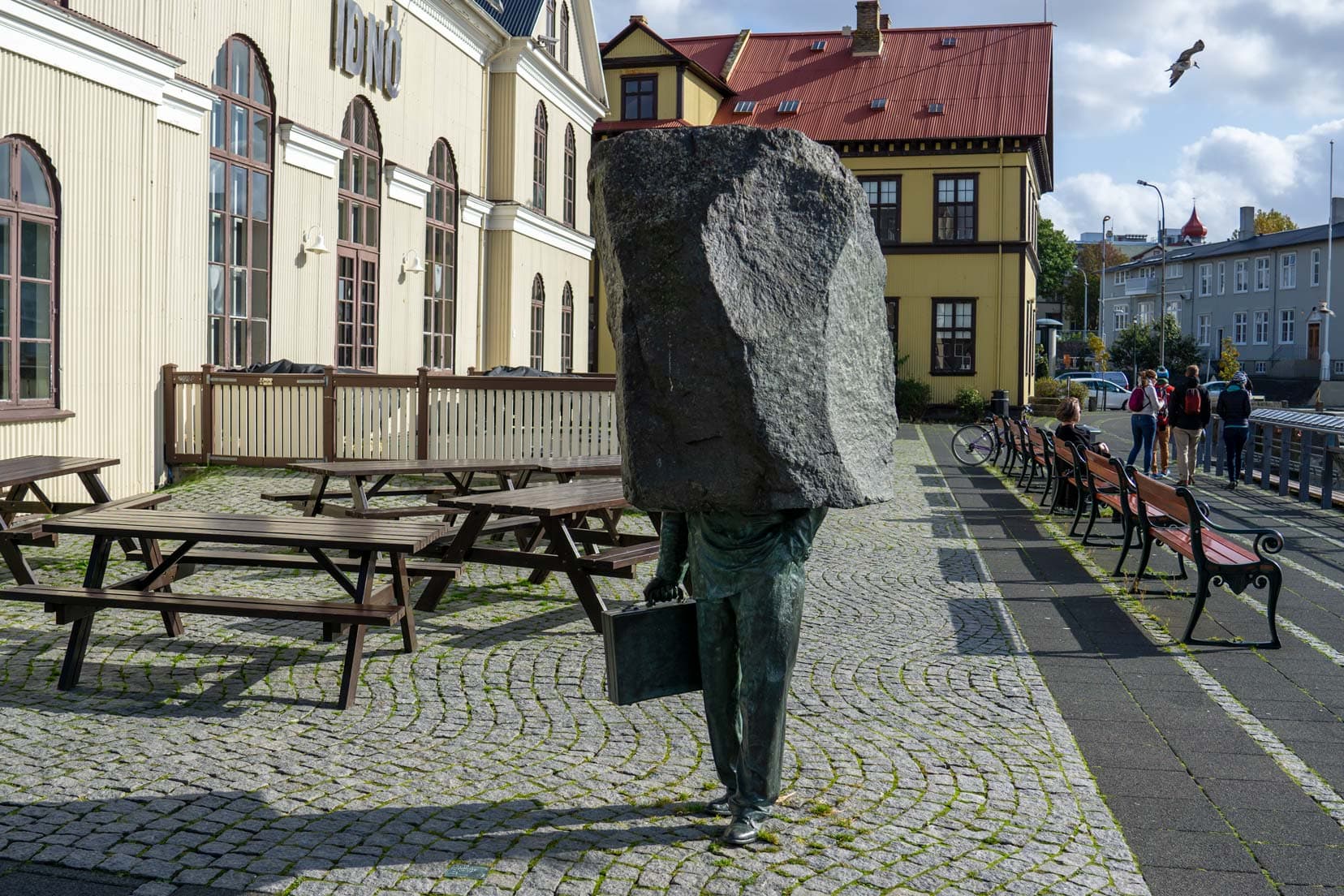
Tjörnin
We escaped downtown Reykjavik to the small lake of Tjörnin. Walking many of the paths brought us face-to-face with interesting sculptures and works of art.
There was plenty of birdlife in and around the lake, so I used my long lens to photograph them.
📸 Photography Tip
A bridge crosses over Tjörnin, offering excellent opportunities for shots of the green-spired Reykjavik City Hall with Hallgrimskirkja in the background.
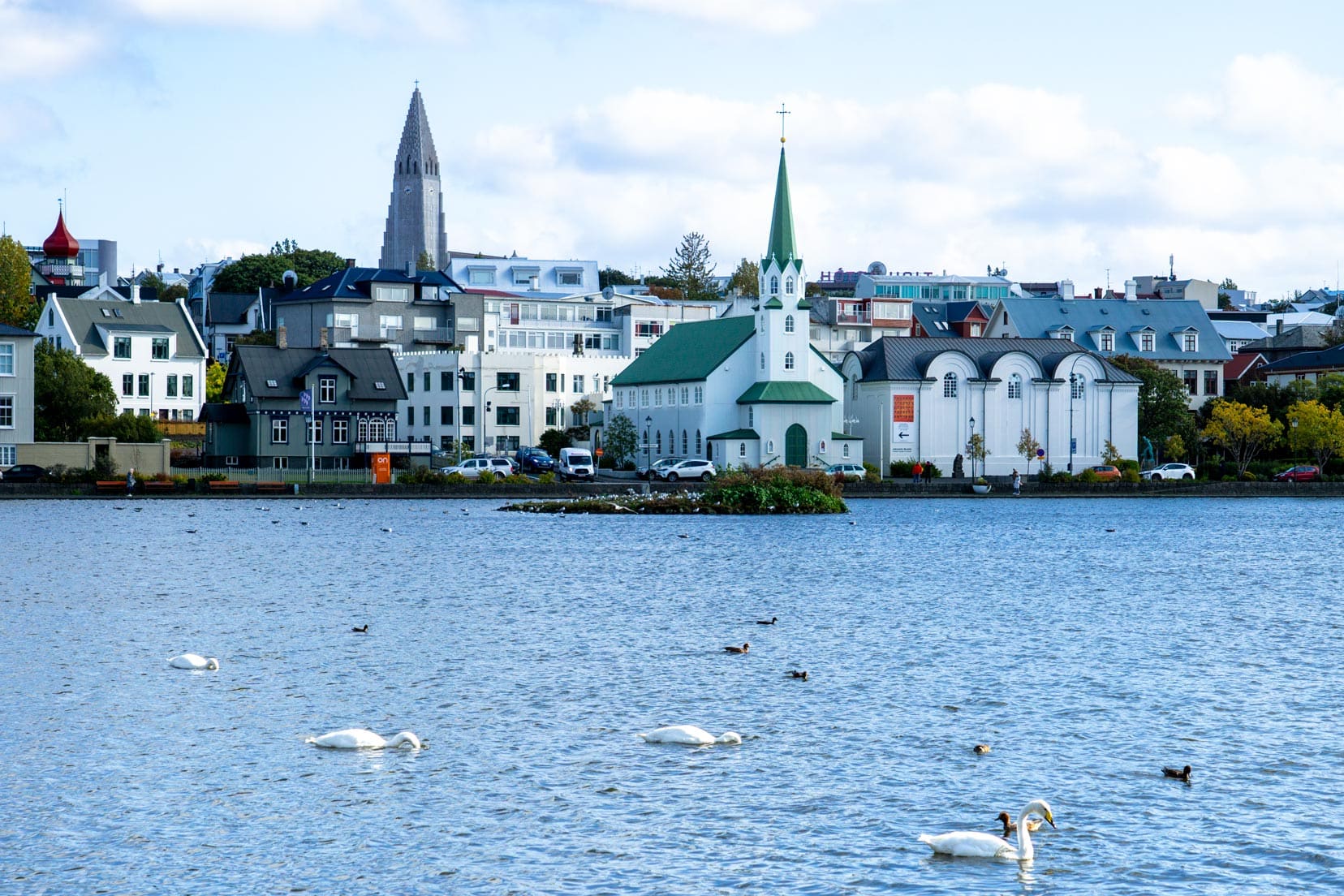
Harbourside Old Fisherman Huts
At Reykjavik harbourside, some old fisherman huts have been renovated into restaurants, arts and crafts shops, design boutiques, souvenir stores and coffee shops. Modern touches that retain the hint of the past.
We found a handy information board at the harbour entrance, which helped us navigate Reykjavik’s Old Harbour.
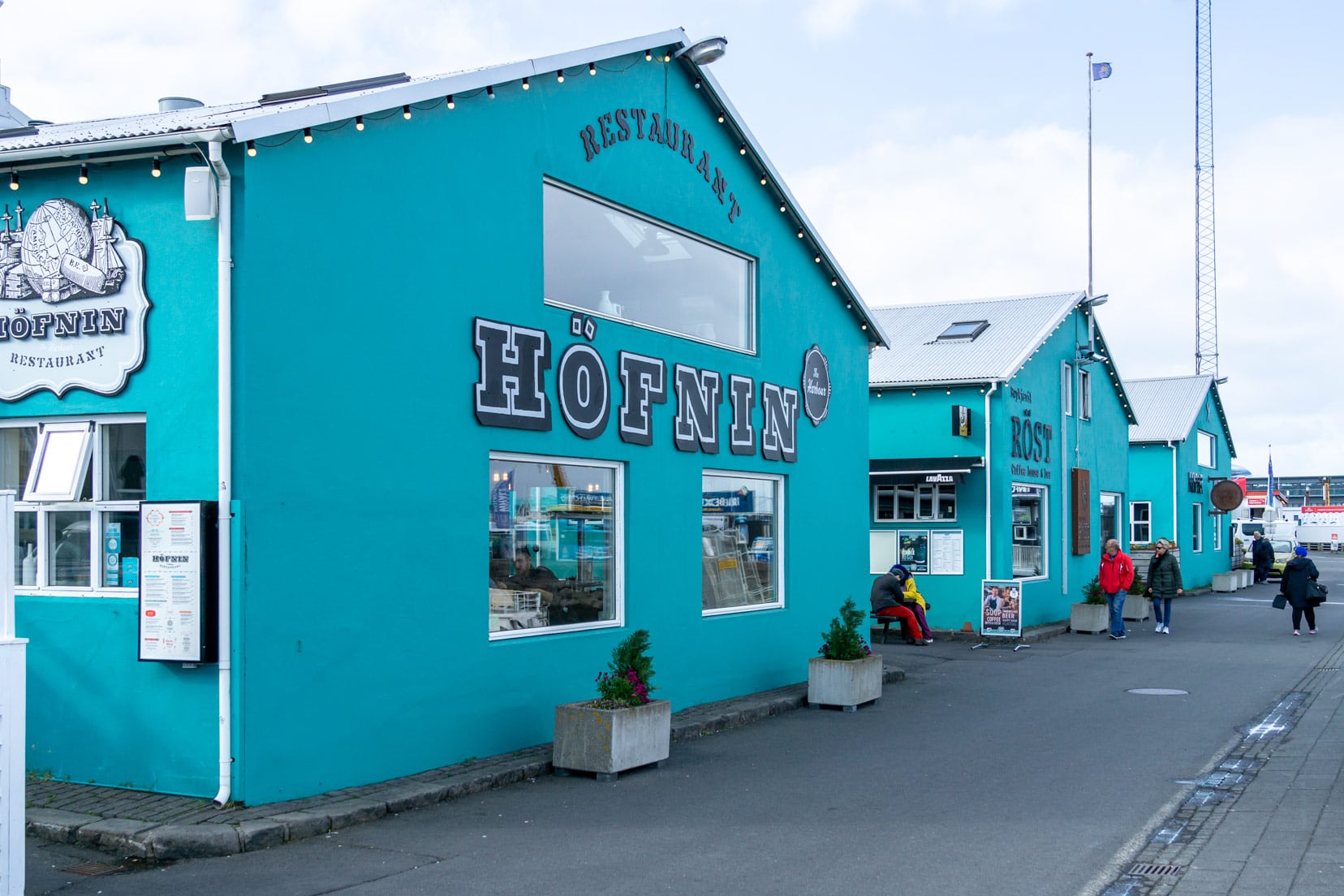
Northern Lights in Iceland
September is the month when the lights begin their mesmerising dance, and I wasn’t going to pass up this opportunity.
From Reykjavik, we drove south to Lake Kleifarvatn and didn’t have to wait long after sunset to get the amazing sightings we hoped for.
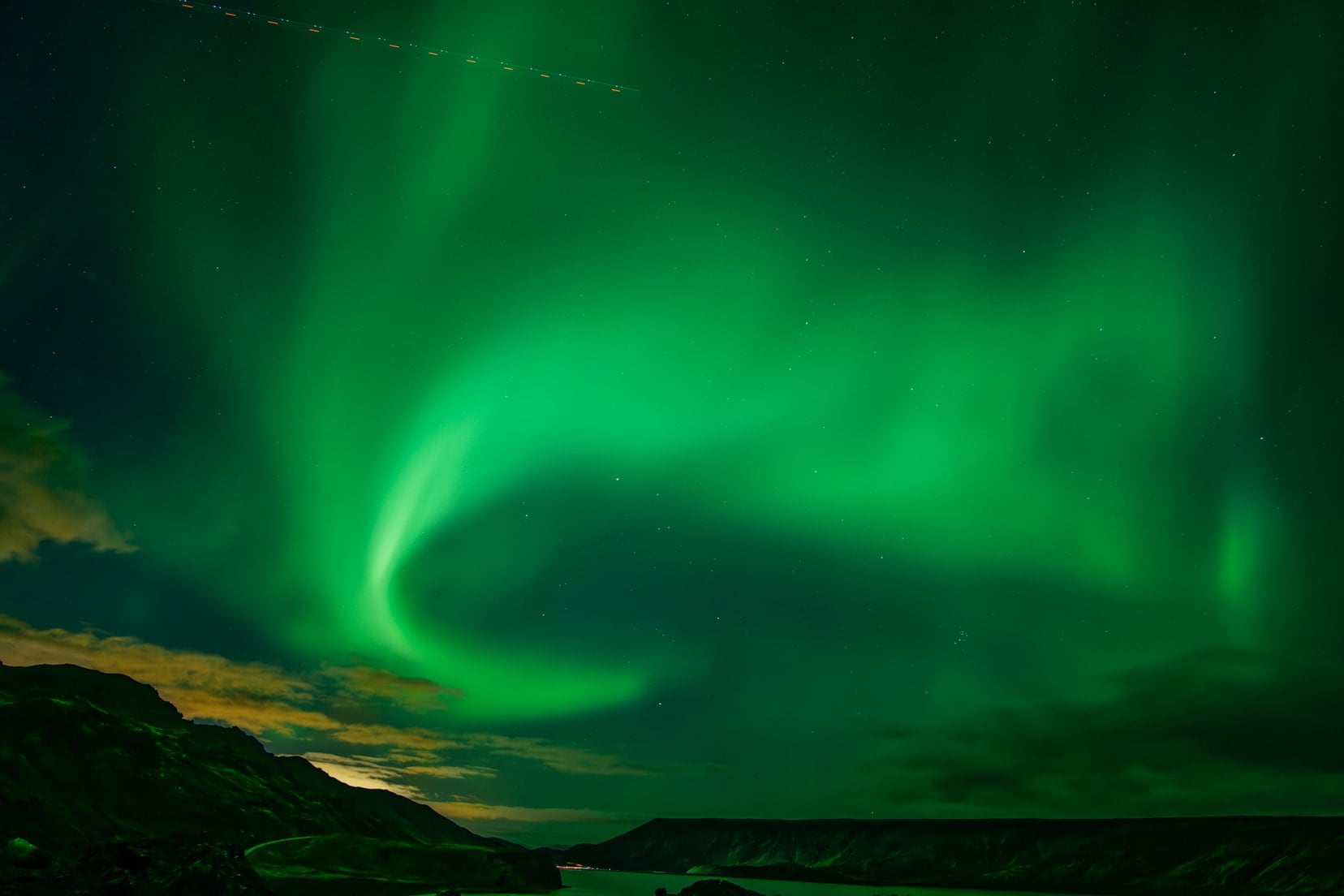
There are a few tools that help predict if the Northern Lights will be visible. I cover this in detail further down in this article.
📸 Photography Tip
Find a location that has minimal light pollution. Having a tripod is a bonus; however, I’ve used the roof of our car. All you need is a stable platform that will keep the camera still for those long exposure shots.
If the northern lights are shifting quickly, exposure times can be reduced. Consider a location with an interesting foreground. In our case, we chose a lake in the hope of capturing the reflections.
We’ve had some fantastic sightings just after sunset, although expect sightings at any time of the night.
Alternative: If you don’t want the hassle of driving at night, then consider joining a Northern Lights tour.
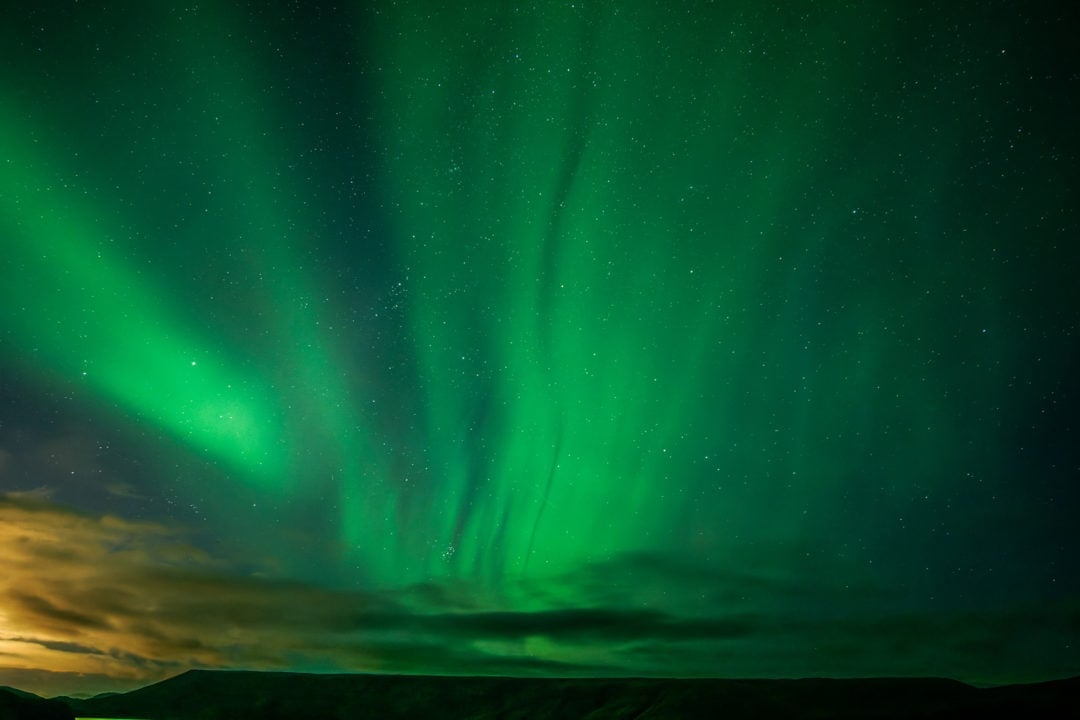
🏆 BEST Northern Lights Tour from Reykjavik with Hot Cocoa
⭐️ Cancel up to 24 hours in advance for a full refund
⭐️ Pick-up included
⭐️ 4.5/5 Star Reviews | Check Availability here
Day 2: Golden Circle Route
🏡 Overnight Accommodation: Skógar
To begin our 14 days, we drove the Golden Circle route, visiting Þingvellir National Park, the Geysir geothermal area, and the Gullfoss waterfall before swinging south to discover more of Iceland.
- Þingvellir National Park / Thingvellir National Park
- Kerið Crater
- Geysir field including ‘Strokker‘
- Gullfoss Waterfall
- Seljalandsfoss Waterfall
Þingvellir (Thingvellir) National Park
Thingvellir National Park is the first stop on the Golden Circle Route and has some impressive geology. The centuries-long tectonic movement has resulted in ravines filled with glacier meltwater.
Get your walking boots on as there are many trails to choose from in the park, and even some abandoned farms named Vatnskot, Hrauntún and Skógarkot can be discovered. Þingvellir (Thingvellir) National Park offers a free hiking map for download.
Þingvellir National Park is a UNESCO world heritage listed site.
Kerið Crater
Kerið Crater, a crater lake, was a volcano that collapsed, forming the crater you see today.
We walked the perimeter of the crater for roughly 20 minutes before descending to the waterline. From its base, you really get the full impression of the crater’s 170m diameter and 55m height.
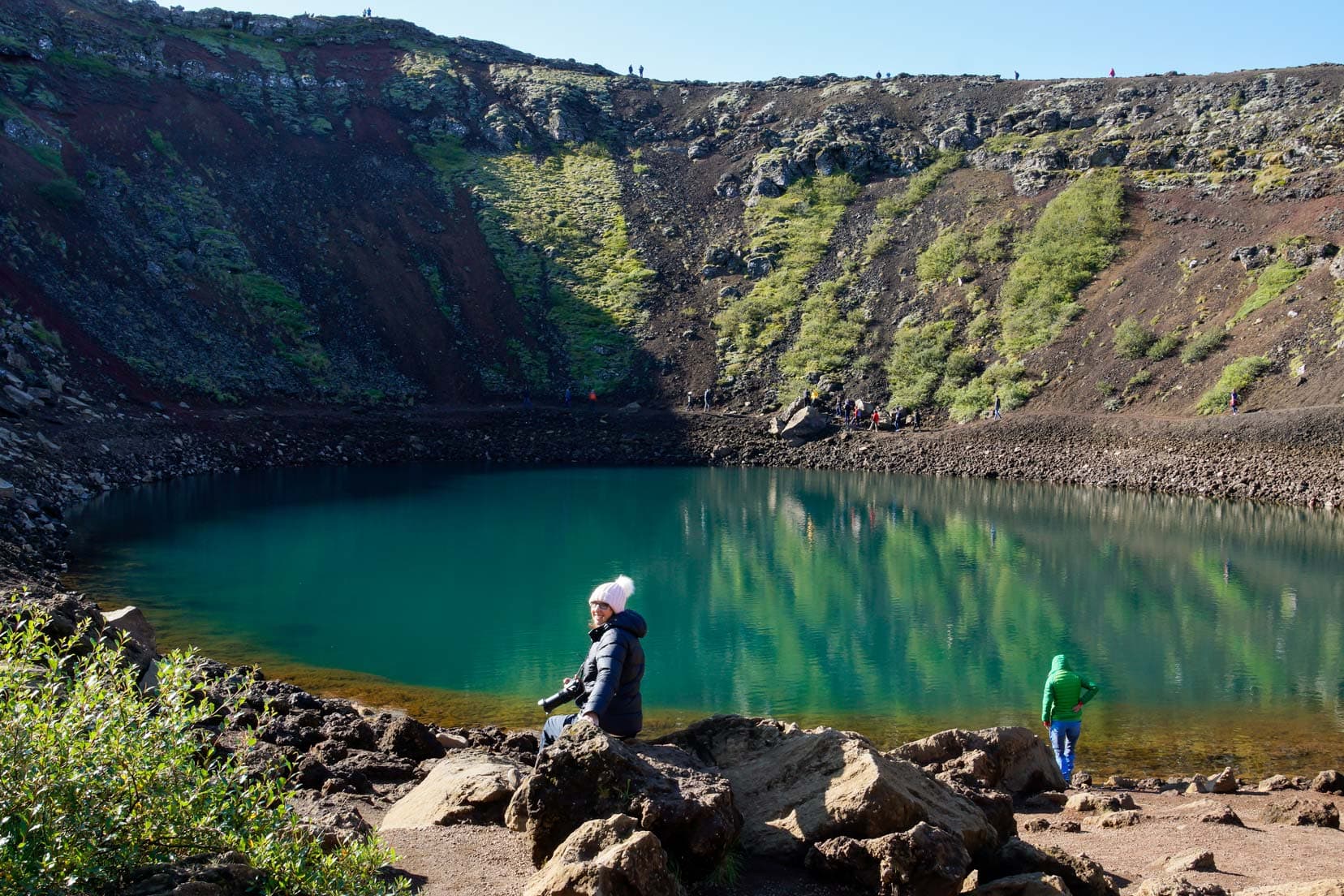
Geyser Field
The Haukadalur Valley, about 100km from Reykjavik, is a geothermal valley with mud baths and two famous geysers, Geyser and Strokkur.
Geyser no longer erupts, but Strokkur is dependable. It erupts every 5 to 10 minutes and has a plume height of 30m.
We spent about an hour wandering the mud baths and timing the eruption to get some decent shots.
The Geyser Centre offers free parking, and for safety, the geysers and hot springs are all roped off.
📸 Photography Tip
To capture the initial burst of the geyser into the air, wait for the big steam bubble to become visible, and then wait about a second.
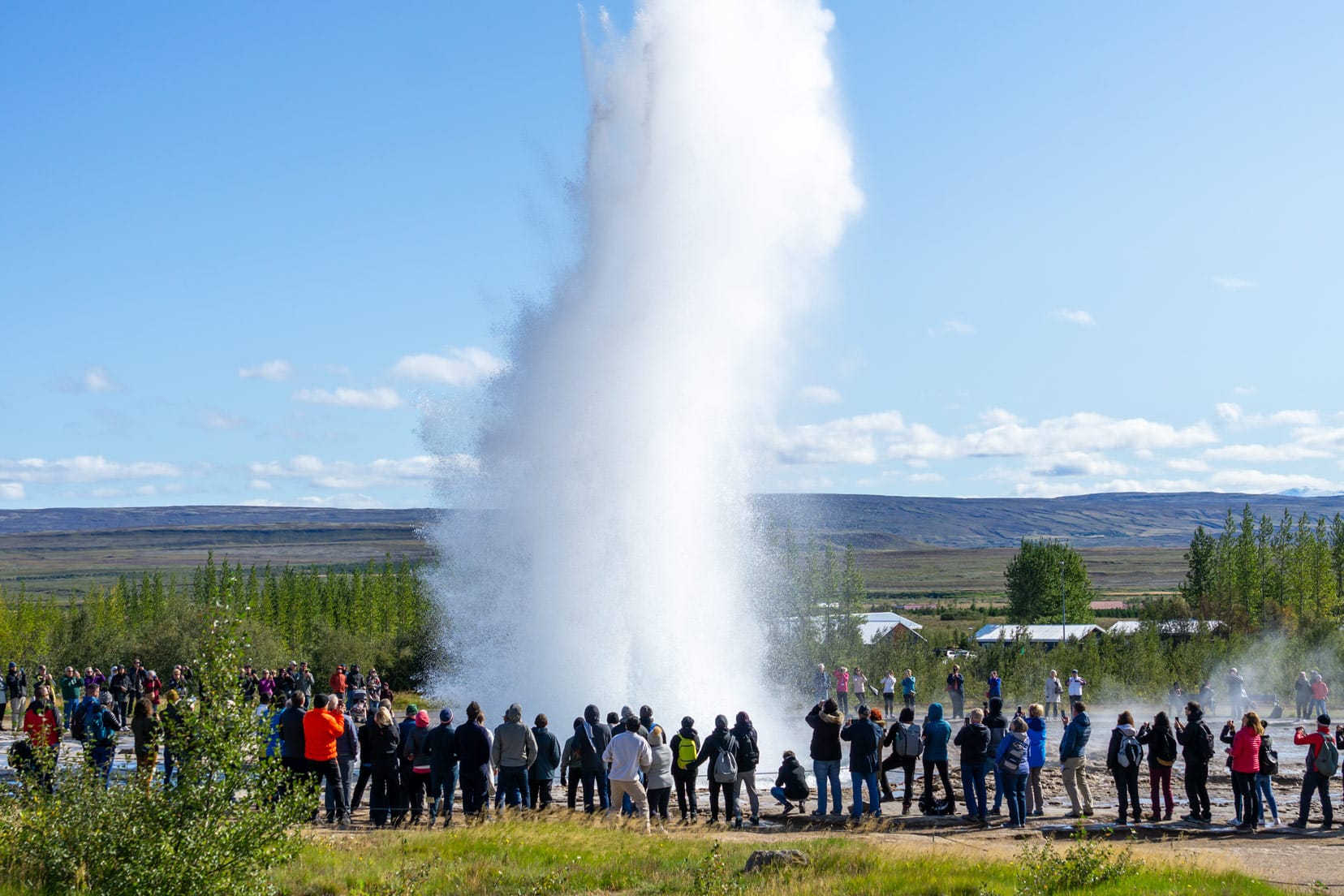
Gullfoss
Gullfoss, Iceland’s most famous waterfall, is located 10km from the Haukadalur Valley.
We followed the path upstream to the water’s edge, where the water drops an initial 11m, then followed it downstream, where it plunges 12m into the Gullfossgjúfur canyon.
Being so close to the water, there is plenty of fine spray, so we ended up a little wet, but nothing too drastic. If you don’t fancy being so close, opt for the lookout views above.
📸 Photography Tip
Due to the amount of mist in the air, I used an Optech rain cover to protect the camera and lens, but you could just as easily use a plastic bag to do the same job.
Also, I found I had to continually wipe my lens with a microfibre cloth as the fine droplets quickly collected.
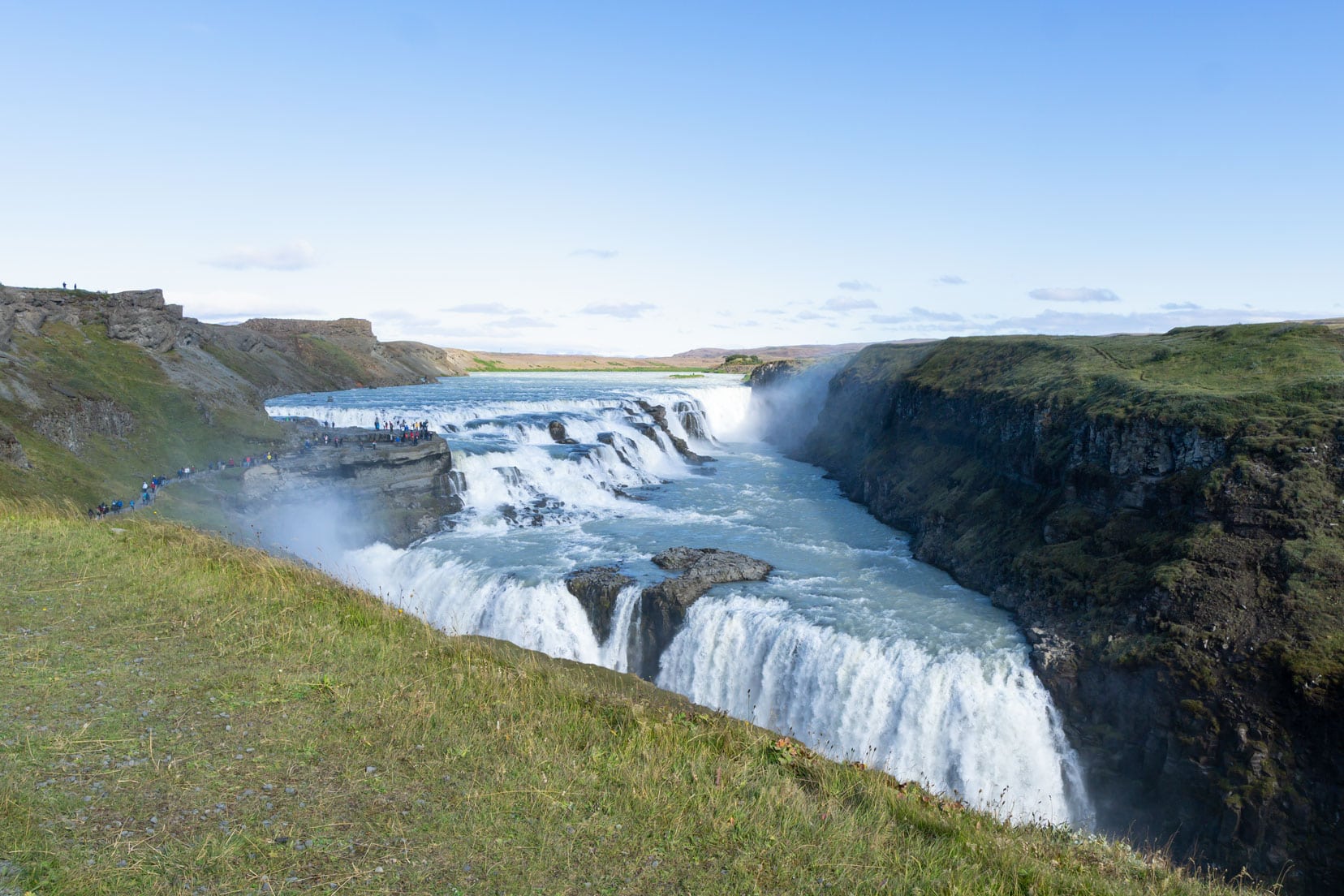
The Golden Circle Road Trip was one of our favourites. Read more on all the other Europe road trip routes that we loved.
Day 3: Vik
🏡 Overnight Accommodation: Skógar
Today is another Waterfall Day!
- Seljalandsfoss waterfall
- Rutshellir caves
- Drangurinn í Drangshlíð (ancient rock dwellings),
- Skógafoss waterfall
- Kvernufoss waterfall
Seljalandsfoss (waterfall)
Seljalandsfoss is a popular waterfall that is visible from the ring road.
What did we love about this waterfall?
You can walk under a rock ledge and behind the waterfall to watch the waters plunge into a pool below. We found it to be one of the most accessible waterfalls we visited.
We recommend you wear waterproofs. There is a parking fee here.
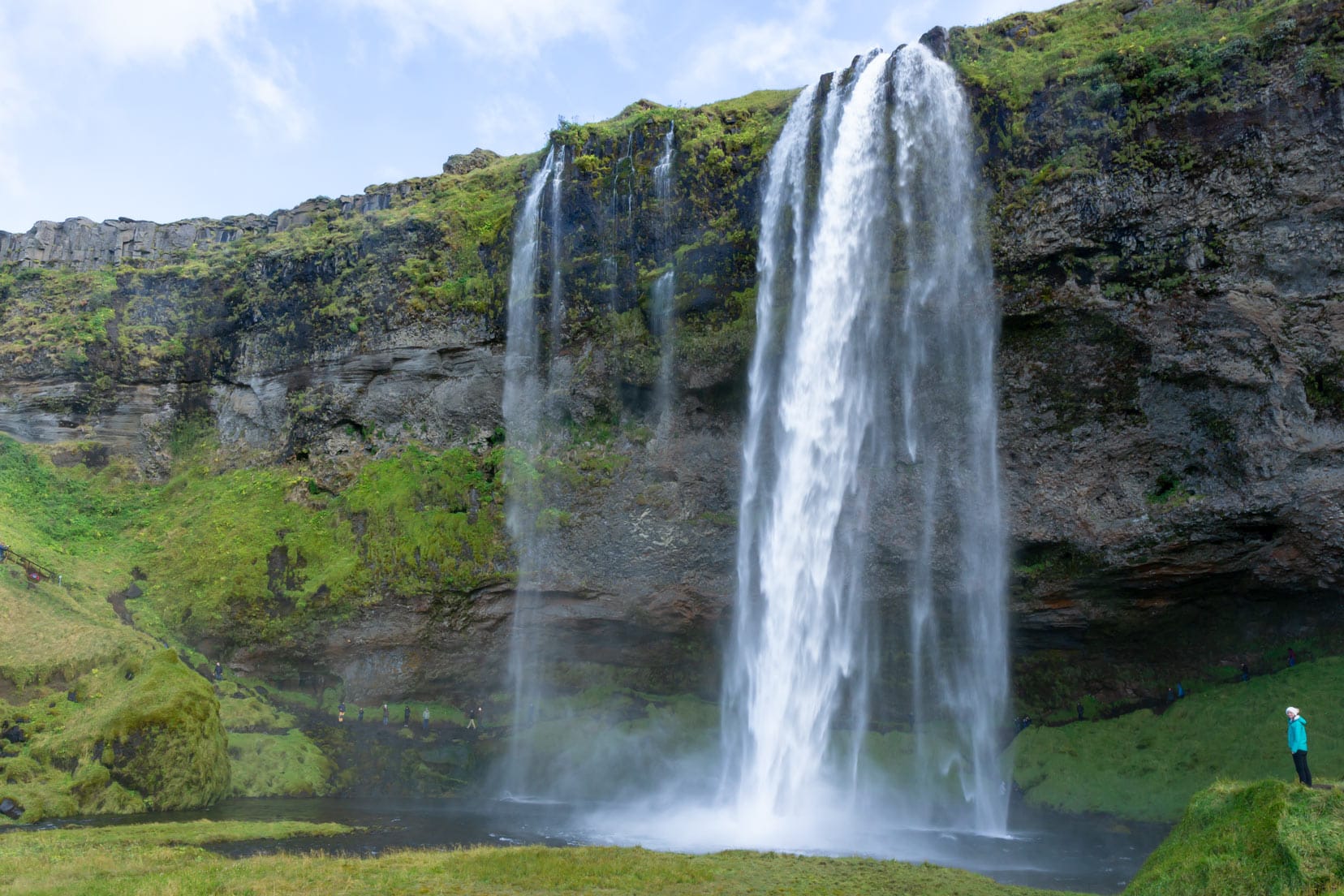
Rutshellir Caves
The Rutshellir Caves are thought to be the oldest place of habitation in Iceland.
The cave entrance is via a stone-walled and grass-roofed annex. It’s certainly a glimpse into the past, showcasing how tough life must have been back then.
These ancient man-made caves are 95km from Seljalandsfoss and are visible from the Ring Road.
Although there is no dedicated parking, we found a small clearing nearby and just off the road. It’s free to enter.
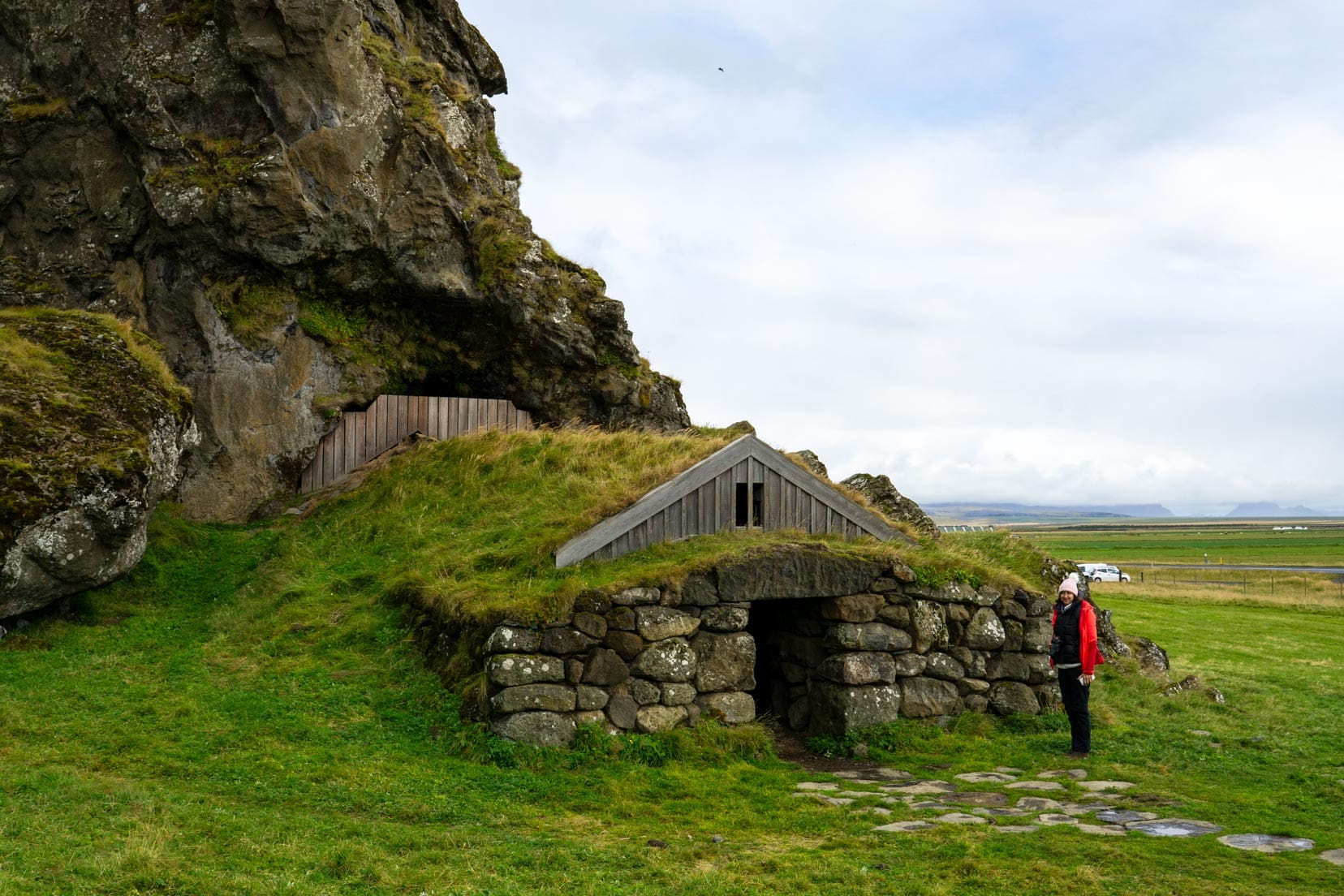
Drangurinn Í Drangshlíð
Sometimes called ‘elf rock,’ Drangurinn is a large solitary volcanic rock on an open field below the beautiful Eyjafjöll mountains. Farmers have used it for centuries to store hay and other implements inside its many caves.
As with many of these Icelandic cave structures, a fable that this cave was also home to elves makes for a much more intriguing story. It’s free to enter; however, you must cross over farming land for close-up views.
We didn’t enter the caves as they were occupied with farming tools.
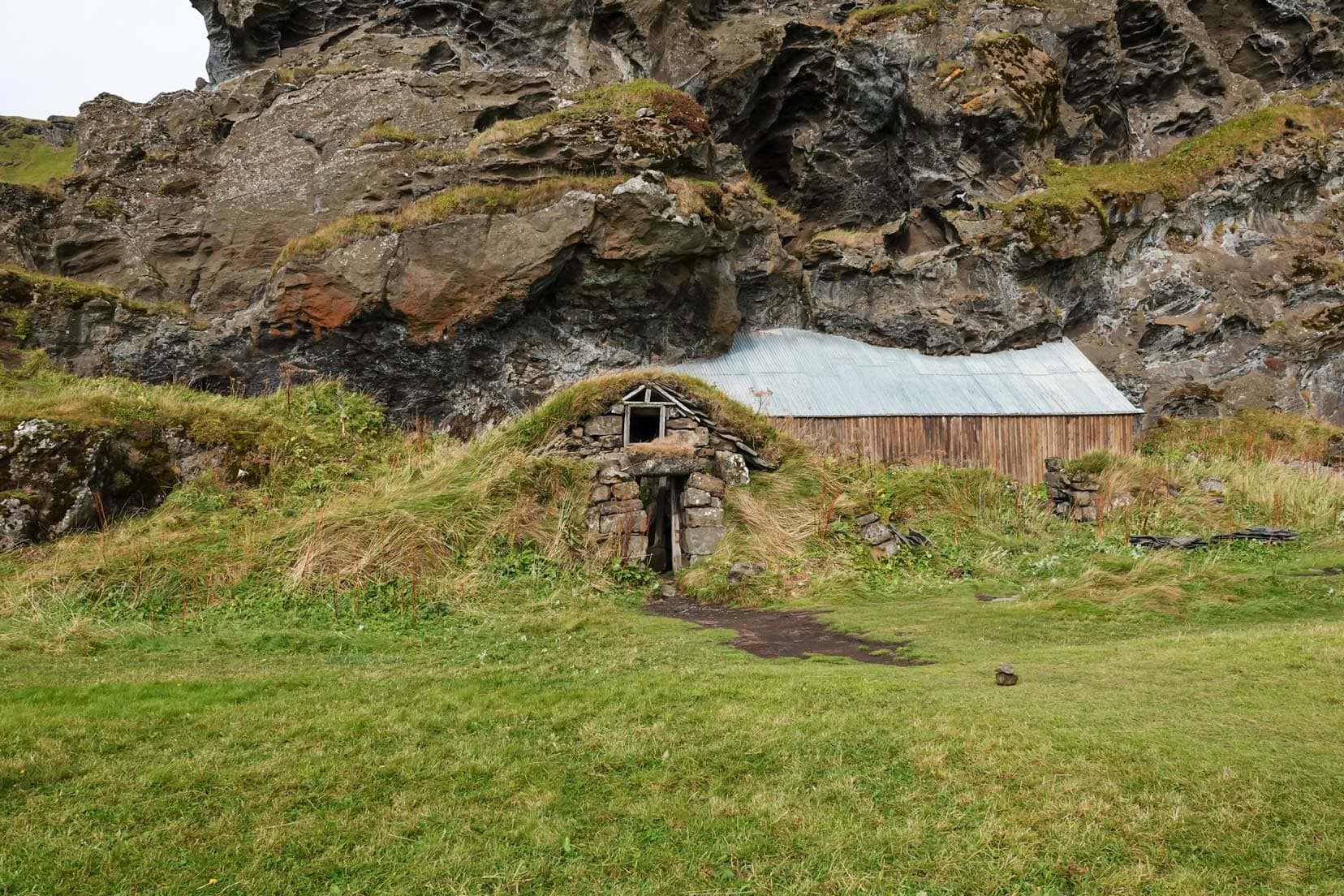
Skógafoss (waterfall)
Skógafoss is a stunning waterfall with a width of 20m and a fall of 60m, just 5km from Drangurinn í Drangshlíð.
You can carefully navigate the wet, stony riverbed to get right up close to the face of this majestic waterfall. Yep, waterproofs will come in handy.
It has easy access and is free. A campsite is just a few hundred metres away.
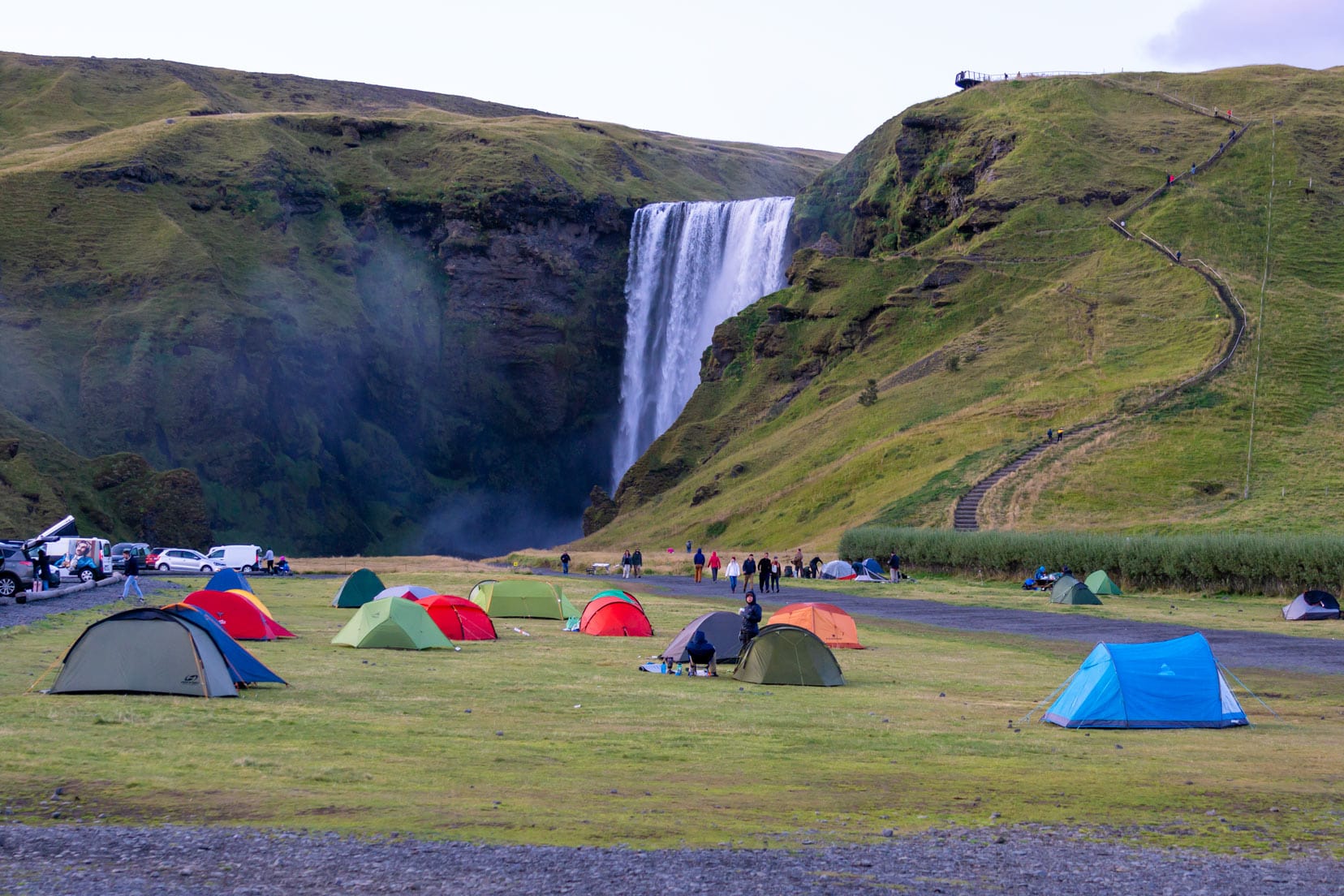
Kvernufoss (waterfall)
Kvernufoss is the understated hero of waterfalls. Tucked away from the road, it cannot be seen. We had to follow a short scenic trail along a river to bring it into sight.
It’s a miniature Skógafoss.
You can access a path to get behind the falls, but be mindful that this is a wet, stony, uneven path that requires careful negotiation. It’s worth the effort, though.
Kvernufoss is 1.5km from Skógafoss and is another free attraction.
Day 4: Vik
🏡 Overnight Accommodation: Höfn
- Sólheimasandur plane wreck
- Dyrhólaey (rock arch in the sea)
- Reynisfjara Beach
- Basalt sea stacks
Sólheimasandur Plane Wreck
On the open black lava plains in remote South Iceland lies the Sólheimasandur plane wreck.
It is a desolate spot.
A US Navy Douglas C-117 plane crashed in November 1973 after running out of fuel. Luckily, there were no casualties.
We walked 45 minutes on the flat but stony ground to reach the plane from the carpark. However, there is the option to pay for a shuttle ‘bus’.
This ‘bus’ was a Russian missile carrier in another life. It operates between 10 am and 5 pm.
📸 Photography Tip
Consider capturing the desolation by including the lava field, distant mountains, and plane wreck. A black-and-white image can work well.
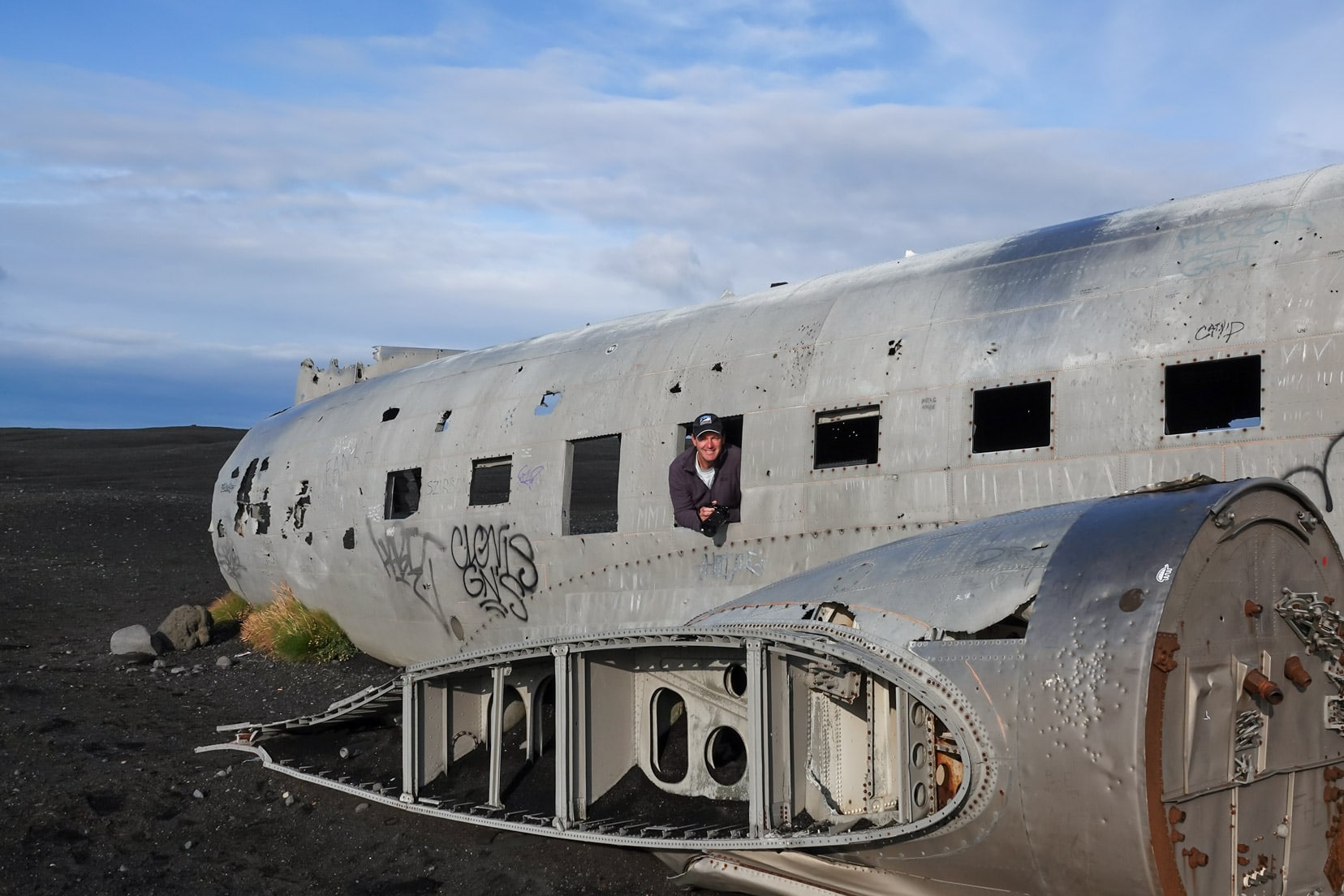
Dyrhólaey
Dyrhólaey translates to ‘door hole’, a fitting description of the 120-meter-high rock arch that forms part of a small promontory in Iceland’s southernmost part.
When the weather is calm, small boats can pass through the opening. We needed to park and walk to a lookout to see this. This car park also provides the closest access to Reynisfjara Beach.
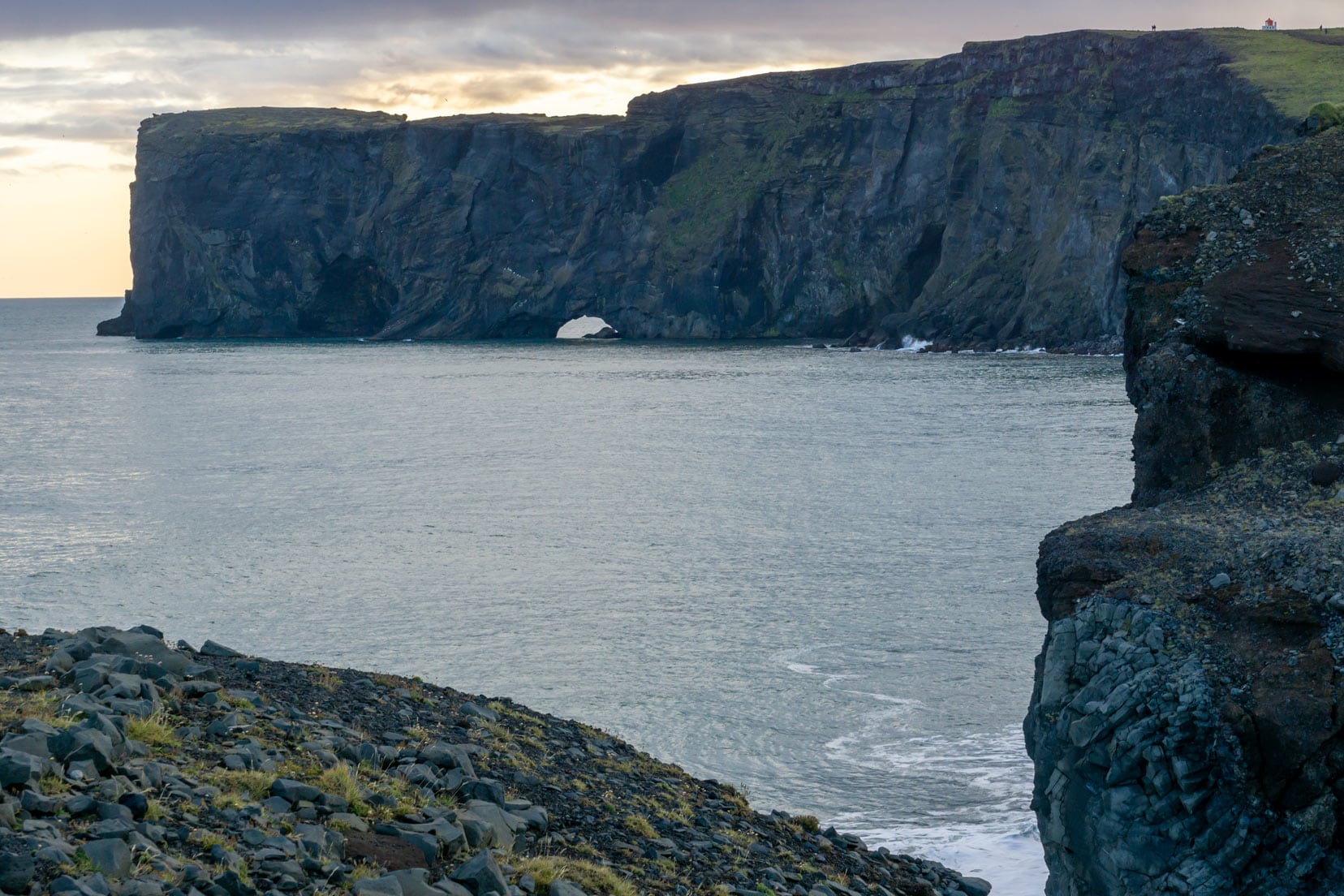
Reynisfjara Beach
Known for its stunning volcanic black sand beach and spectacular basalt columns, Reynisfjara Beach has been listed as one of the top ten non-tropical beaches in the world.
Unfortunately, Reynisfjara Beach access was closed during our visit due to the prevailing heavy seas, which prevented us from walking down onto the beach. We were certainly disappointed, but you can’t argue with Mother Nature.
The lookout offered great views of Reynisfjara Beach and the lone basalt sea stack, Arnardrangur, sometimes called Eagle Rock.
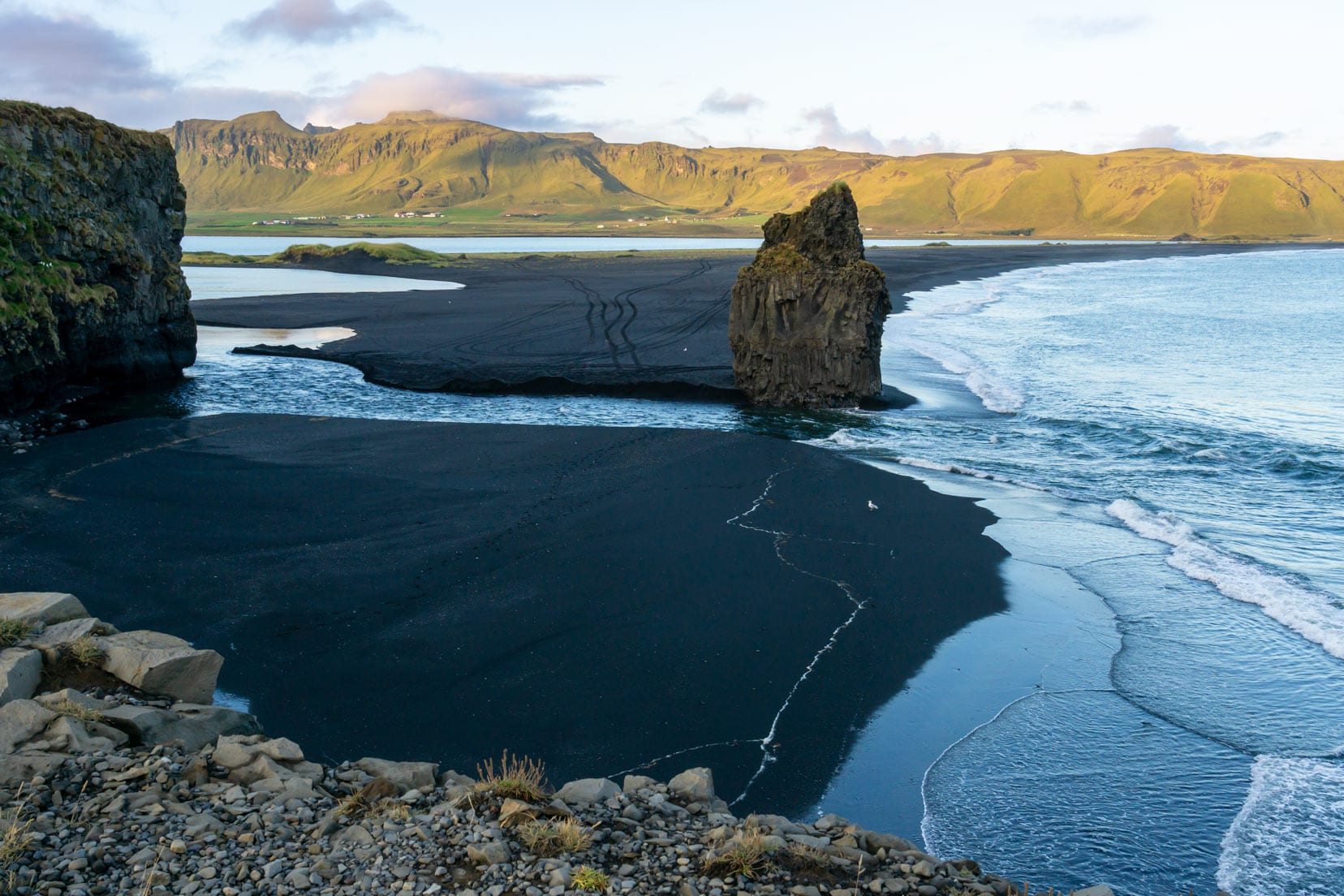
📸 Photography Tip
My plan was to use an ND filter on my lens to slow down the receding waters on Reynisfjara Beach for a silky white effect against the contrasting black volcanic soil.
Day 5: Höfn
🏡 Overnight Accommodation: Höfn
- Hofskirkja
- Svartifoss, Magnúsarfoss, Hundafoss waterfalls
- Jökulsárlón Glacier Lagoon and Jokusarlon Glacier Lagoon
- Diamond Beach
Hofskirkja
Hofskirkja, on the eastern coast, 150km from Vik, was the last of the six turf churches built in the late 19th century.
How was a turf church built? First, huge stones were placed down as a foundation, then the wooden structure was built on top, and finally, turf was fitted to the frame.
This method is quite similar to Norway’s famous Stave churches.
The grass mounds you can see on the church grounds are actually old burial mounds.
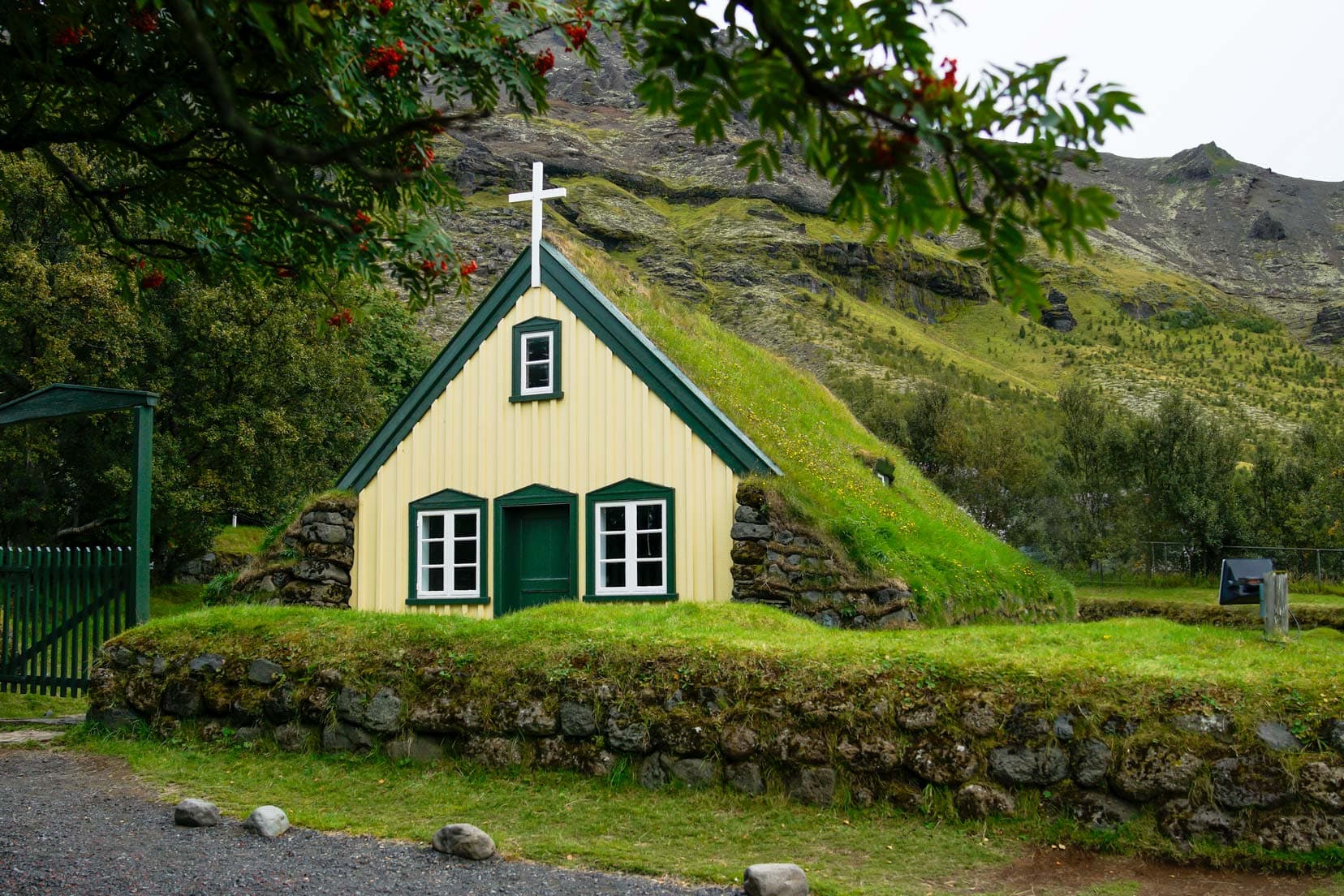
Svartifoss, Magnúsarfoss, Hundafoss Waterfalls
The three waterfalls of Svartifoss, Magnúsarfoss and Hundafoss are located in Vatnajökull National Park, within close proximity of each other.
If you wanted to visit just one, Svartifoss would be it, with its distinctly hexagonal basalt columns that fringe the canyon walls. However, we soon realised that to reach Svartifoss, you must pass by the other two waterfalls anyway.
The views of Magnúsarfoss and Hundafoss are partial, so they didn’t impress us much, and these two really are a sideline act to Svartifoss.
An easy walking path makes the 3.0km round trip fly by. There is a visitor centre near the paid car park.
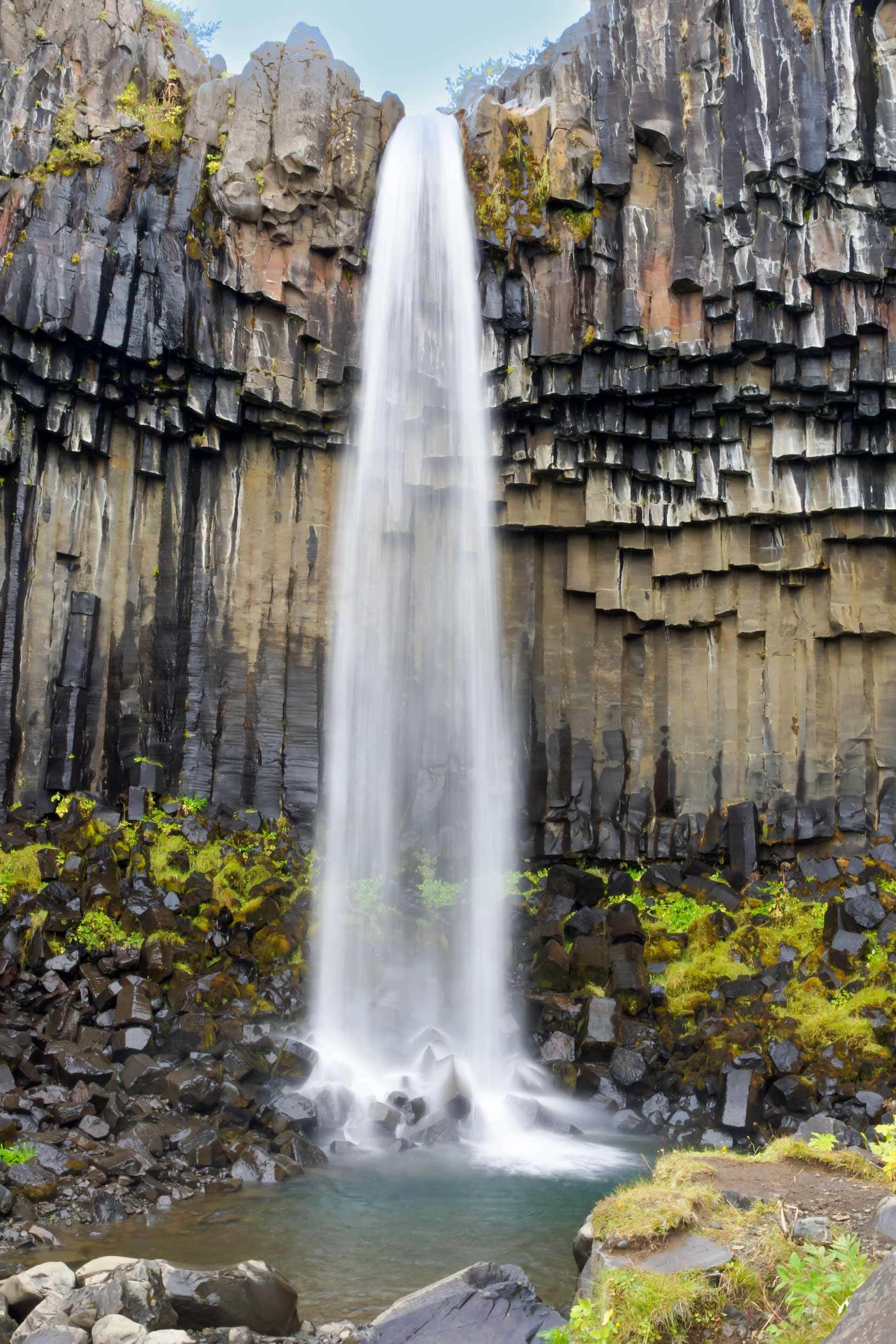
Jökusárlón Glacier Lagoon
Jökusárlón Glacier Lagoon is a large glacial lake in south-eastern Iceland, within the Vatnajökull National Park region. It is one of the most beautiful sights in Iceland and is on our list of favourite attractions.
You can view large, multi-coloured icebergs that have splintered from the Breiðamerkurjökull glacier tongue and drifted slowly down to the sea.
It is a stunning sight.
📸 Photography Tip
Consider capturing the Breiðamerkurjökull glacier tongue with a foreground of multi-coloured icebergs to tell the story.

Diamond Beach
Diamond Beach sits between the Jökusárlón Glacier Lagoon outlet and the sea.
It has earned its name from the small ‘bergs that wash up on the black lava beaches. The contrasting colours are magnificent. It is the most beautiful sight.
📸 Photography Tip
A popular shot is to capture an interesting-shaped iceberg on the obsidian-coloured lava with the crashing surf in the background. Or, a long exposure shot of the receding water around the ‘berg that creates a soft, dreamy effect.
You’ll need a tripod and ND filter.
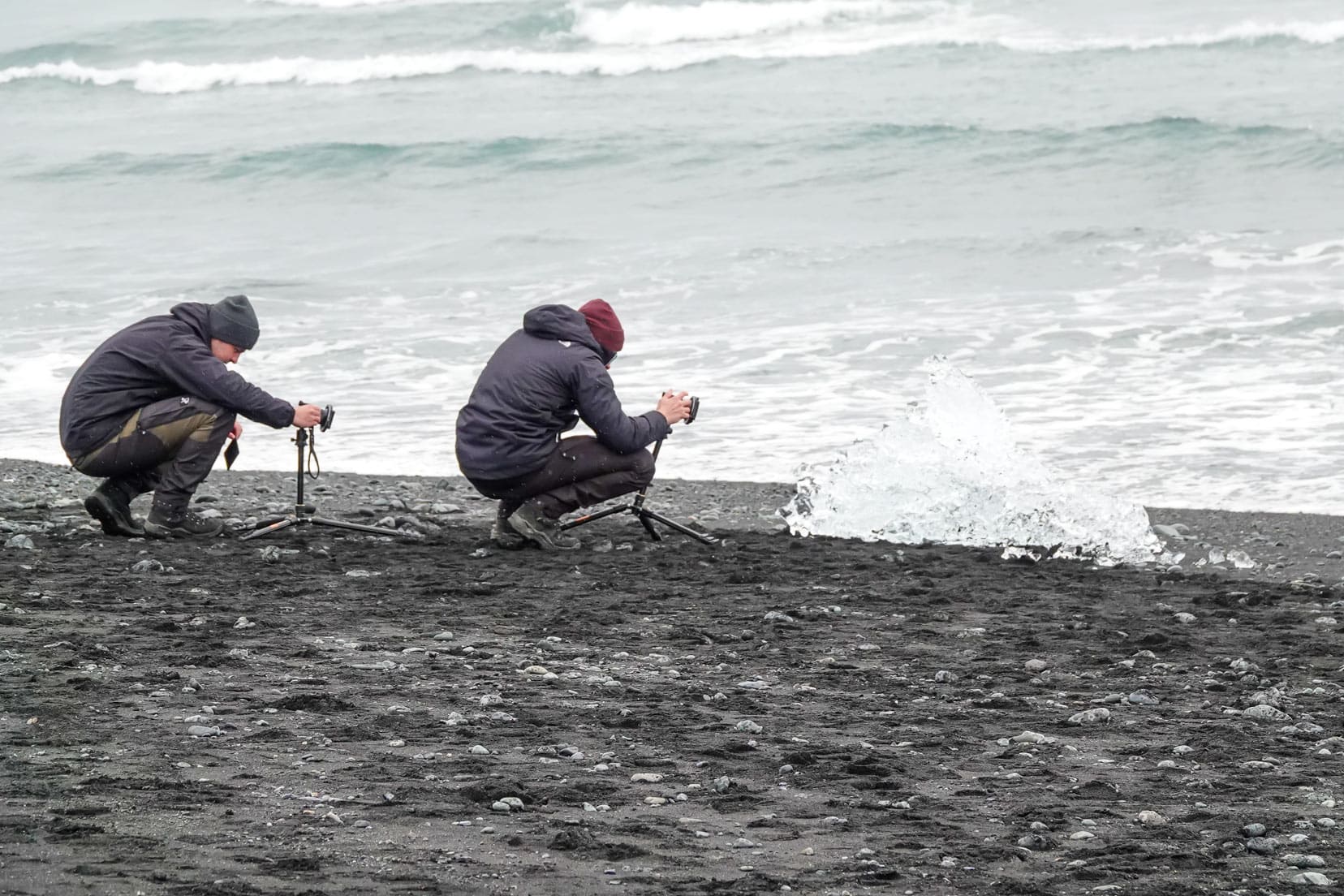
Day 6: Höfn
🏡 Overnight Accommodation: Egilsstaðir
- Hvalnes Nature Reserve Beach and Hvalnes Lighthouse
- Eggin í Gledivik egg sculptures
- Hafnarnes Lighthouse
Hvalnes Nature Reserve Beach and Hvalnes Lighthouse
The long black lava rock beach heralds the beautiful Hvalnes Nature Reserve Beach. With the majestic Eystrahorn mountain to the north and the relentless Norwegian Sea to the east, this stretch of the beach creates a distinct divide.
The orange-coloured Hvalnes lighthouse, which overlooks the beach, was built with a curved frontage.
📸 Photography Tip
Wonderful landscapes surround this location. The lighthouse’s views over the sweeping Hvalnes Nature Reserve Beach are enticing for photographers.

Eggin Í Gledivik
We thought the Eggin Í Gledivik, an art piece consisting of 34 granite ‘eggs’ perched on small concrete pedestals, was quite the spectacle.
Lining a quiet harbour a kilometre outside of Egilsstaðir, it is often overlooked.
I thought the eggs would be quite small; however, each is about a metre in length. The eggs represent the 34 bird species that nest in the area.
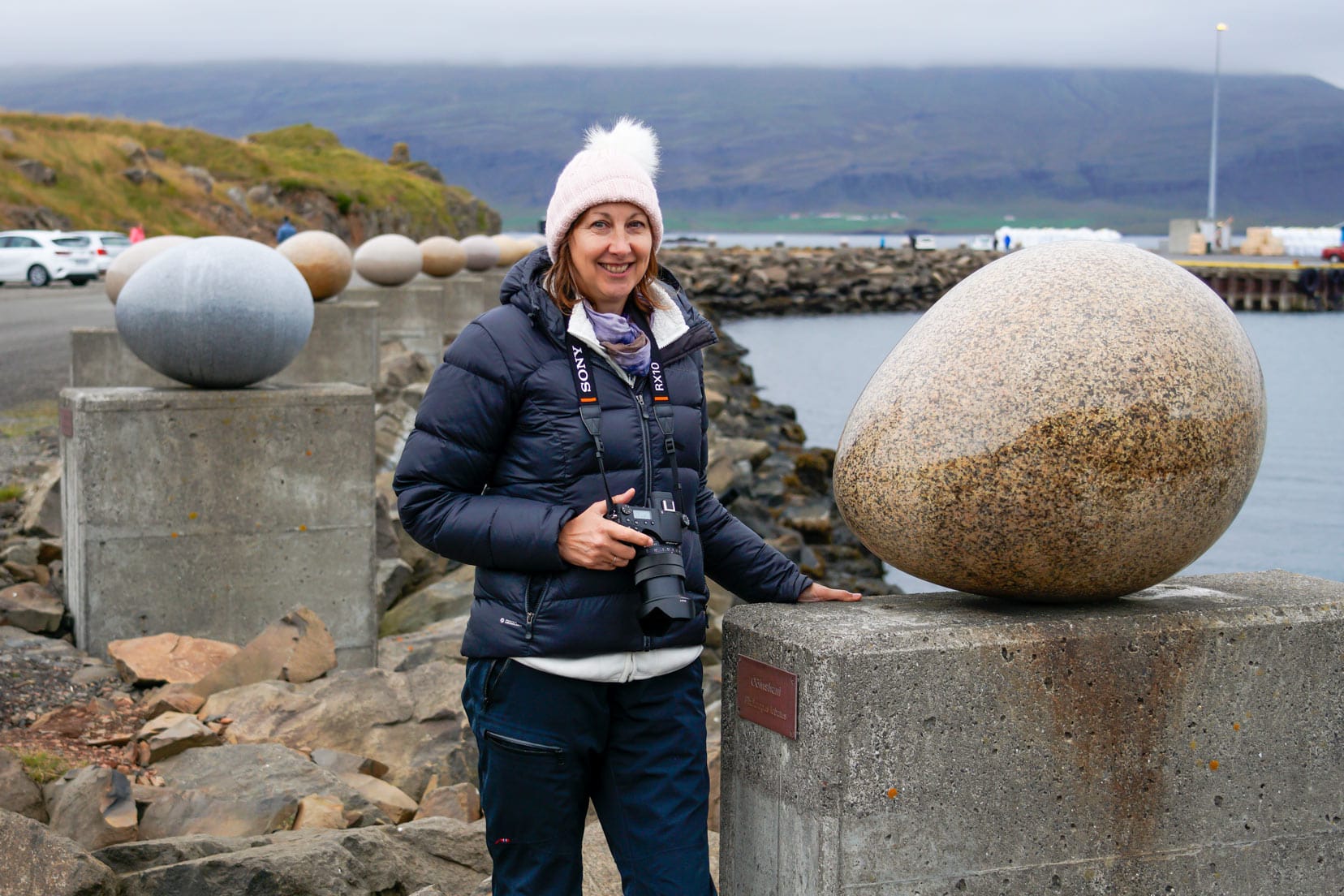
Hafnarnes Lighthouse
The quaint Hafnarnes lighthouse, located close to the cliffs on the south side of Reyðarfjörður, is painted orange, as are many of Iceland’s lighthouses.
You’ll need to park your car near the road by some abandoned buildings and walk the 150m down to the lighthouse.
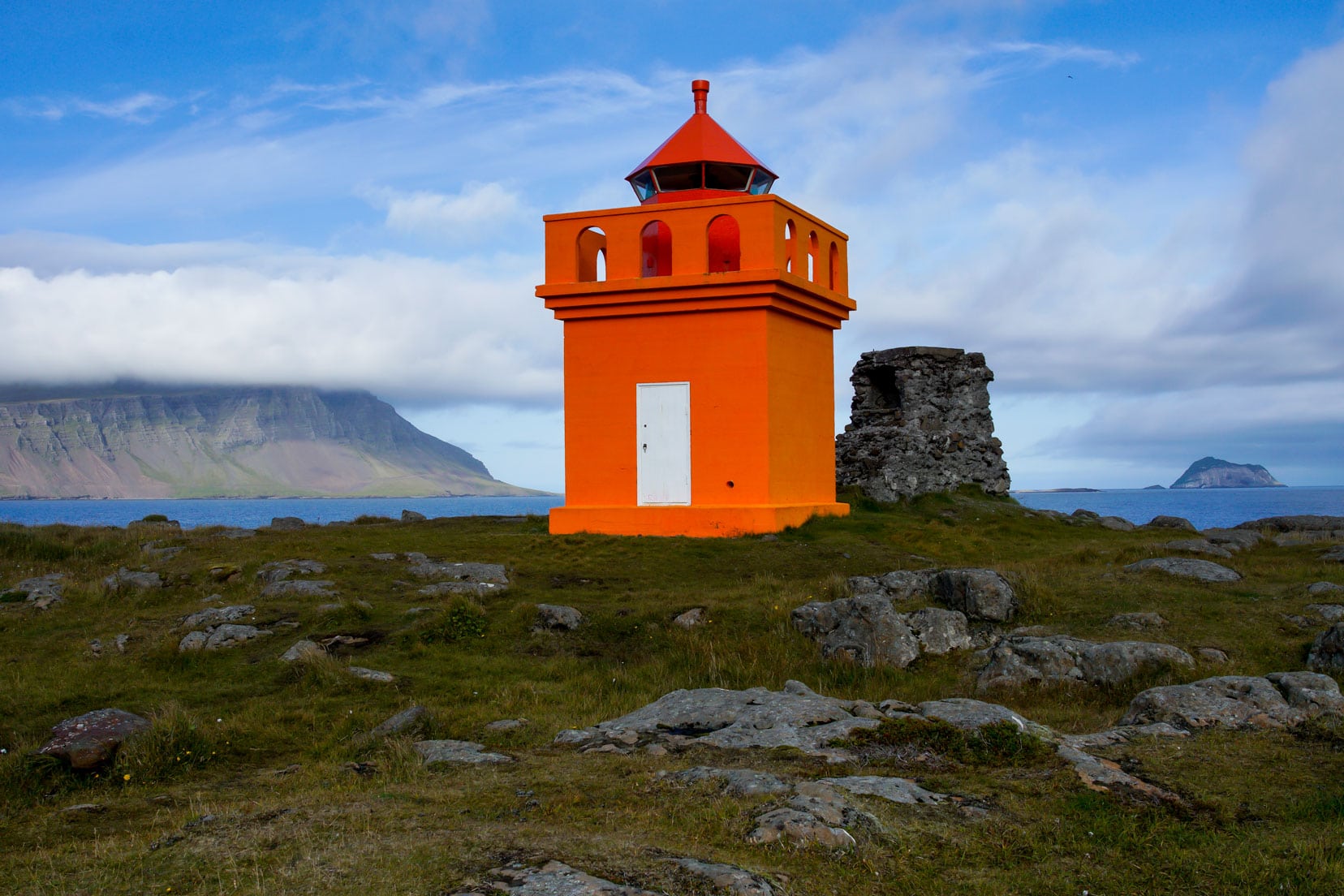
Day 7: Seydisfjordur
🏡 Overnight Accommodation: Egilsstaðir
- Seyðisfjörður
- Seydisfjordur Blue Church
- Seyðisfjörður Rainbow Road
- Geirastadakirkja
Seyðisfjörður
Seydisfjordur, an inviting town in eastern Iceland, is full of vibrant colours and funky artistry. A welcome surprise.
The fjord’s shores are lined with colourful buildings, and you get the feeling that you can expect something special here. You sure do.
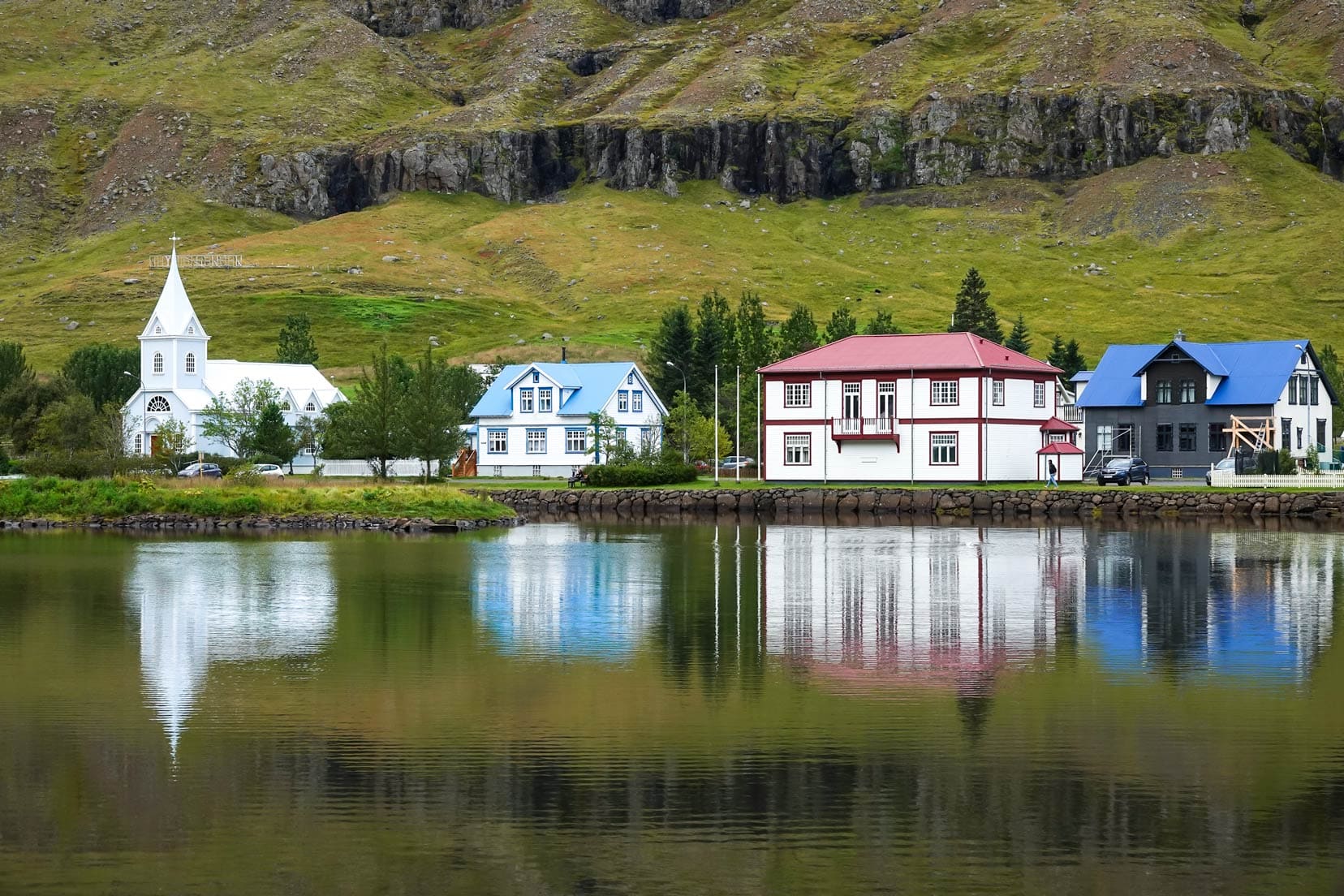
Seydisfjordur Church
This distinctive blue and white Seydisfjordur church (Seyðisfjarðarkirkja in Icelandic) has had a challenging journey. Having been moved, blown over, and rebuilt, it now finds a safe haven close to the protected shores of Seyðisfjörður.
This pretty and architecturally interesting church was consecrated in 1922.
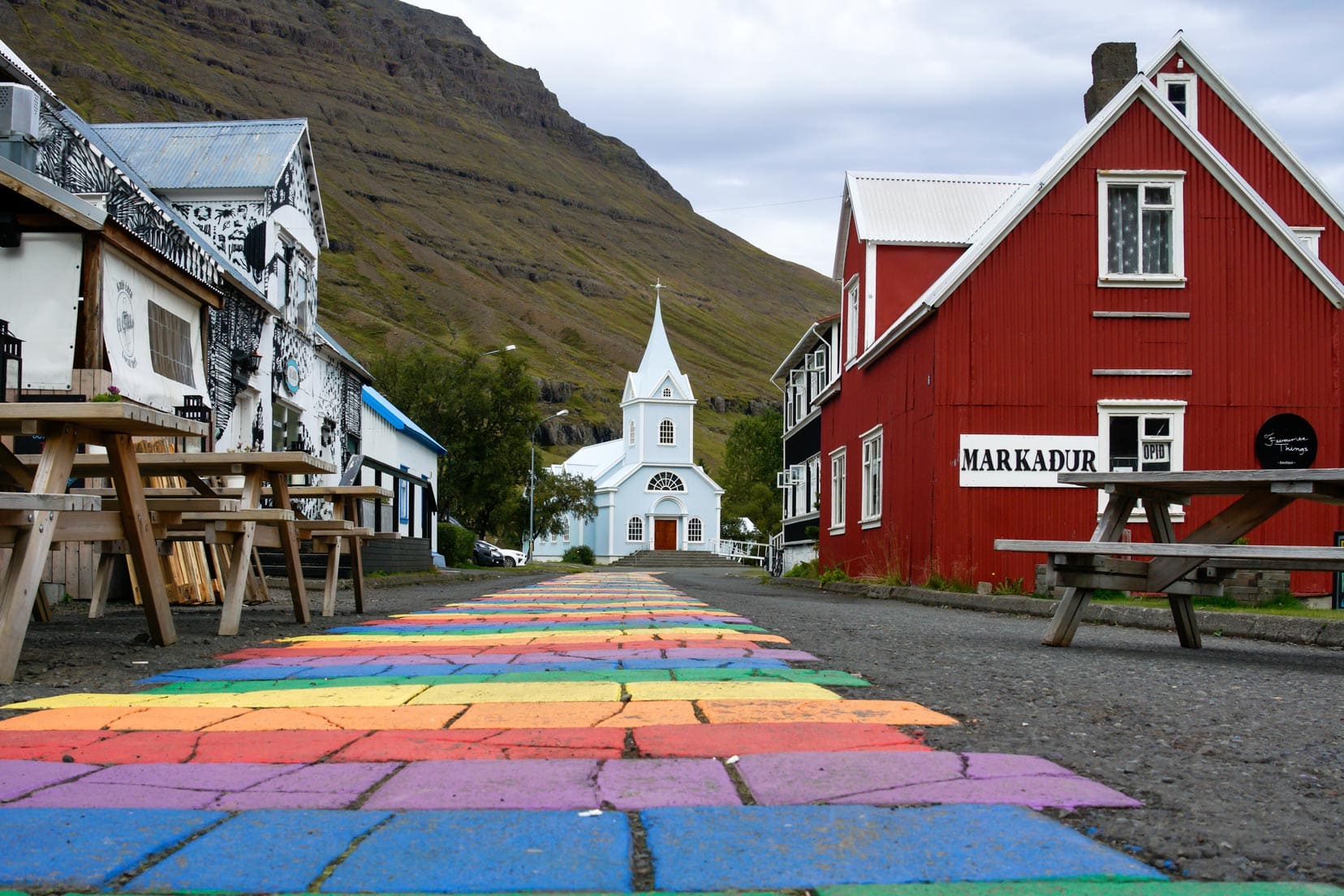
Rainbow Road of Seydisfjordur
An interesting back story to the inception of the Rainbow Road.
The residents of Seydisfjordur came together to revive the run-down street, Norðurgata. Part of this revival was to paint the now rainbow-hued brick road running down the street and through the centre of Seyðisfjörður.
Not only is this attractive, but reflects the town’s show of support for its LGBTQi locals.
We saw on either side of the rainbow-coloured path that the buildings were covered with all sorts of interesting and colourful wall art.
Geirastadakirkja
Geirastadakirkja is a reconstructed turf church modelled on one of the turf churches unearthed in the area. It sits on private land approximately 60km northwest of Seyðisfjörður.
A public road runs beside the church, providing access via a dedicated gate. We visited this New Age turf church only because it was close to our route and, for us, was not a significant attraction; however, you may find it interesting.
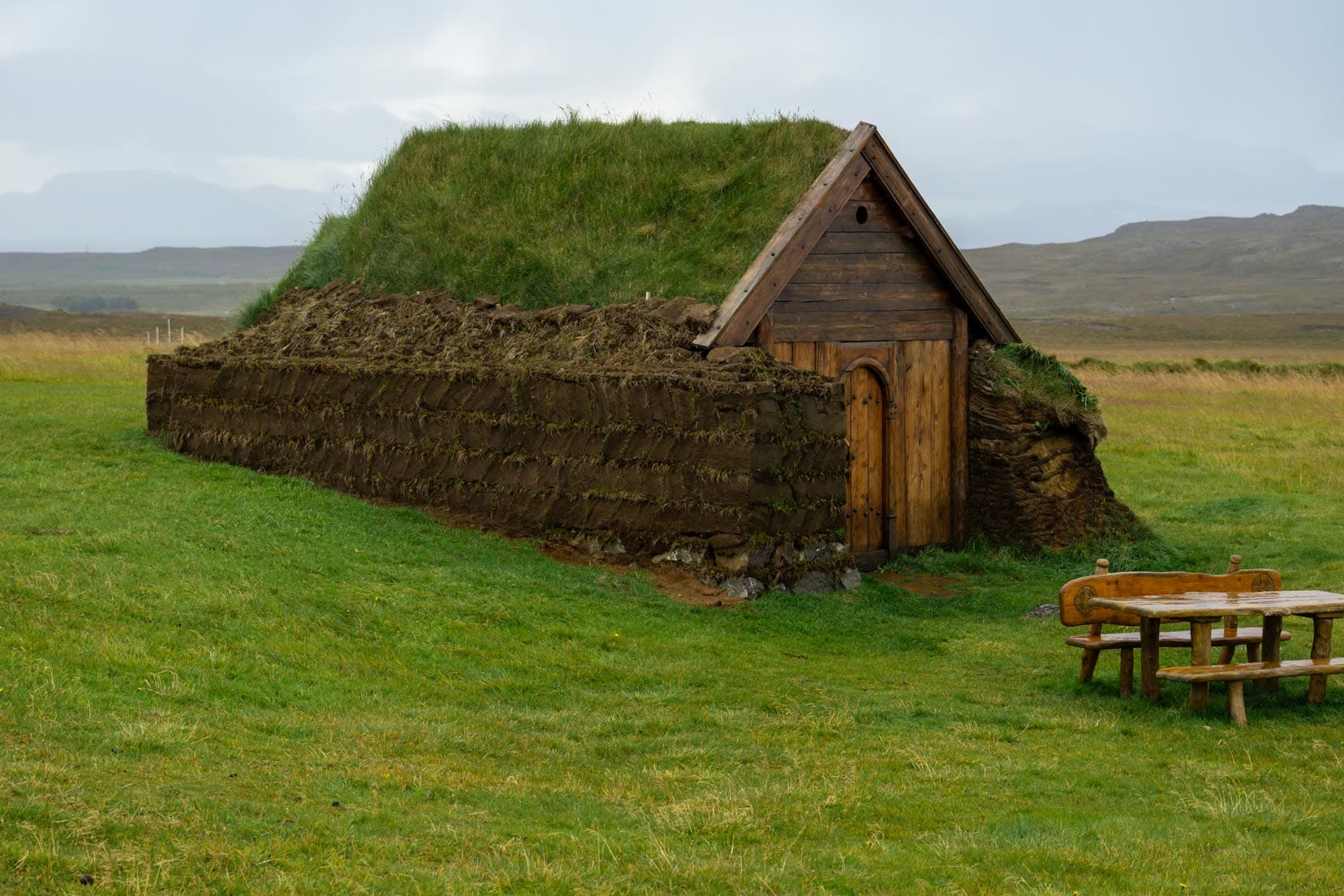
Day 8: Akureyri
🏡 Overnight Accommodation: Akureyri
- Detifoss waterfall
- Selfoss waterfall
- Asbyrgi Canyon
- Hverir lava fields
- Grjótagjá Cave
- Myvatn Lake
- Goðafoss waterfall
Detifoss (waterfall)
Detifoss is impressive; spanning a mighty 100m with a fall of 44m. No wonder it has acclaimed the title as Europe’s second most powerful waterfall.
The thundering applause from Detifoss’ frenzied waters can be heard hundreds of metres away.
There are two parking options at Detifoss: on either side of the river. We chose the west-side parking as it was a better fit for our itinerary and was also a closer walk to Detifoss.
📸 Photography Tip
With plenty of water spray in the air, shots may need to be taken some distance back from the falls.
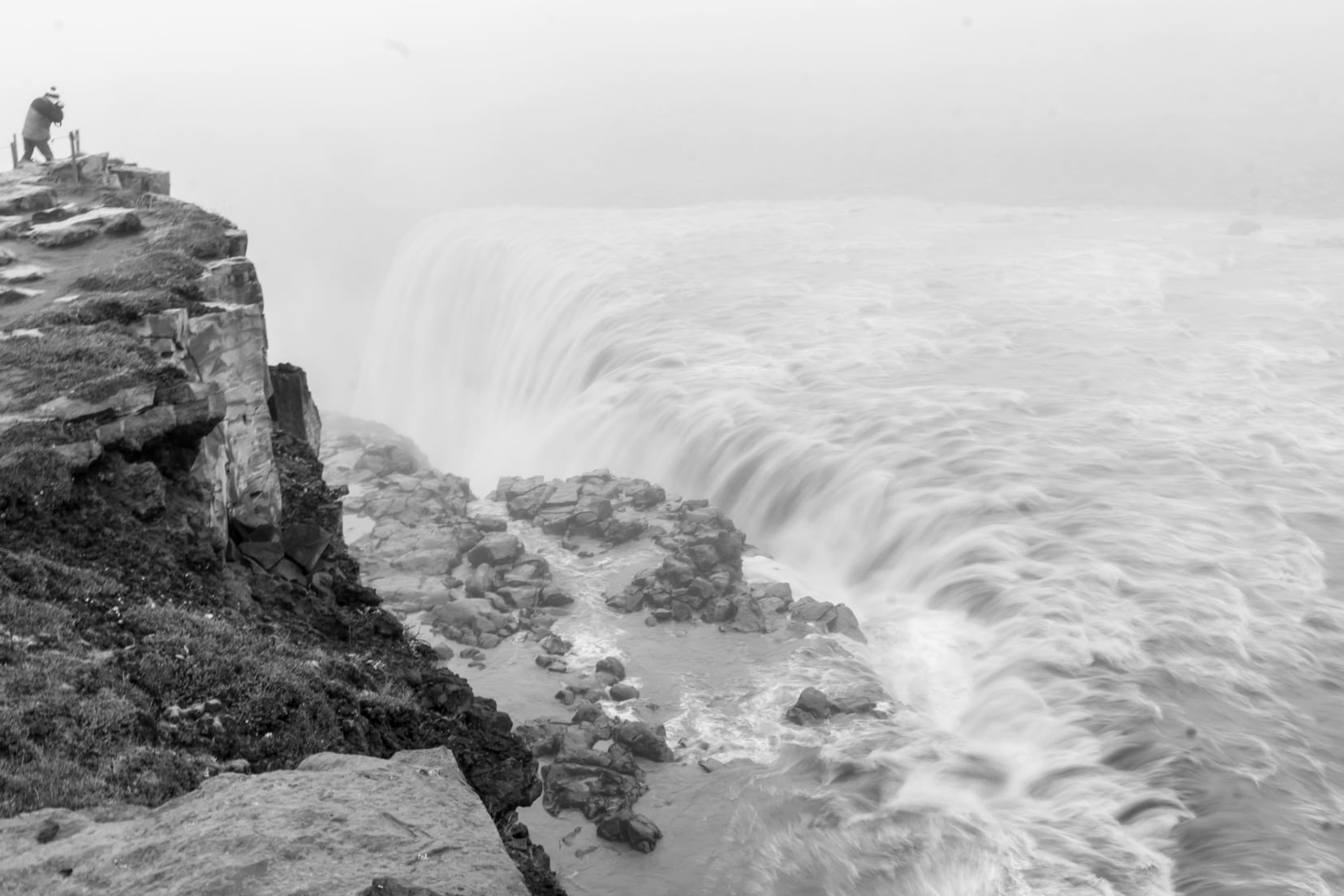
Selfoss (waterfall)
Selfoss, the more famous of the falls, has a series of beautiful plunging falls. This captivating landscape would not be out of place in a mythical Amazonian scene.
We walked the canyon’s edge briefly to get closer to the falls.
📸 Photography Tip
Capture a dreamy, soft effect using an ND filter for a long exposure image.
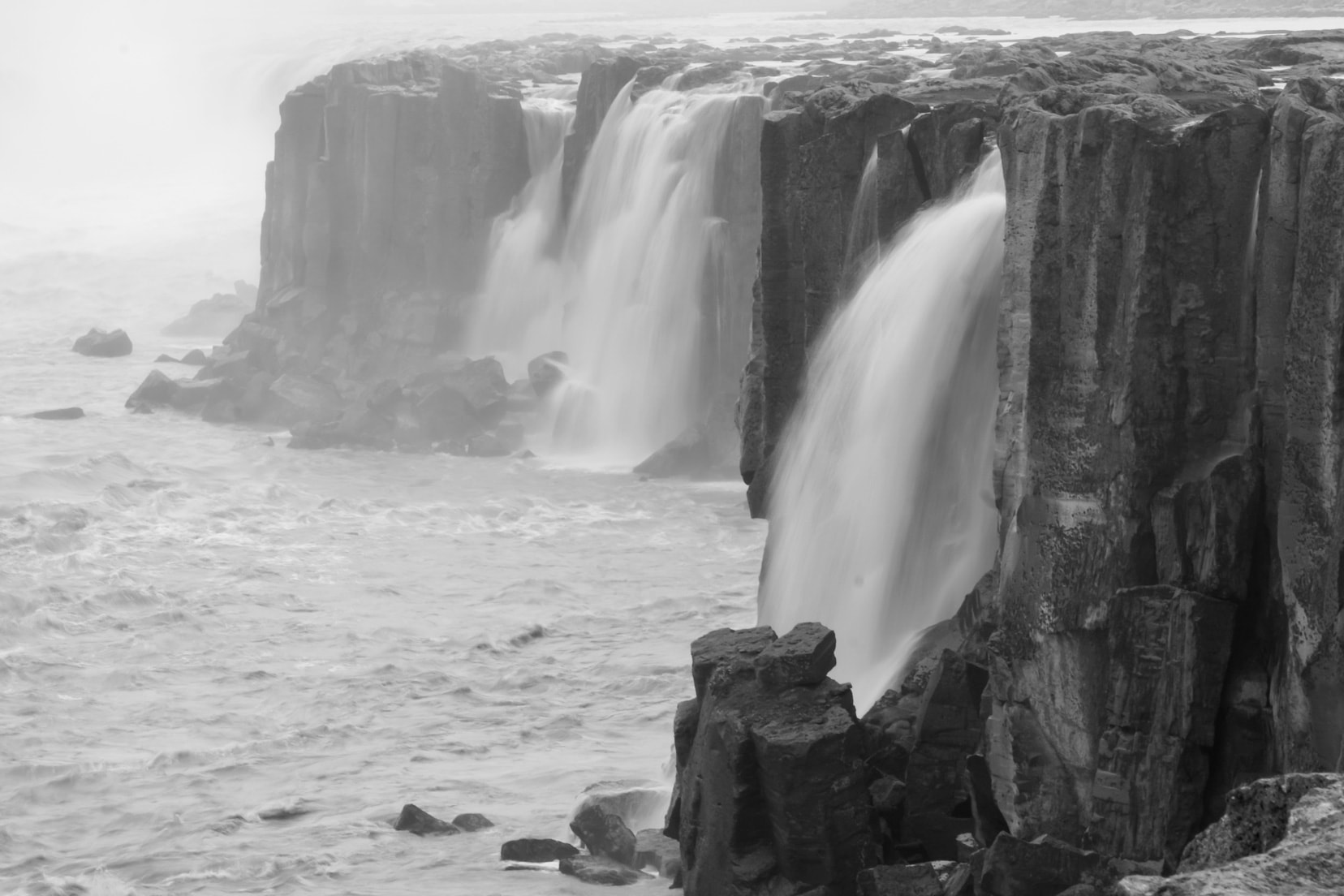
Ásbyrgi Canyon
Ásbyrgi Canyon is a horseshoe-shaped depression of an old glacial canyon measuring 3.5km x 1.1km.
Within the canyon is a thriving woodland with a pretty little lake, Botnstjörn. We walked through this beautiful scenery on some of the many hiking trails threading our way through the canyon and around its rim.
Asbyrgi Canyon is a 35km drive north of Detifoss.
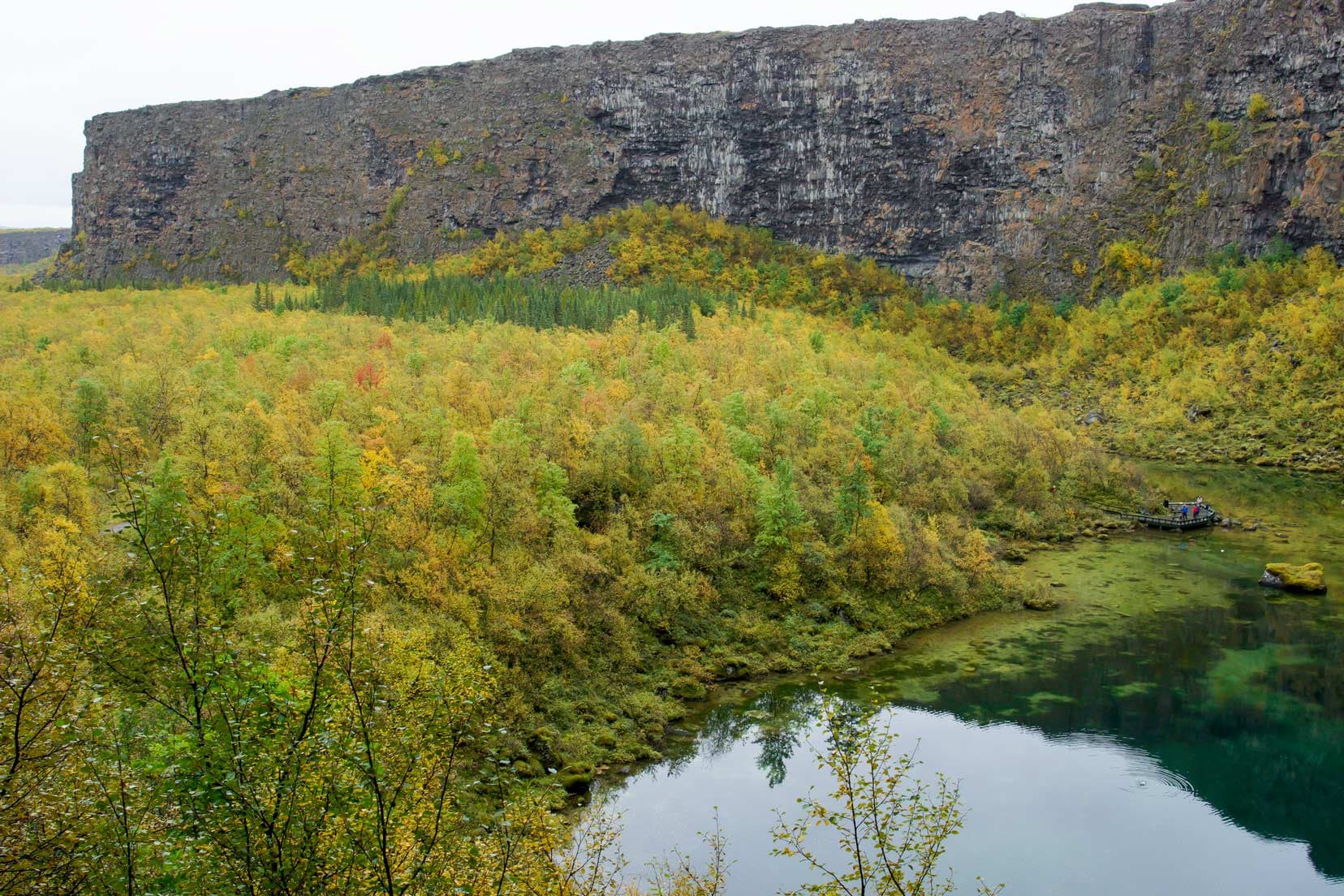
Hverir
Arriving at Hverir, we were immediately infused with the smell of sulphur.
Hverir is a melting pot of volcanic activity, alive with boiling mud and clouds of sulphurous gas. A scene from an apocalypse is not a far-fetched thought as we walked around the spitting mud and shooting steam.
But it’s no surprise, really, as this area is the convergence of two massive tectonic plates. We spent a super interesting couple of hours at Hverir.
There is paid parking.
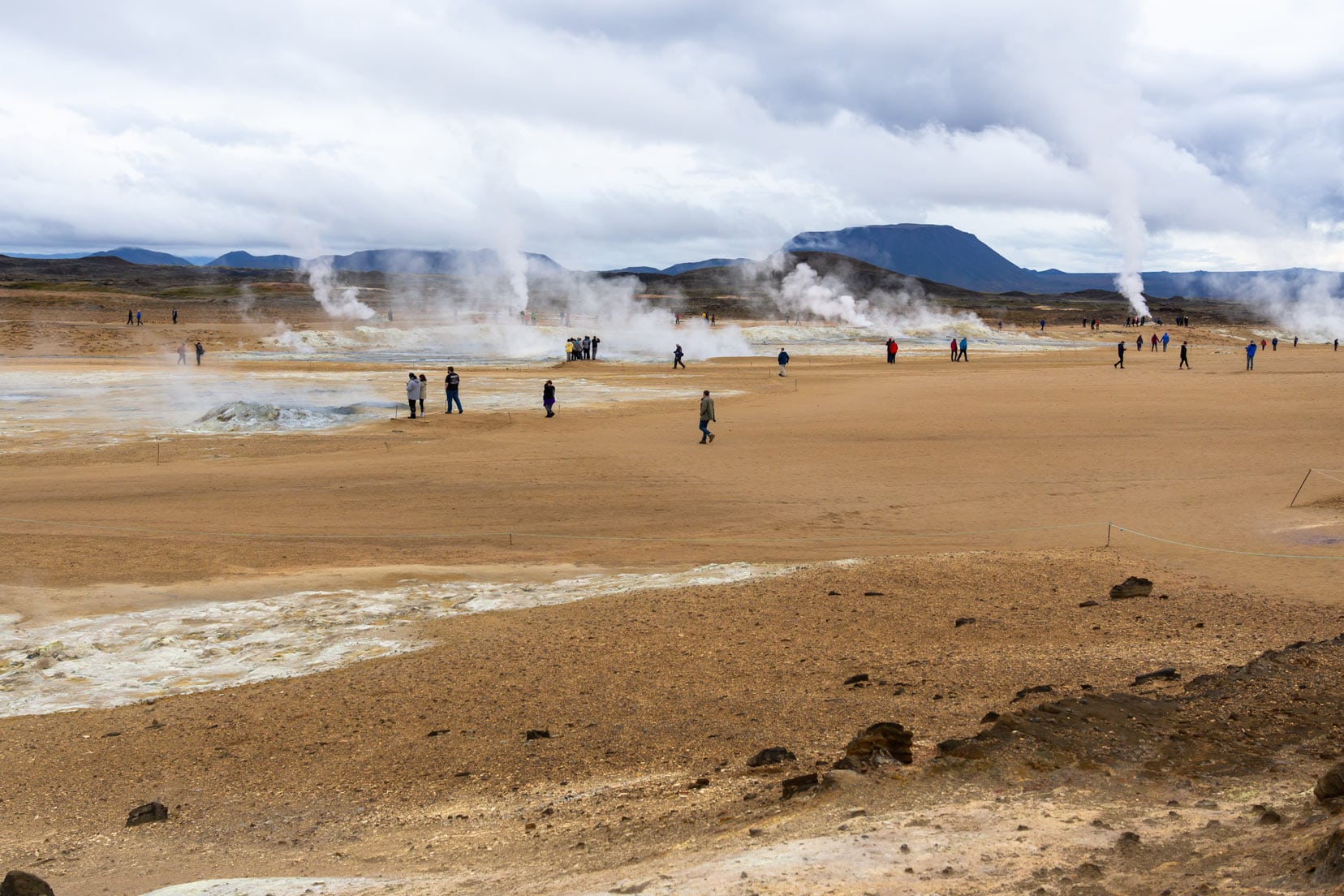
Grjótagjá Cave
Grjótagjá Cave is a small lava cave hiding a beautiful thermal spring. The land around it has suffered great upheaval with a split.
Climbing through a hole in the rocks, we entered a cave. Sliding down a couple of meters brought the beautiful blue crystal-clear waters of a small spring into view.
Bathing used to occur but is now not allowed due to the unpredictable and sudden rise in water temperature.
Grjótagjá Cave is 5km from Hverir.
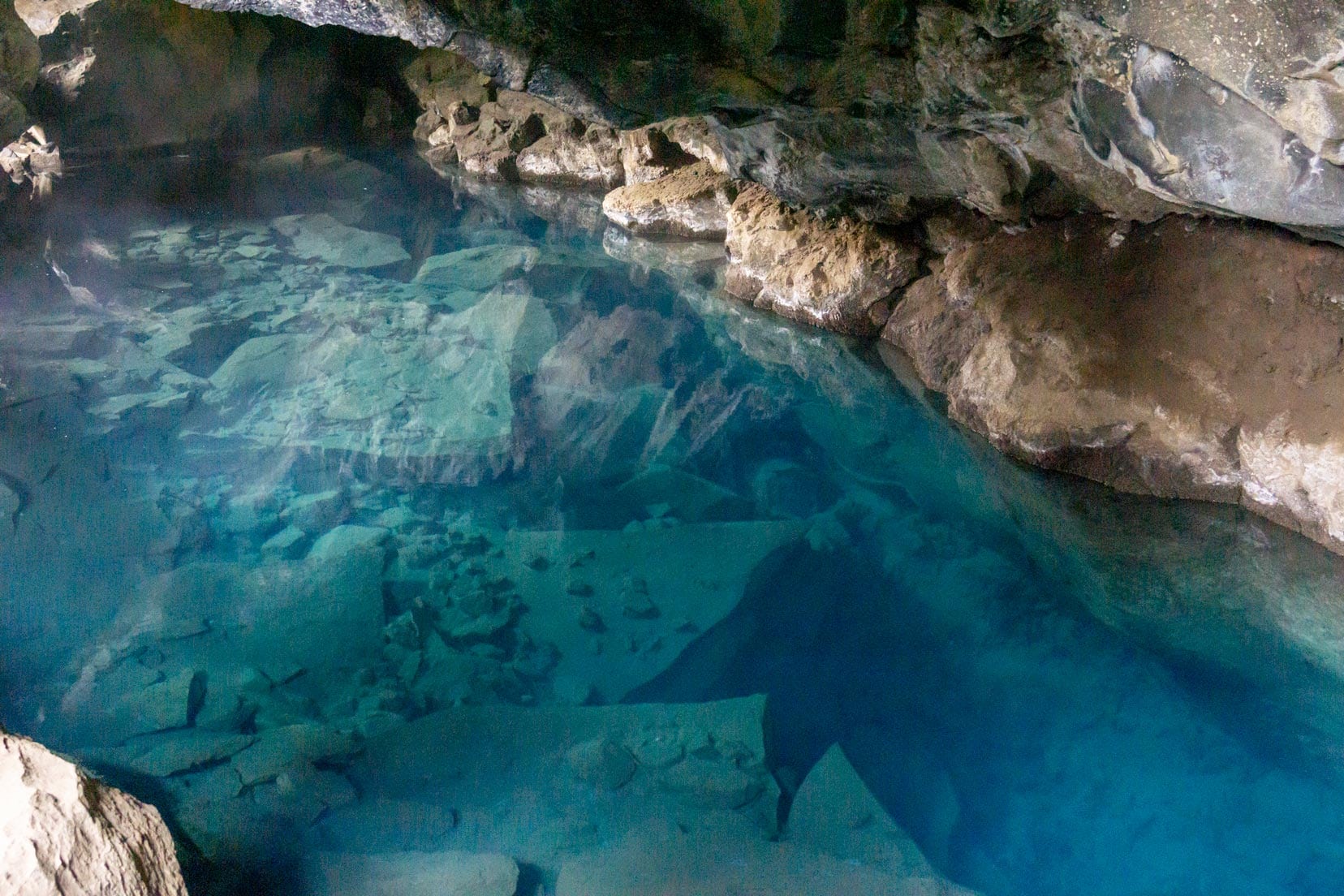
Myvatn Lake
Leaving the mud pools and steam behind, we stopped to view the serene Myvatn Lake.
Home to many birds, Myvatn Lake was calm in comparison to the tempest just witnessed at Hverir. Hverfjall Crater is visible in the background.
📸 Photography Tip
Look for Hverfjall Crater skulking in the background, which offers a captivating backdrop for a Myvatn Lake shot.
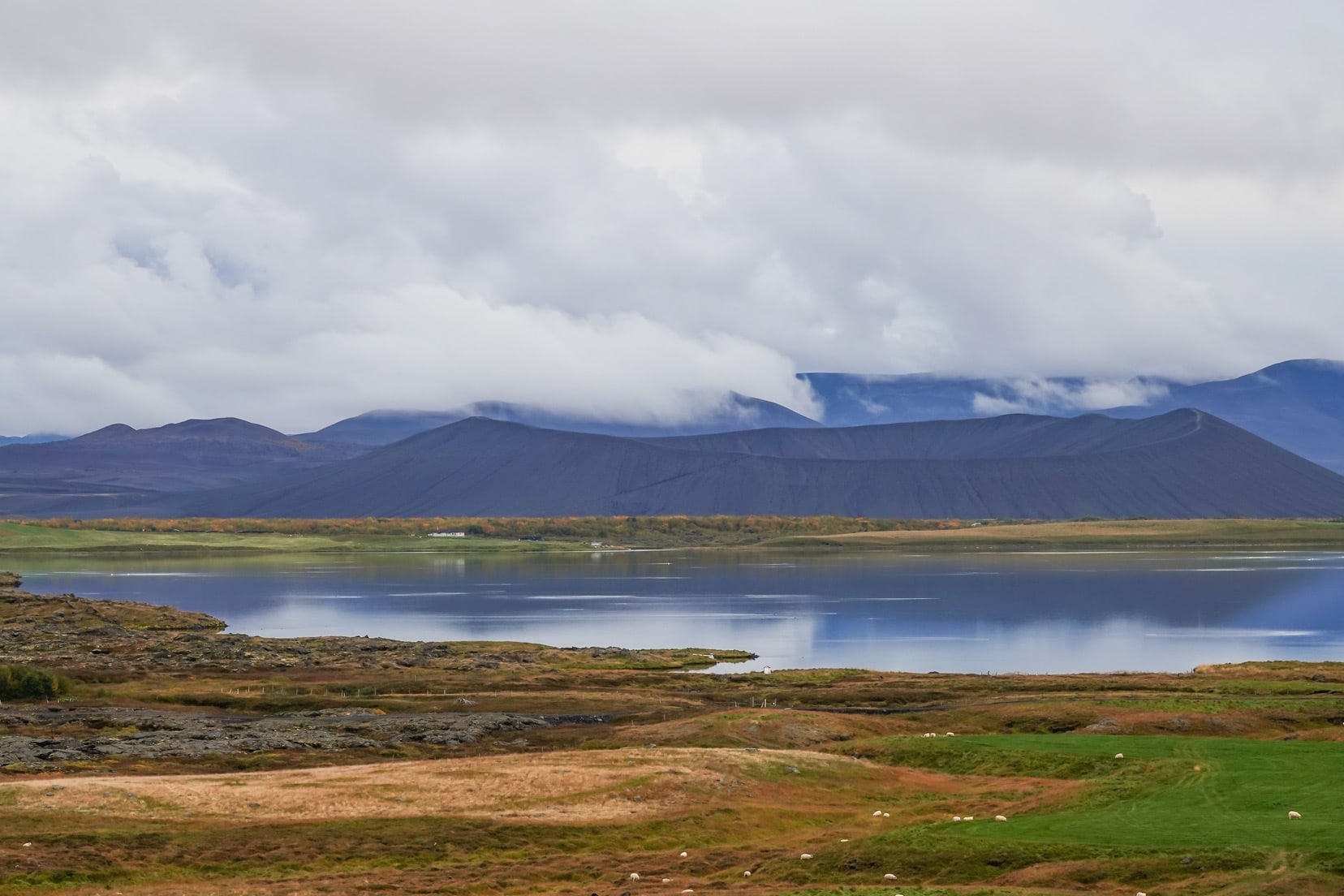
Goðafoss
It is yet another waterfall, but this one is special. Goðafoss falls 12m from a 30 m-long horse-shoe-shaped ledge. It is a stunning sight.
Located close to the ring road, we had a very short walk to see the wonderful views of Godafoss.
Goðafoss is nick-named the ‘Waterfall of the Gods’ due to its god-like beauty.
📸 Photography Tip
Consider using an ND filter on a wide-angle lens to slow the exposure, giving the water a soft, fairytale look to the ‘Waterfall of the Gods’.
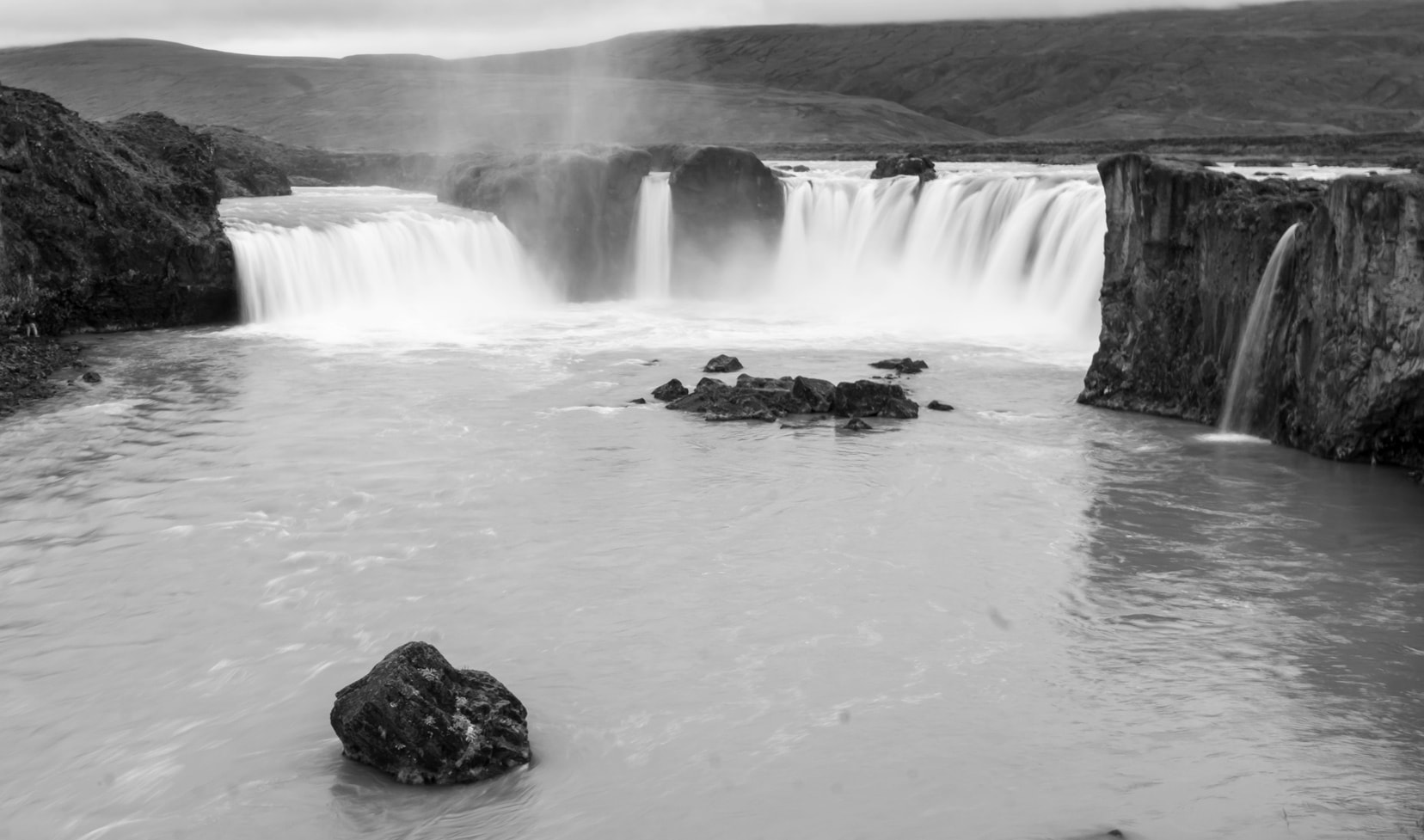
Day 9: Akureyri
🏡 Overnight Accommodation: Akureyri
- Akureyri church
- Akureyri Botanical Gardens – Lystigarðurinn
- Saurbæjarkirkja church
Akureyri Church
It was easy for us to find the Akureyri Church, a prominent landmark in the town of Akureyri.
I think this modern-looking church looks more at home in a bustling city.
The same architect also designed the Hallgrimskirkja in Reykjavik.

Akureyri Botanical Gardens (Lystigarðurinn)
We were surprised to find botanical gardens in Akureyri and later found out that they claim the title of the northernmost botanical garden in the world.
Our September visit allowed us to enjoy the last of the summer colours and the vibrant autumn hues.
The gardens have over 7,000 plant species and are free to enter.
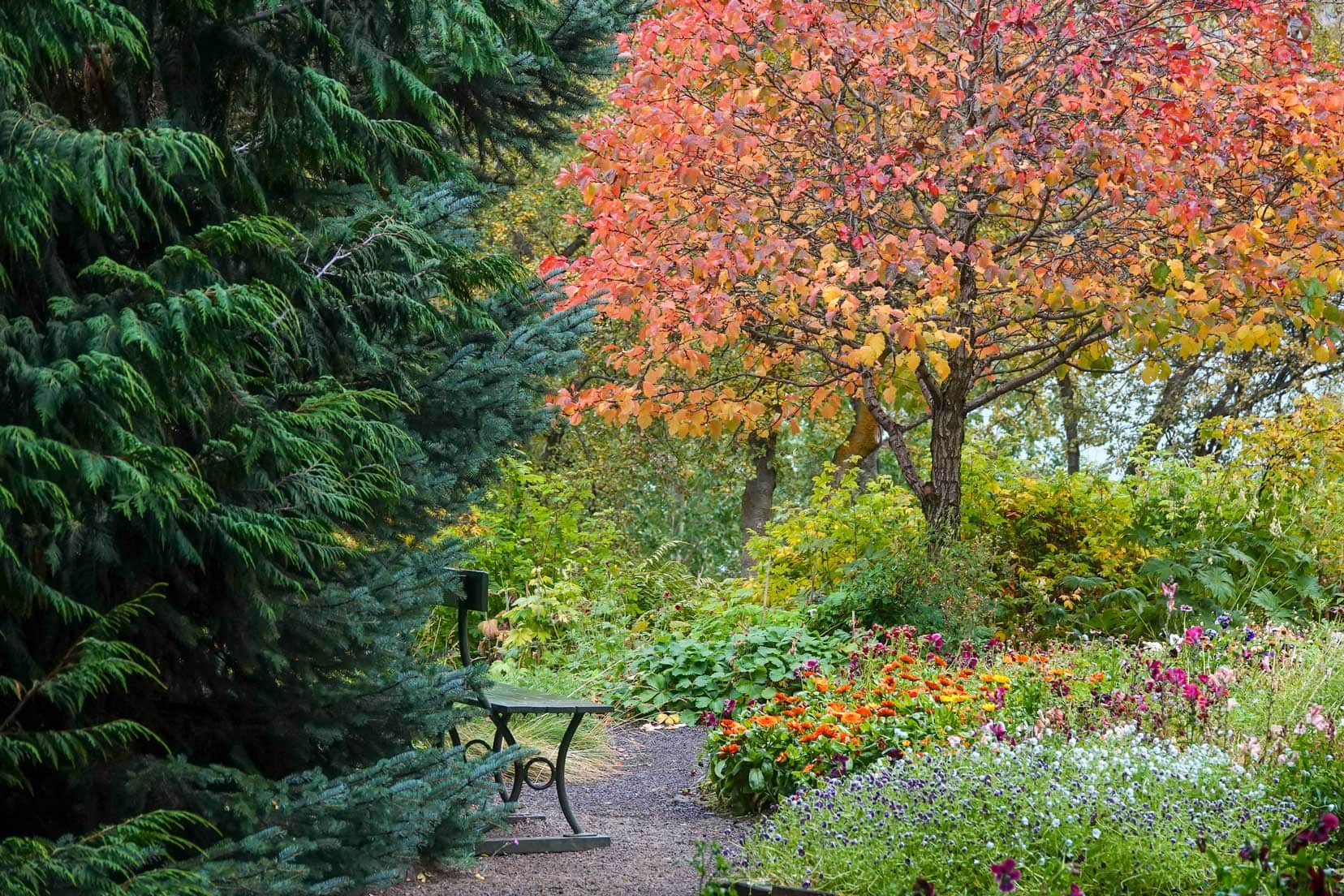
Saurbæjarkirkja
The pretty turf church of Saurbæjarkirkja was built in 1858 and is the largest of the six remaining turf churches in Iceland.
We wanted to glimpse the church interior, but the windows didn’t allow us to see clearly enough.
Saurbæjarkirkja, 26km south of Akuyeri, is a protected landmark and not formally open to the public.
The National Museum of Iceland owns Saurbæjarkirkja.
📸 Photography Tip
The church is in a wide open area with a mountainous backdrop, so there are many angles from which to shoot to capture this solitary church.
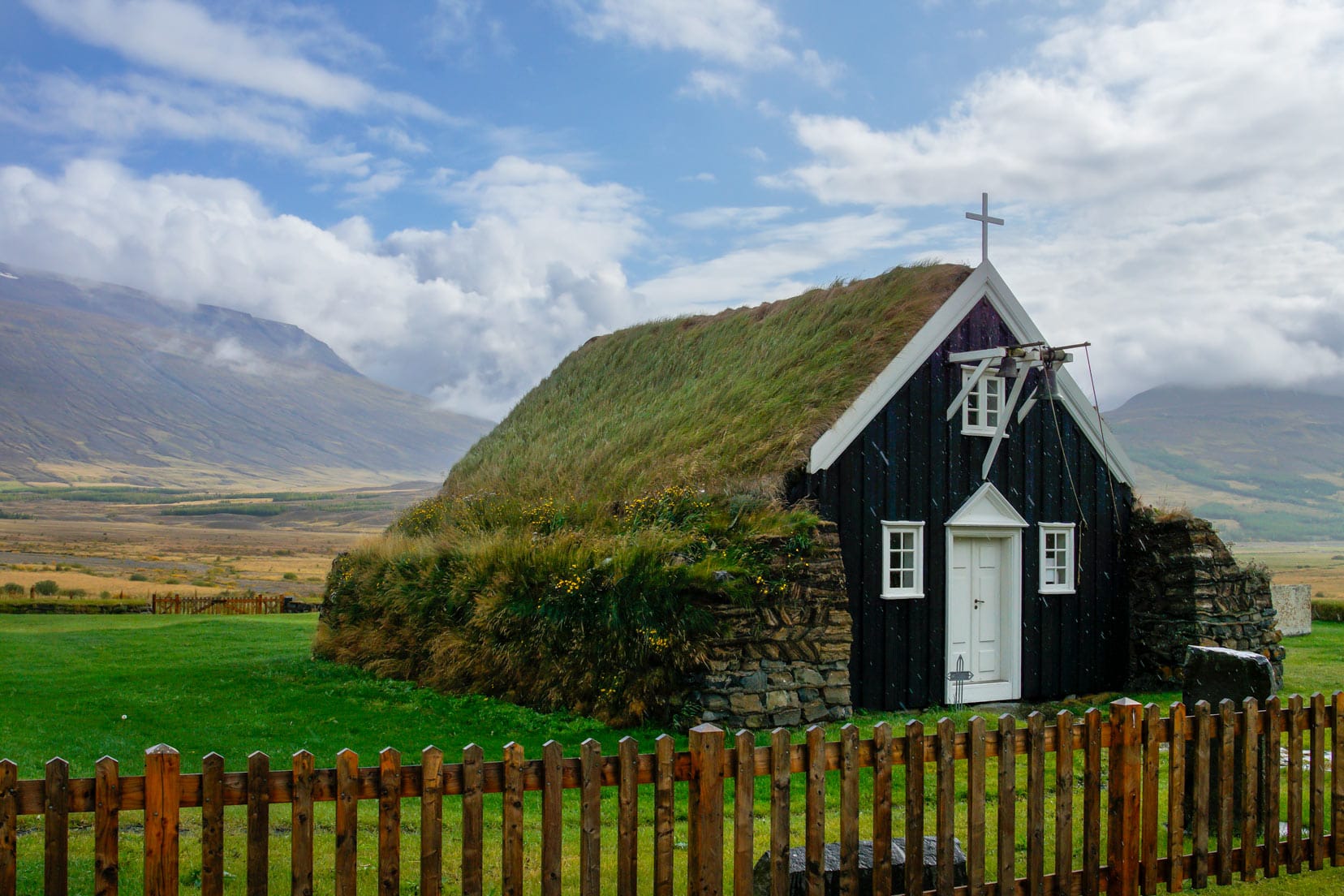
Day 10: Blönduós
🏡 Overnight Accommodation: Hvítserkur
- Víðimýrarkirkja (turf church)
- Vatnsdalsholar hillocks
- Hvitsekur rock arch
- Hamarsrétt sheep corral
Víðimýrarkirkja
This was our favourite turf church in all of Iceland.
The Víðimýrarkirkja turf church, built in 1834, is a stunning example of this old Icelandic style of architecture.
The front gates are a more recent addition, having been built in 1936. The green, black and orange colours of the church make for a striking combination.
📸 Photography Tip
Capture the pretty church, front gate and vibrant colours for a compelling photo.
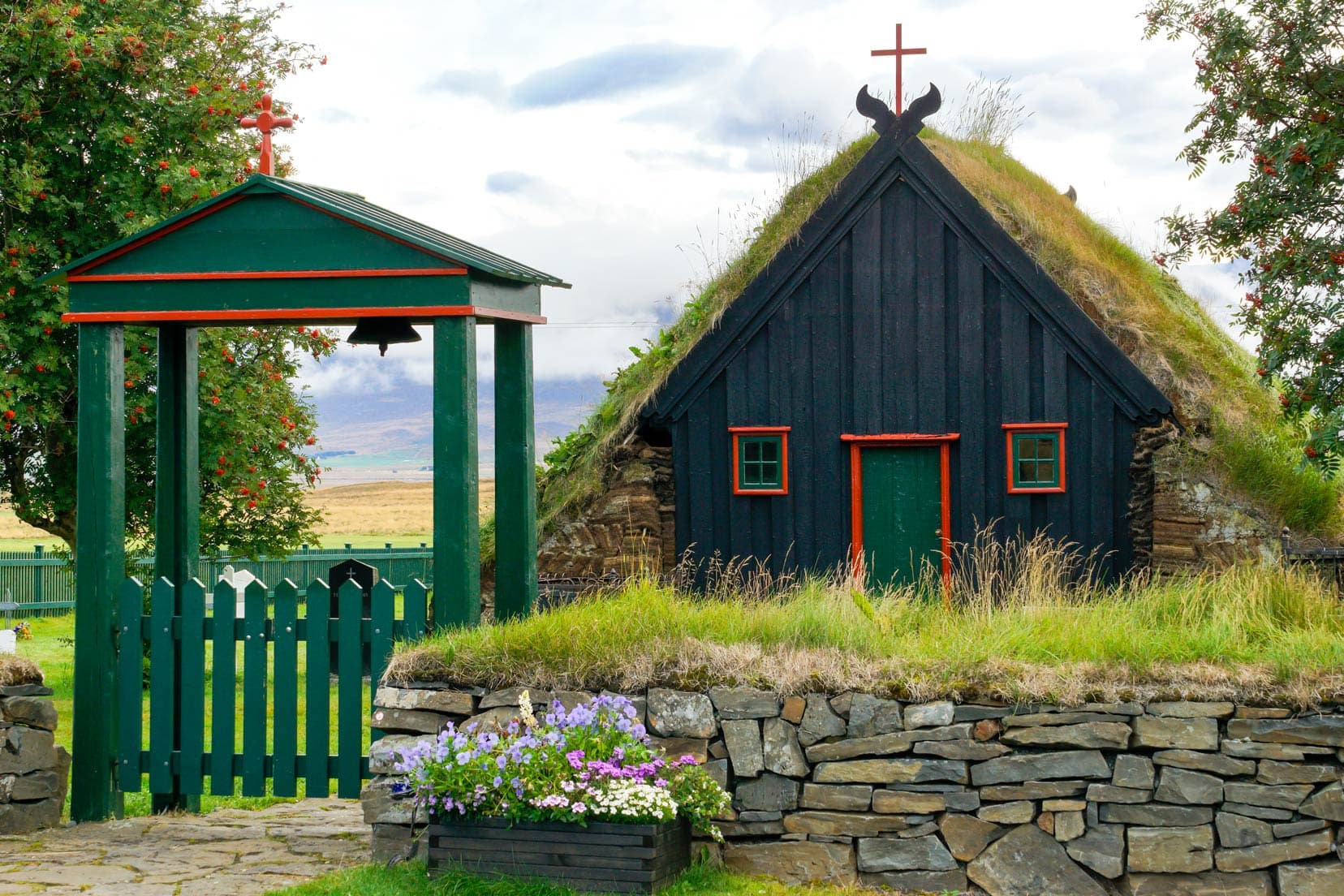
Vatnsdalsholar
The strangely shaped hillocks, Vatnsdalsholar, seem out of place in the surrounding flat landscape.
We took this image from the road, so I’m guessing they are approximately three kilometres away.
Vatnsdalsholar was formed following a landslide, and these hills cover a huge area of roughly 5 square kilometres. Again, Mother Nature is busy at work.
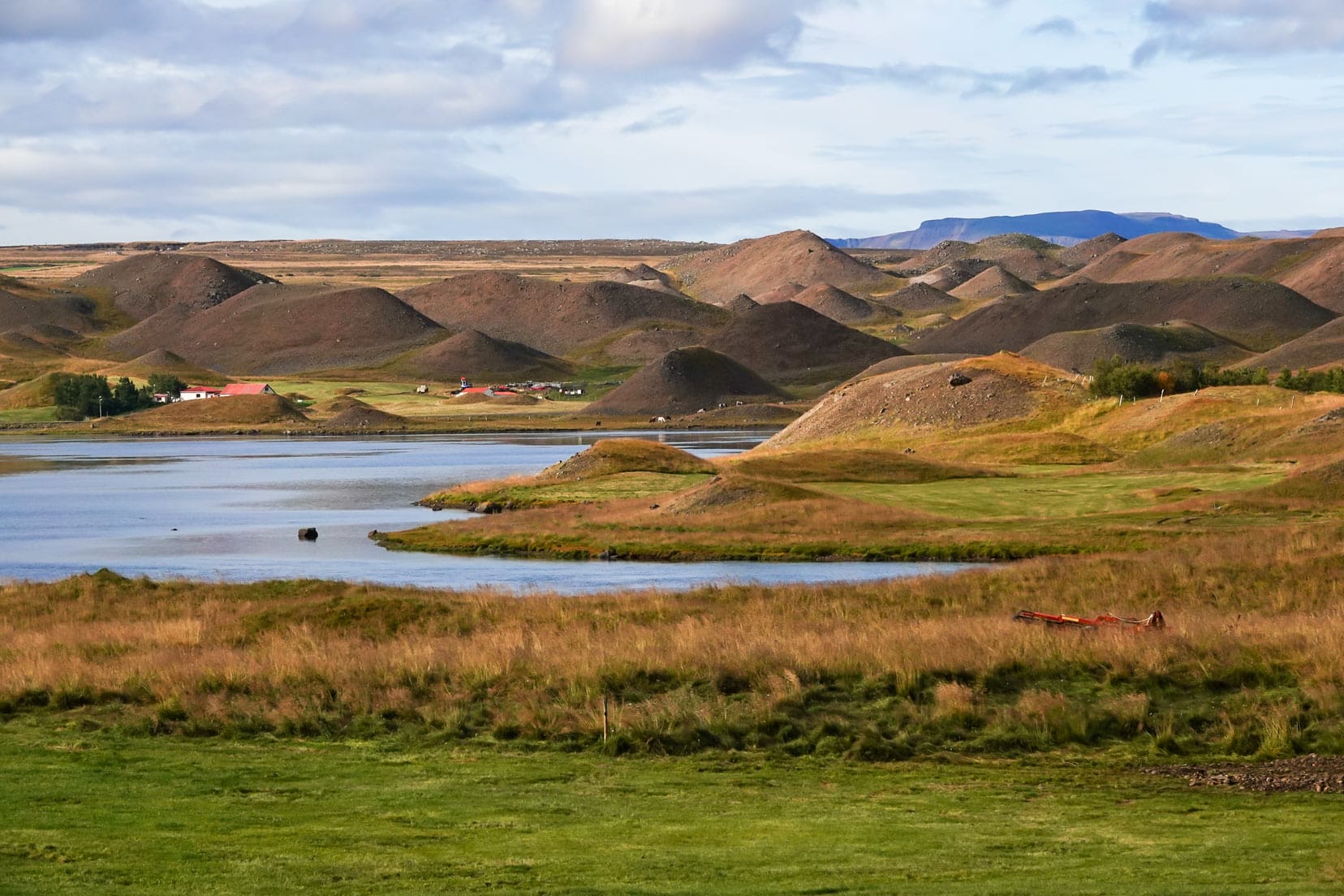
Hvitserkur
The craggy basalt rock formation of Hvitserkur stands just off the northern coastline in shallow water.
Time the tides right, and you can walk to it.
We walked just a few hundred metres from the parking bay to capture views of the rock from above. Then, we followed a steep path to the beach for more personal views.
You might notice that concrete has been added to the base of the rock for support as it was in danger of collapsing.
📸 Photography Tip
Consider shooting Hvitserkur with its reflections.
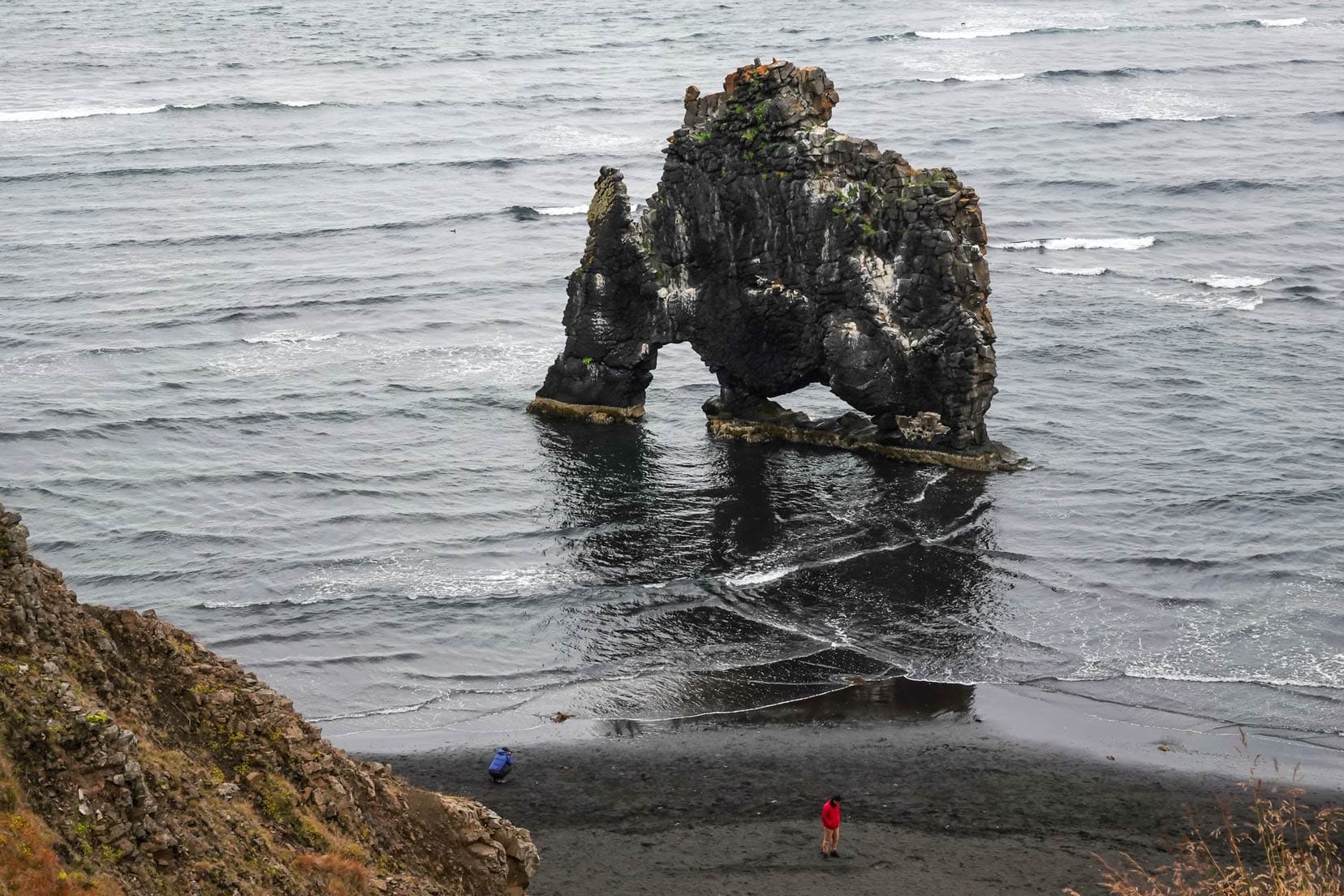
Hamarsrétt
Hamarsrétt is the only coastal sheep corral in Iceland. We saw it from the road in a natural clearing, down in the valley between rocky hillocks.
I spoke to one of the sheep farmers who was carrying out repairs. He told me the sheep are herded from the nearby hills into the round, central hub.
Owners then claim their animals and steer them to their holding pens within the ‘spokes of the wheel’—an interesting and effective method of dividing stock.
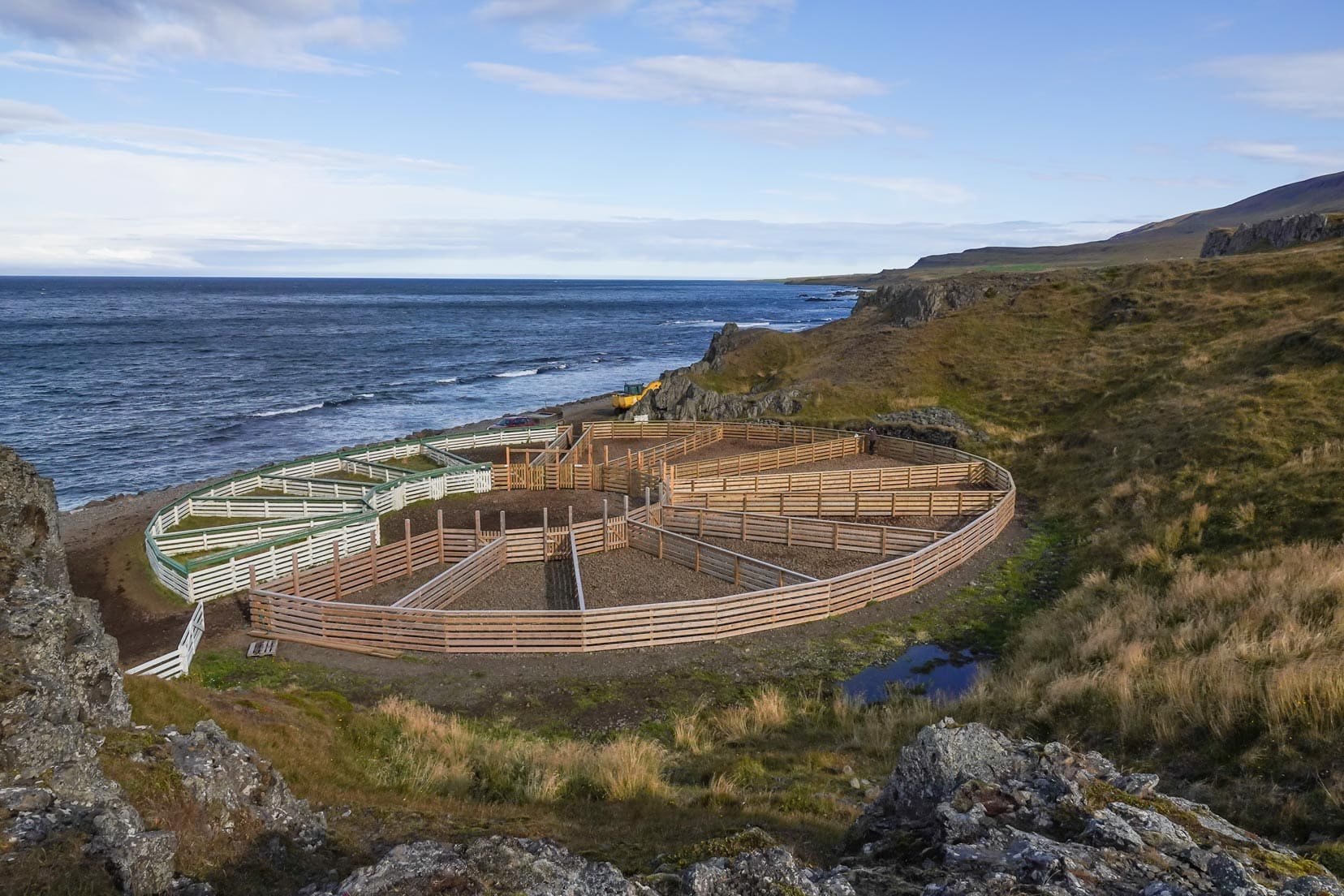
Day 11: Olafasvik
🏡 Overnight Accommodation: Olafsvik
- Snæfellsnes Peninsula
- Ingjaldshóll church
- Skarðsvík Beach
- Saxhólar Crater
Snæfellsnes Peninsula
Snæfellsnes Peninsula is often called Iceland in miniature as it is said to showcase the essence of Iceland’s natural beauty. The final three days of this itinerary are spent visiting the Snæfellsnes Peninsula and its many wonderful attractions.
If you were limited to a visit of just a few days, then I’d recommend focusing on this area. It is definitely Iceland in a nutshell.
Ingjaldshóll Church
The lone Ingjaldshóll Church sits defiantly on a bleak landscape. Overlooking the Breiðafjörður fjord with a backdrop of the Snæfellsjokull Glacier, it claims the title of one of Iceland’s oldest concrete buildings in Iceland.
Ingjaldshóll Church was built in 1903.
📸 Photography Tip
Consider including the long road leading towards the church with the mountainous backdrop so accentuate the isolation.
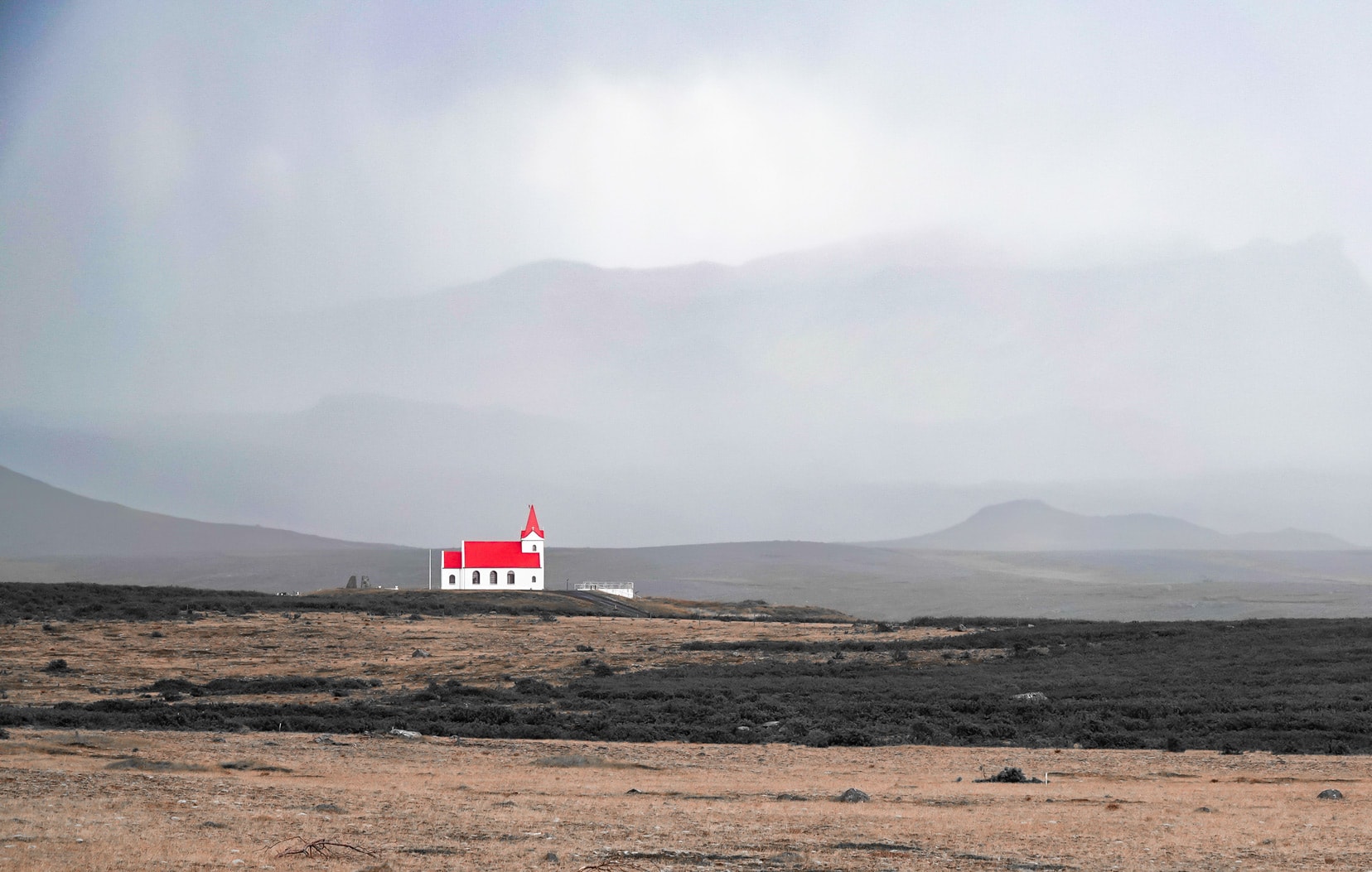
Skarðsvík Beach
What surprised us about seeing Skarðsvík Beach? It’s yellow sand. Somewhat tropical in a way.
This was in complete contrast to the black lava beaches we had previously seen on our travels around Iceland.
You can view the beach from the carpark, which looks directly onto it.
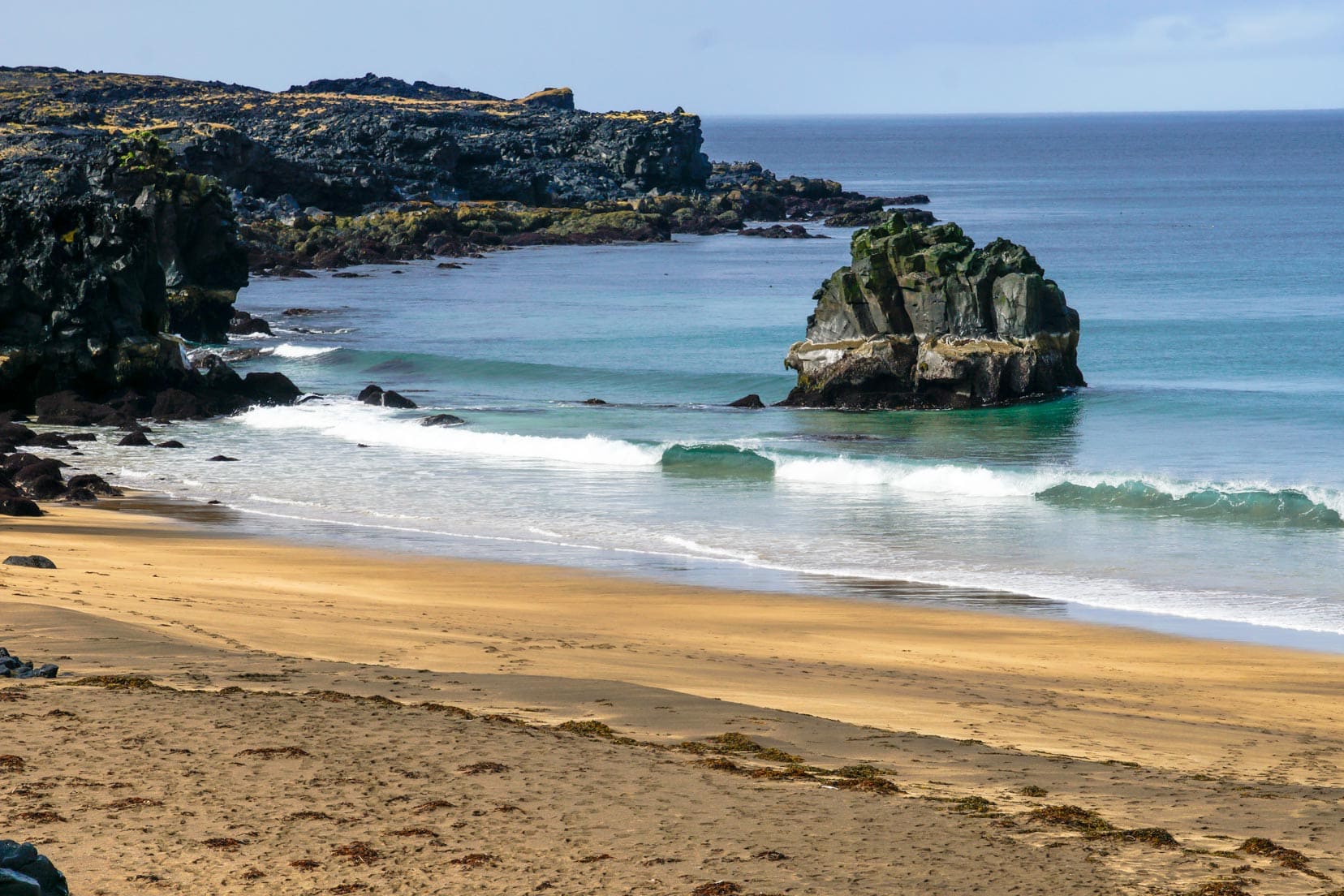
Saxhólar Crater
The 100m high Saxhólar Crater has steps up and down each side, making it easy to access.
We climbed the crater for expansive views over the Atlantic Ocean and the Snæfellsnes Peninsula lava fields.
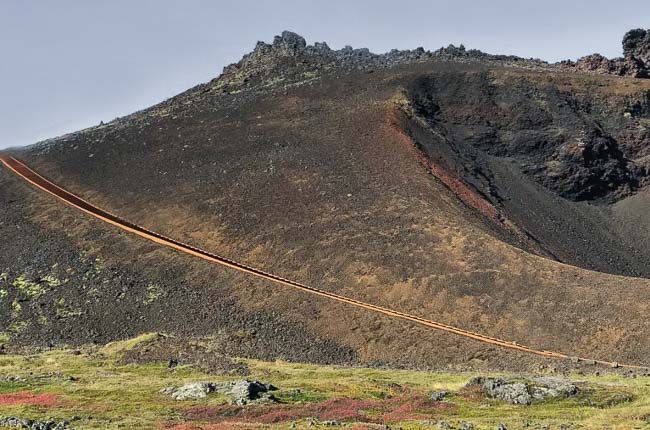
Day 12: Olafasvik
🏡 Overnight Accommodation: Olafsvik
- Shipwreck debris on Djúpalónssandur Beach
- Lifting stones on Djúpalónssandur beach
- Malarrif Lighthouse
- Salthús Museum
- Londrangar rock pinnacles
- Bárðar Saga Snæfellsáss statue
- Gatklettur stone arch of Anarstapi
Shipwreck debris on Djúpalónssandur Beach
Spread across Djúpalónssandur Beach are the rusty remains of the British steam trawler, FV Epine.
During a severe gale in March of 1948, the vessel ran aground to the west of Malariff lighthouse, with 14 out of 19 crew losing their lives.
We saw a few pieces of rusted metal on the beach, some still recognisable as part of a vessel.
The ship’s metal remains are protected and are not to be removed.
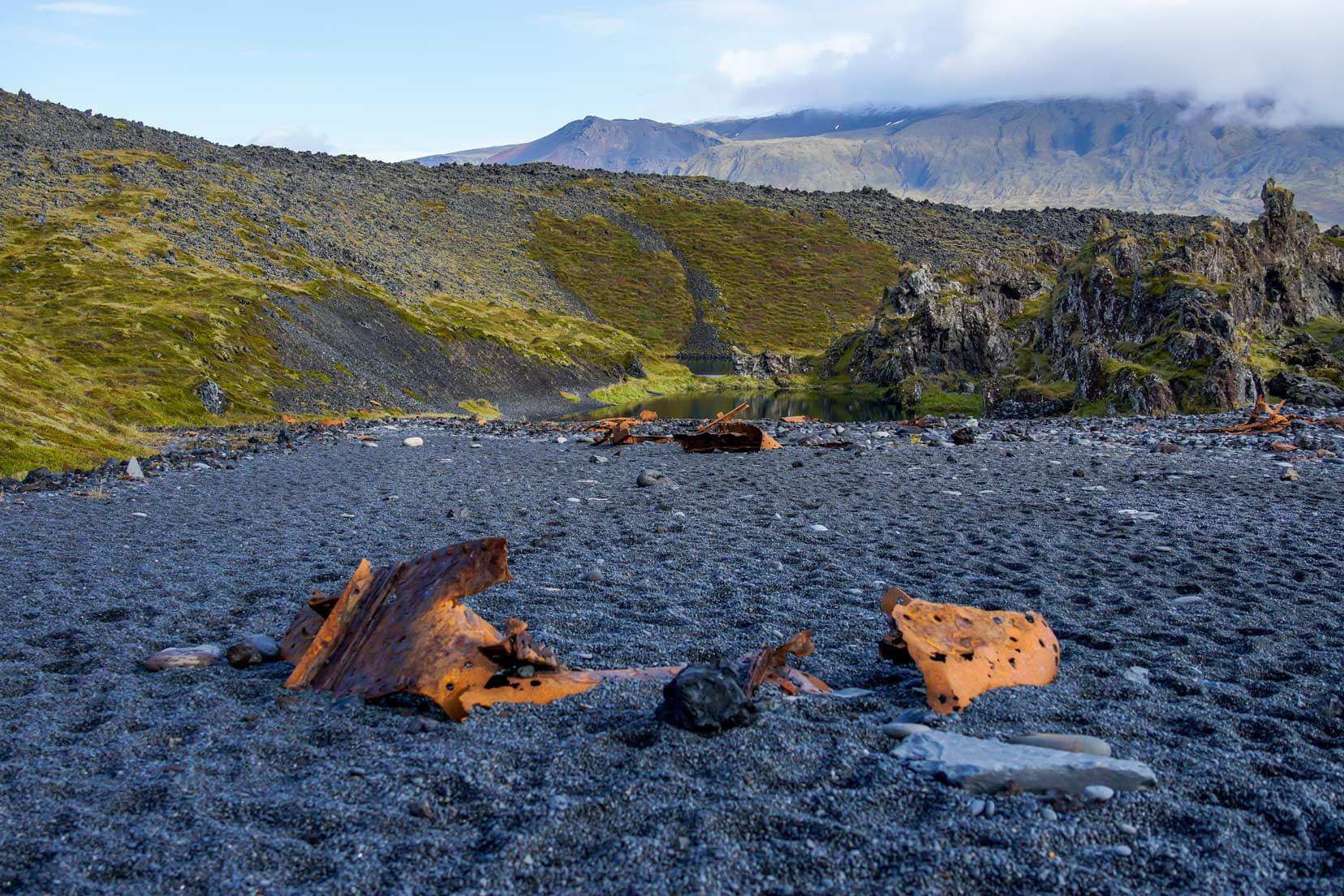
Lifting Stones on Djúpalónssandur Beach
Stepping off the pathway and onto Djúpalónssandur Beach are an intriguing set of four different-sized stones called lifting stones. These stones were lifted to waist height and used to test the strength of potential fishermen.
The lifting stones weigh 23kg, 54kg, 100kg and 154kg a piece.
Put yourself to the test if you dare. I managed to lift the four, but not without some huffing and puffing towards the end.
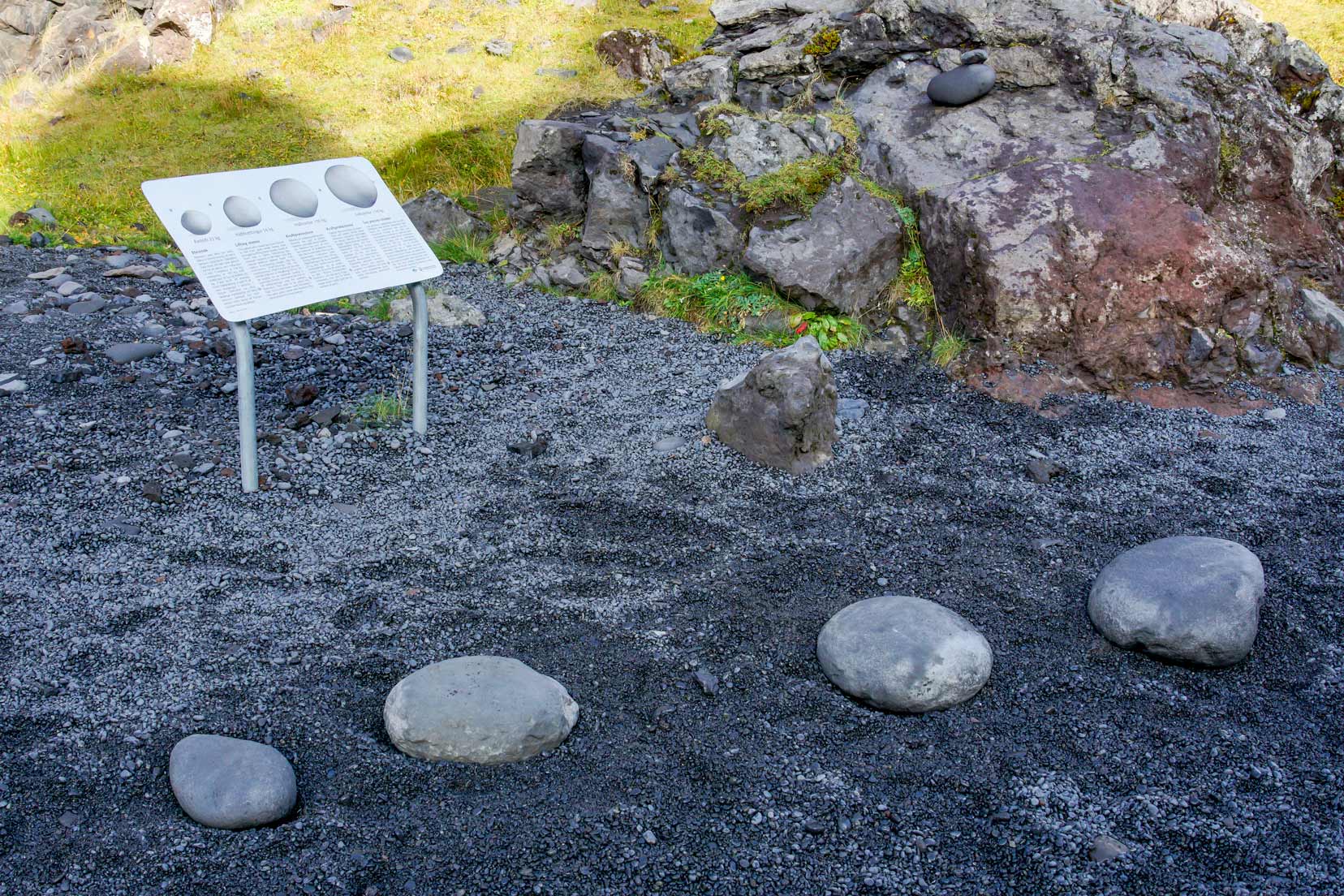
Malarrif Lighthouse
Built in 1917, the Malarrif Lighthouse is classed as a protected building.
Although it commands the best views, it is not a particularly interesting building. However, the surrounding landscape is quite dazzling.
The rocky black lava sweeping beach, blue breaking waves and craggy rock formations make for a compelling scene.
Beside Malarrif Lighthouse is the Snæfellsnes Information Center, with plenty of free parking. I suggest parking here and wandering the area as there is much to arouse curiosity.
📸 Photography Tip
Consider including many of the scene’s natural elements as it really captures the essence of the place.
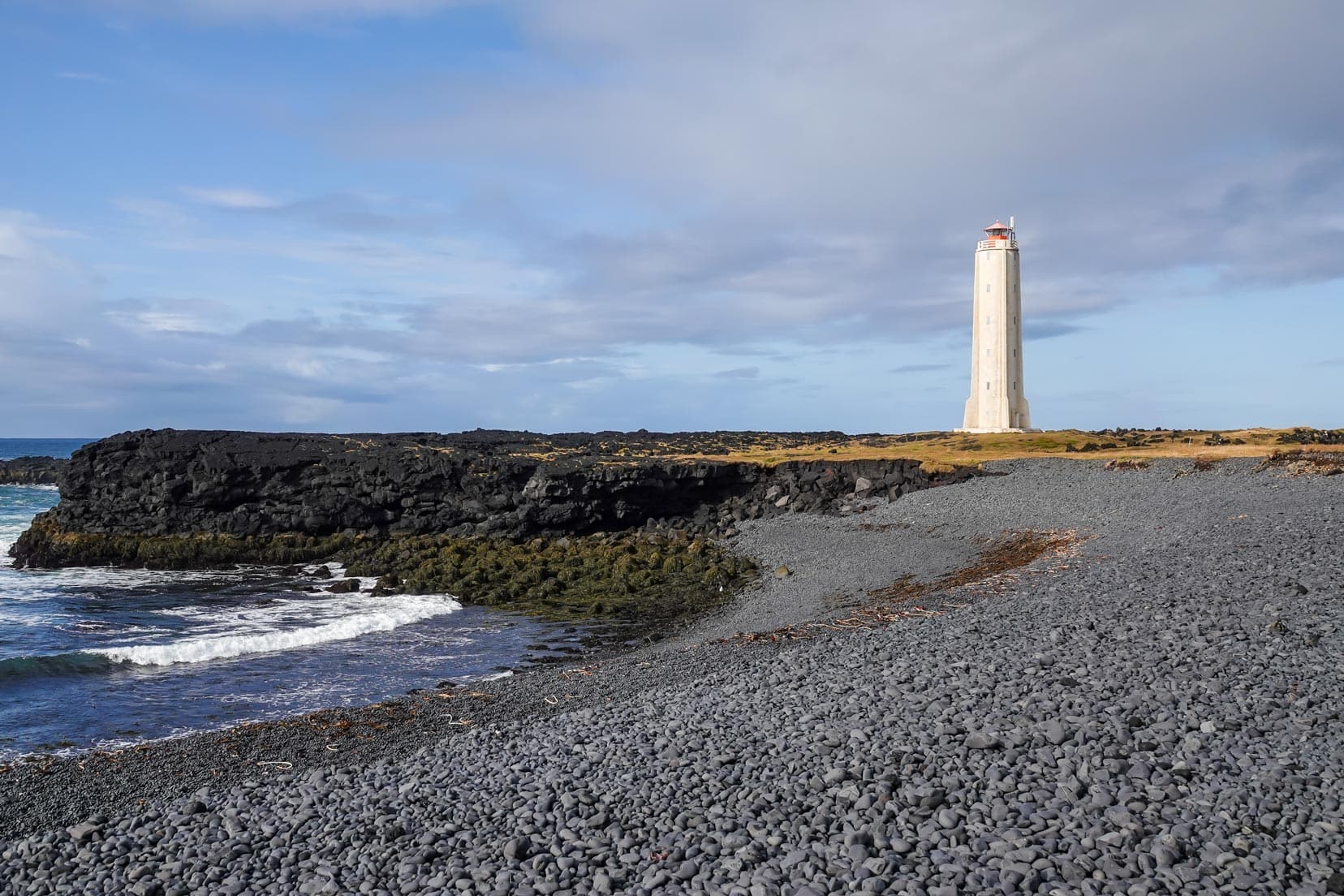
Salthus Museum
Within easy walking distance of the Malariff Lighthouse is the Salthus (or Salthouse) Museum.
Fishermen originally used this small wooden building on the beach’s edge to dry their cod.
We went inside and observed many different artefacts and interesting works of art from the nearby schools.
It is free to enter.
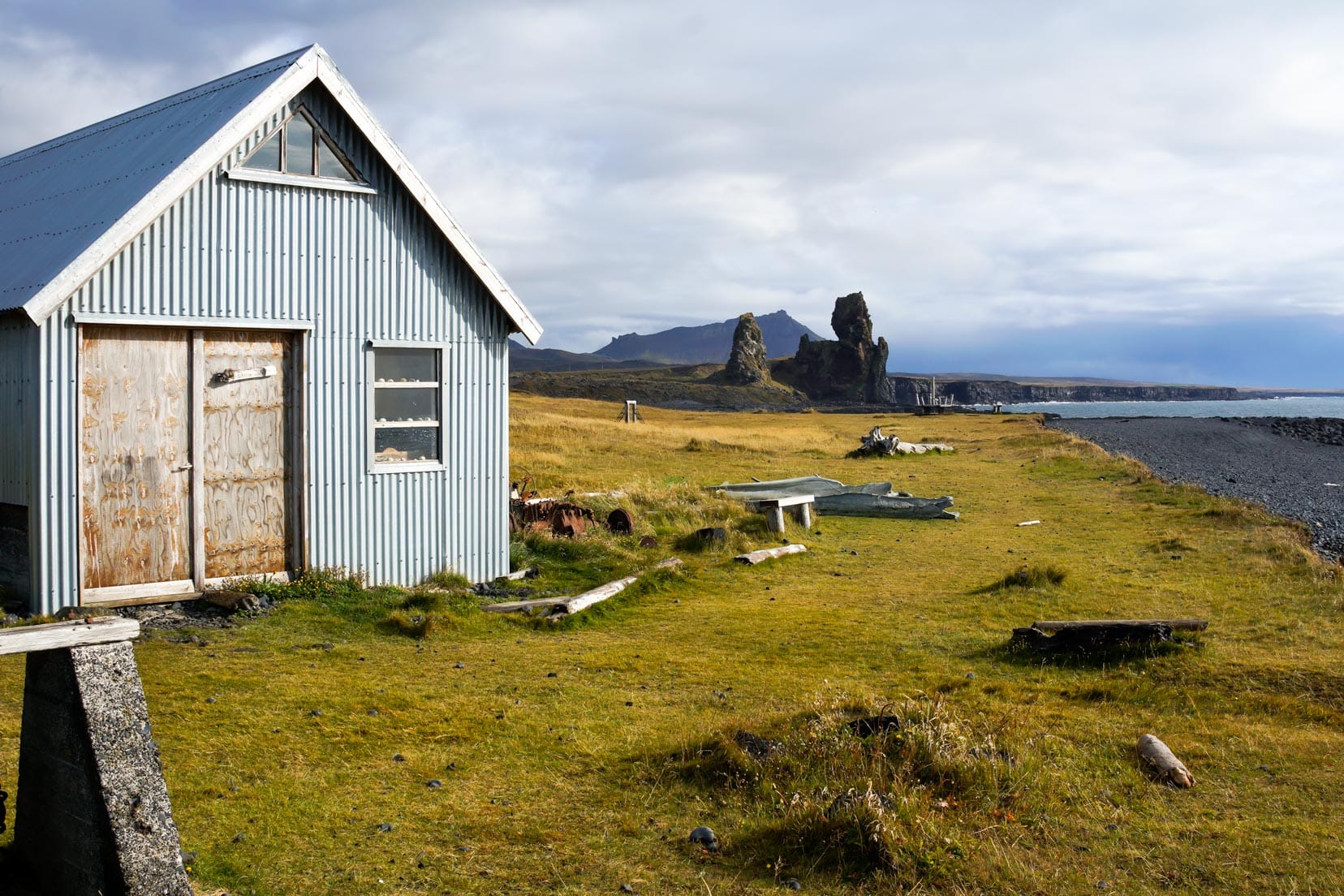
Londrangar Rock Pinnacles
The Londrangar Rock Pinnacles are two impressive volcanic plugs that offer roosting sites for puffins and other birds.
We walked the trails, hugging the coastline to reach the pinnacles, enjoying the typical rugged scenery.
You can leave your vehicle at the Snæfellsnes Information Center and walk or park in a car park closer to them.
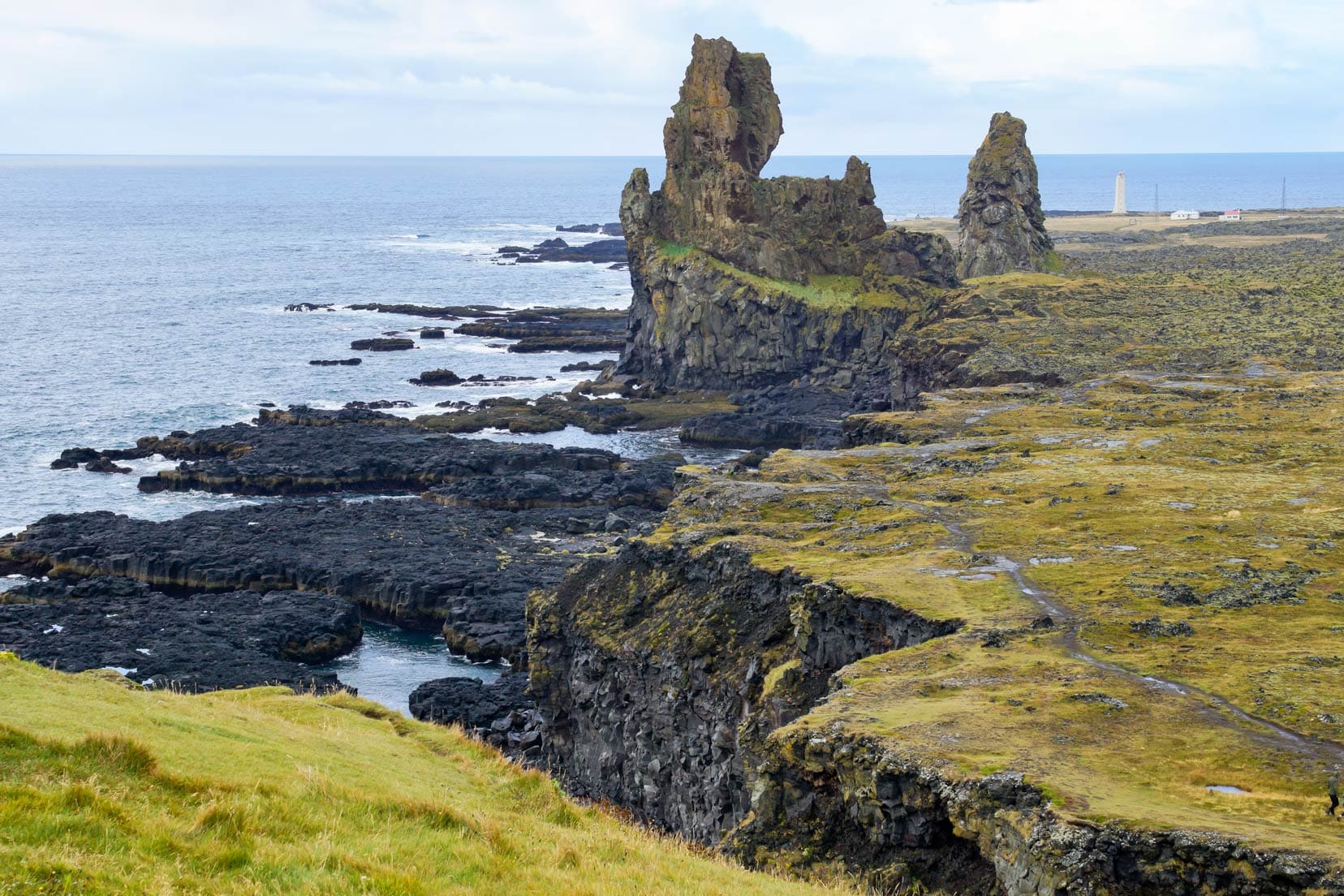
Bárðar Saga Snæfellsáss
The huge 10m tall stone sculpture, Bárðar Saga Snæfellsáss, is famous all across Iceland. It’s a fine work of art.
This mythical half-man, half-troll giant was said to have lived in the area around the Snæfellsjökull glacier.
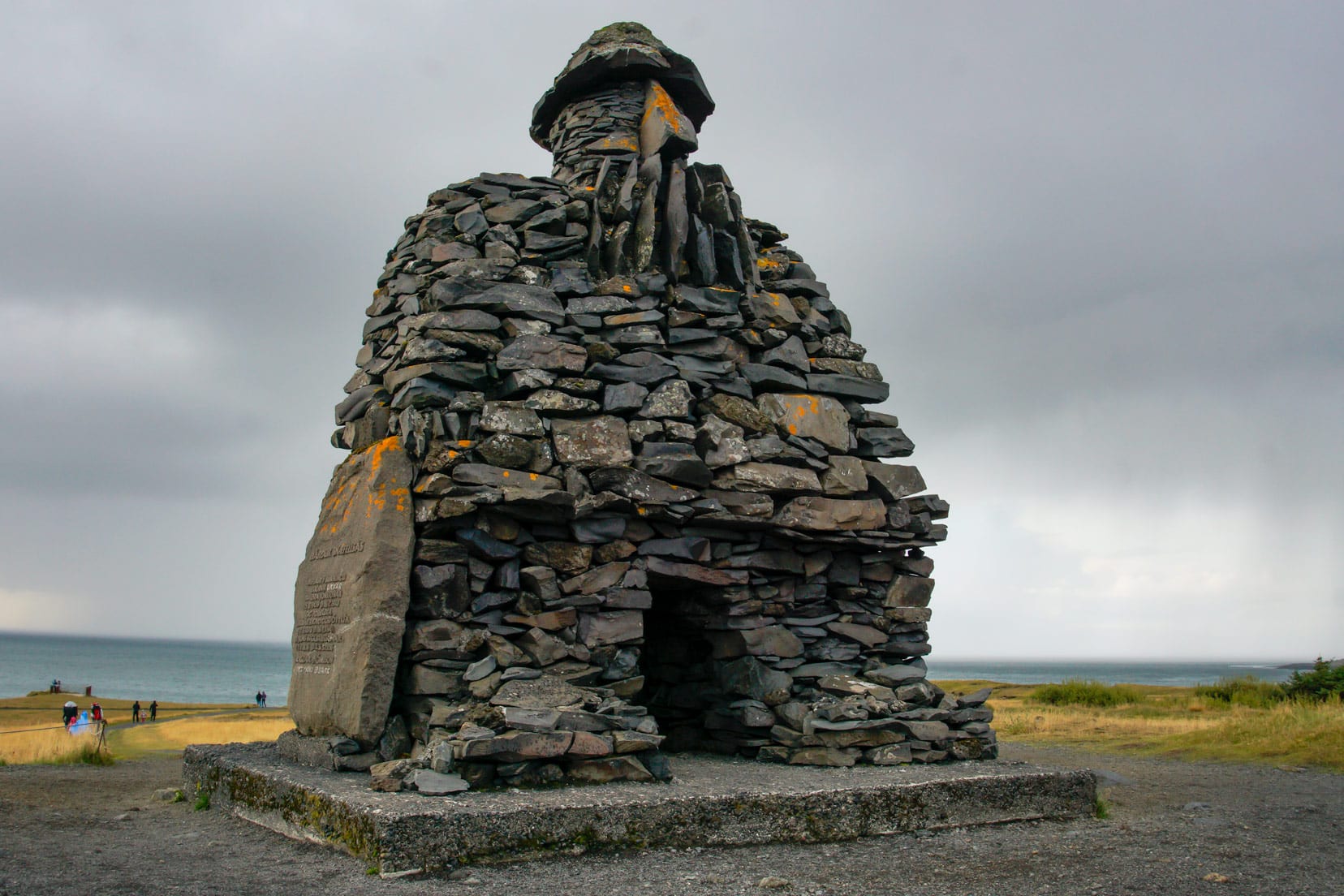
Gatklettur Stone Arch of Anarstapi
Gatklettur is a naturally formed stone arch that the sea has carved out. It’s a popular location for visitors to the Snæfellsnes Peninsula.
Day 13: Olafasvik
🏡 Overnight Accommodation: Reykjavik
- Búðakirkja church
- Ytri Tunga seal watching
- Gerðuberg basalt columns
- Ölkelduvatn Mineral Spring
Búðakirkja Black Church
Búðakirkja we see standing today, was reconstructed in 1848, replacing the original turf church.
It is one of the most photographed buildings in Iceland, given its iconic black exterior, located on barren land in the rugged, beautiful surroundings of Snæfellsnes Peninsula.
The wooden exterior is black due to the pitch it is painted with. This helps protect it from the harsh Icelandic weather and is a similar practice used on Norwegian stave churches.
📸 Photography Tip
This is a compelling shot for photographers. The solitary black church with a harsh, forbidding background gives an ominous feel to the scene.
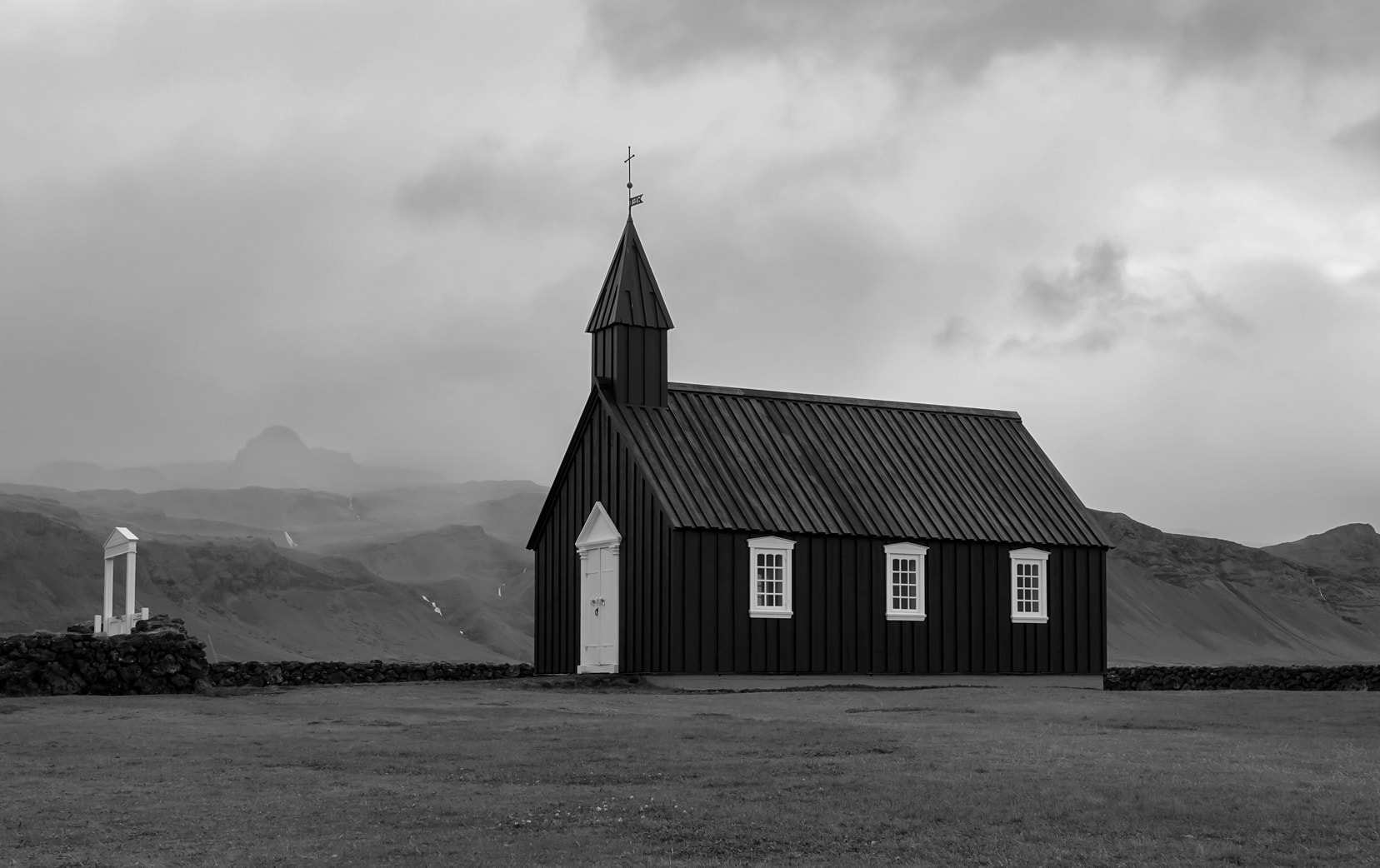
Ytri Tunga Seals
The Ytri Tunga seals have mastered the art of lazing around. The large, scattered rocks, about 50m off the sandy beach of Ytri Tunga, offer a great haven from which to observe us humans onshore.
We really enjoyed our brush with the wildlife.
Gerðuberg Basalt Cliffs
The Gerðuberg Basalt Cliffs are rows of vertical hexagonal columns stretching over 1000 metres.
We drove the base on the road that followed the cliffs’ line; however, it’s also possible to walk to the top of the Gerðuberg Basalt Cliffs.
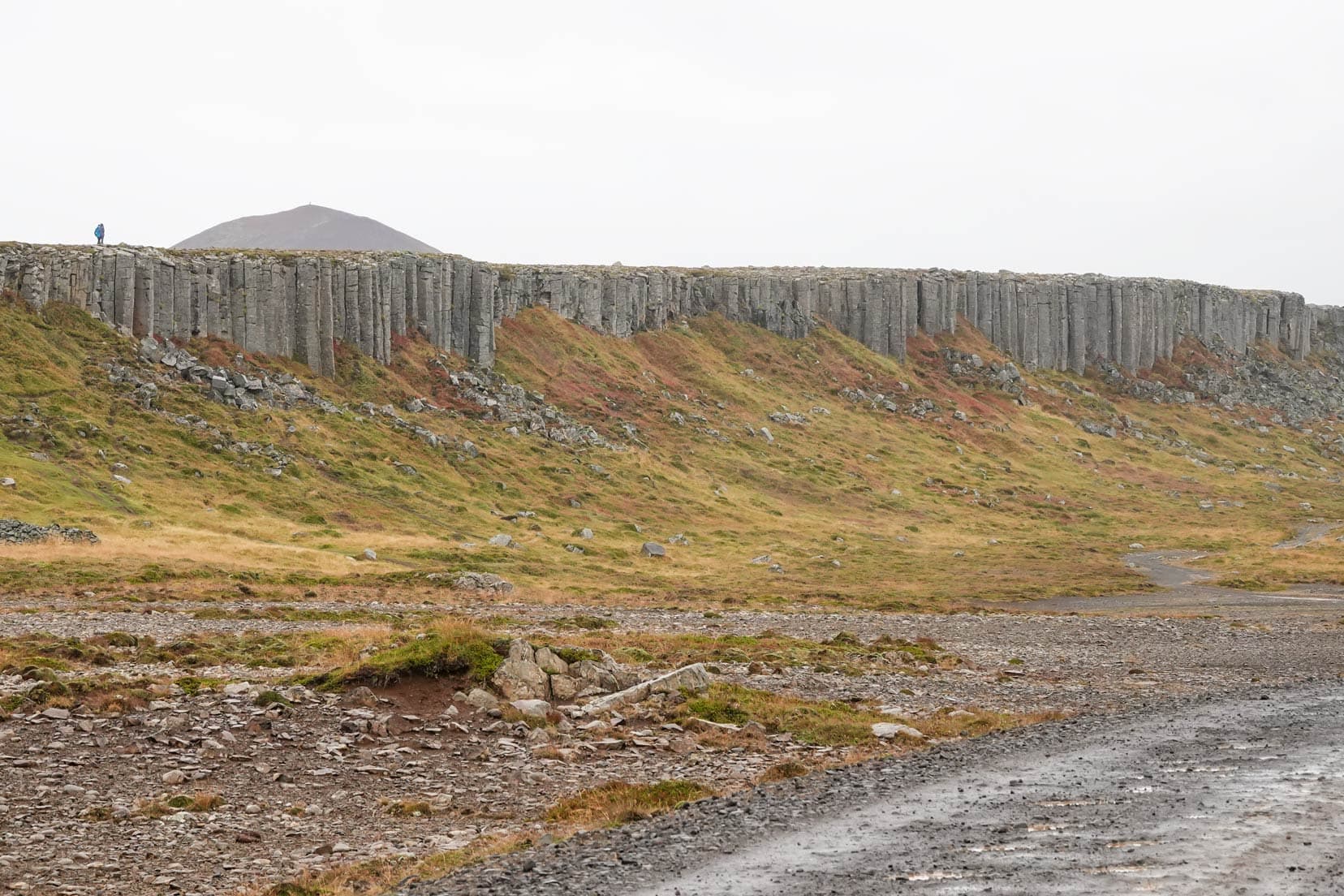
Ölkelduvatn Mineral Spring
Free Icelandic mineral water anyone? Ölkelduvatn Mineral Spring offers tasting straight from the tap.
Don’t expect the clear, pristine-looking water you buy in the shop. This mineral spring’s water has such a high iron content that it runs red, staining the stones in its little stream bed.
An official sign nearby verifies the water is safe to drink and within acceptable limits for mineral content.
I did the taste test, and I wasn’t overly impressed. It reminded me of the taste of blood, but I’ll let you draw your own conclusions.
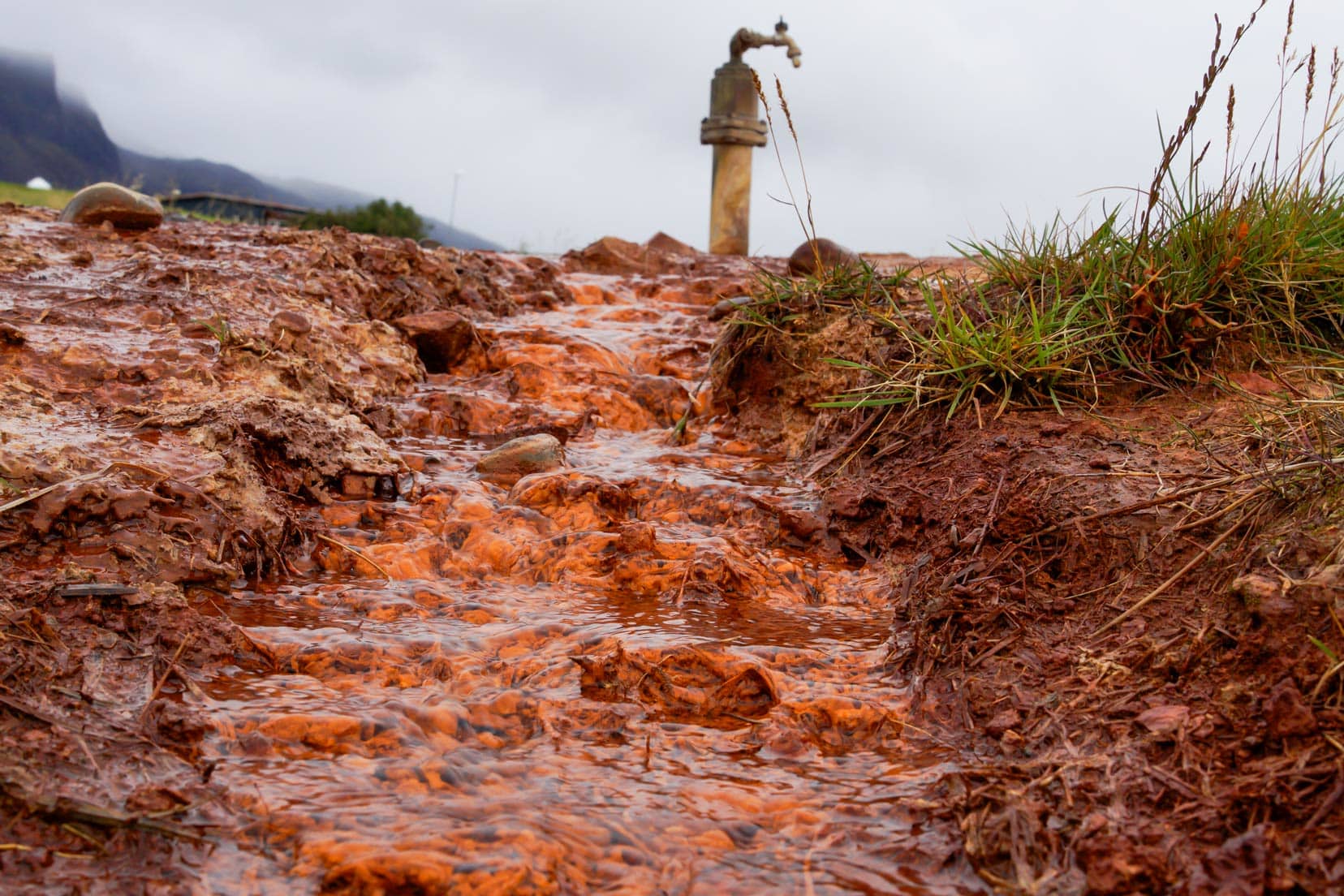
Day 14: Reykjavik
Day 14 heralds the completion of this 14-day Ring Road itinerary.
We’ve certainly done some kilometres and ticked off so many fabulous Iceland September attractions.
Although I have included chasing the Northern Lights only on the first night, remember that opportunity can knock on any night in September.
Top 10 Unmissable September Spots in Iceland
If you’re planning a visit, you might like to know which spots we recommend that you don’t miss out on. It was a tough decision to whittle it down to ten, but it made us really think about the best parts of the trip.
Here are our personal top picks—places that are simply too good to miss if you’re touring Iceland in September.
Each spot offers a unique glimpse into the natural and cultural splendour of this extraordinary island.
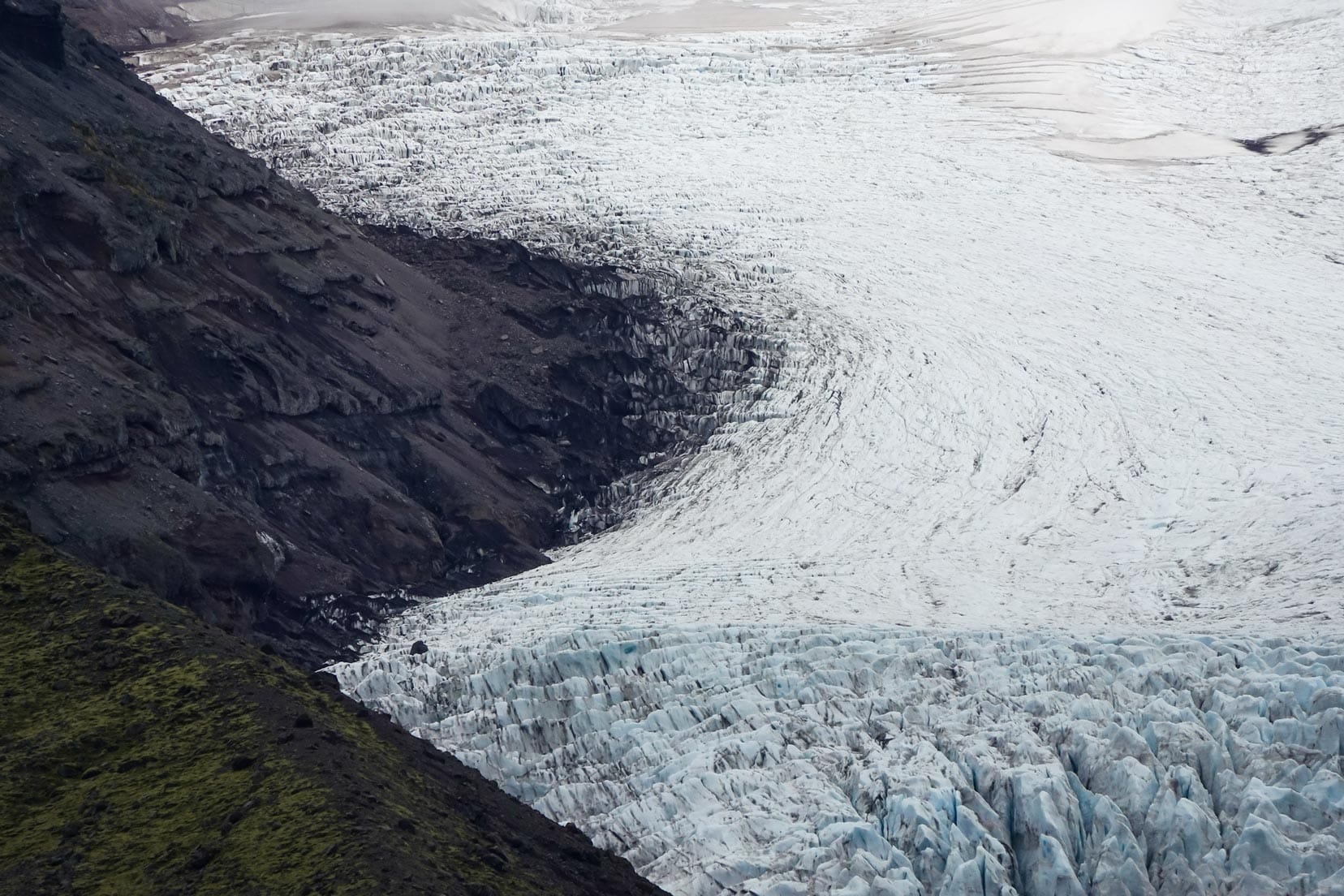
After much consideration, here are our top ten recommended spots to include on a two-week September visit to Iceland:
- Sun Voyager sculpture (Reykjavik)
- Hallgrímskirkja (Reykjavik)
- Geyser field (Haukadalur Valley)
- Reynisfjara black sand beach (near Vik)
- Skogafoss waterfall (near Vik)
- Víðimýrarkirkja (near Sauðárkrókur)
- Jökulsárlón Glacier Lagoon (near Höfn)
- Seyðisfjarðarkirkja (Seydisfjordur)
- Hverir lava fields (near Reykjahlíð)
- Ásbyrgi canyon (near Húsavík)
In my opinion, a Northern Lights sighting deserves the No. 1 spot and would be the icing on the cake for any Iceland trip. However, there’s no guarantee, so reluctantly, I don’t include it in the list.
BUT… optimizing your chances of witnessing the Northern Lights is possible, and I share some tips on this later in the article.
If you’re new to photography or want to capture this celestial dance, you might find my guide on photography on a road trip particularly useful.
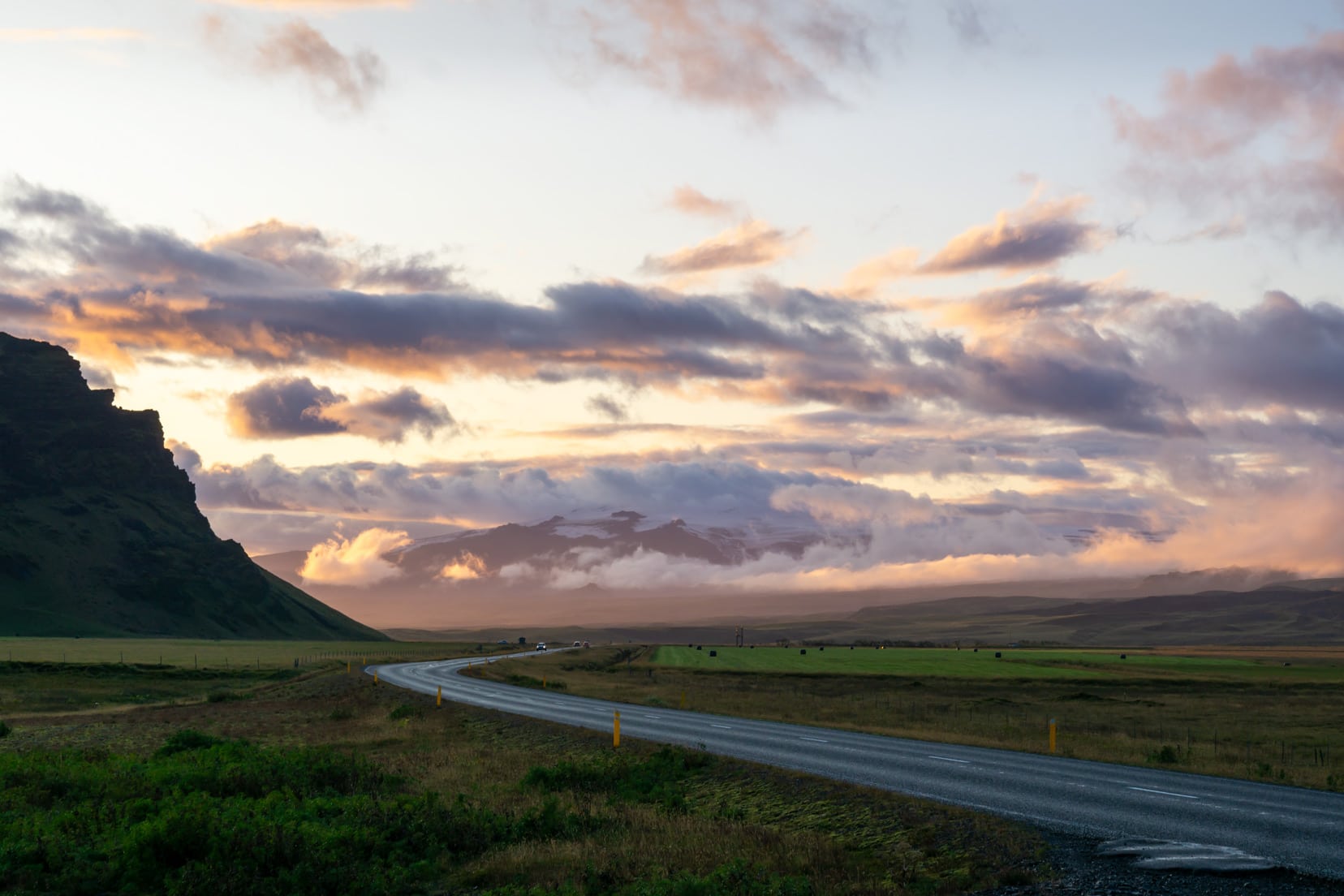
September Photography in Iceland
There is certainly no shortage of fantastic photographic opportunities in Iceland in September. The weather hasn’t turned nasty, the wildlife is abundant, and the Northern Lights have started their shimmy.
- Modern Camera with Memory Cards: Essential for capturing high-quality images.
- Wide-Angle Lens: Ideal for landscape images, typically between 16mm and 24mm aperture.
- Zoom Lens for Wildlife Photography: This lens has a focal length of 200mm up to 600mm, making it perfect for capturing distant subjects.
- Tripod: This helps stabilize your camera during long exposures, which is essential for capturing the Northern Lights and in low-light conditions.
- Camera/Lens Cleaning Equipment: Keeps your gear in top condition to avoid any image quality degradation.
- ND Filters: Slows the shutter speed, adding a dreamy effect to moving water in your images.
📸 Take a look at our photography gear, to get an idea of what we use from location to location.
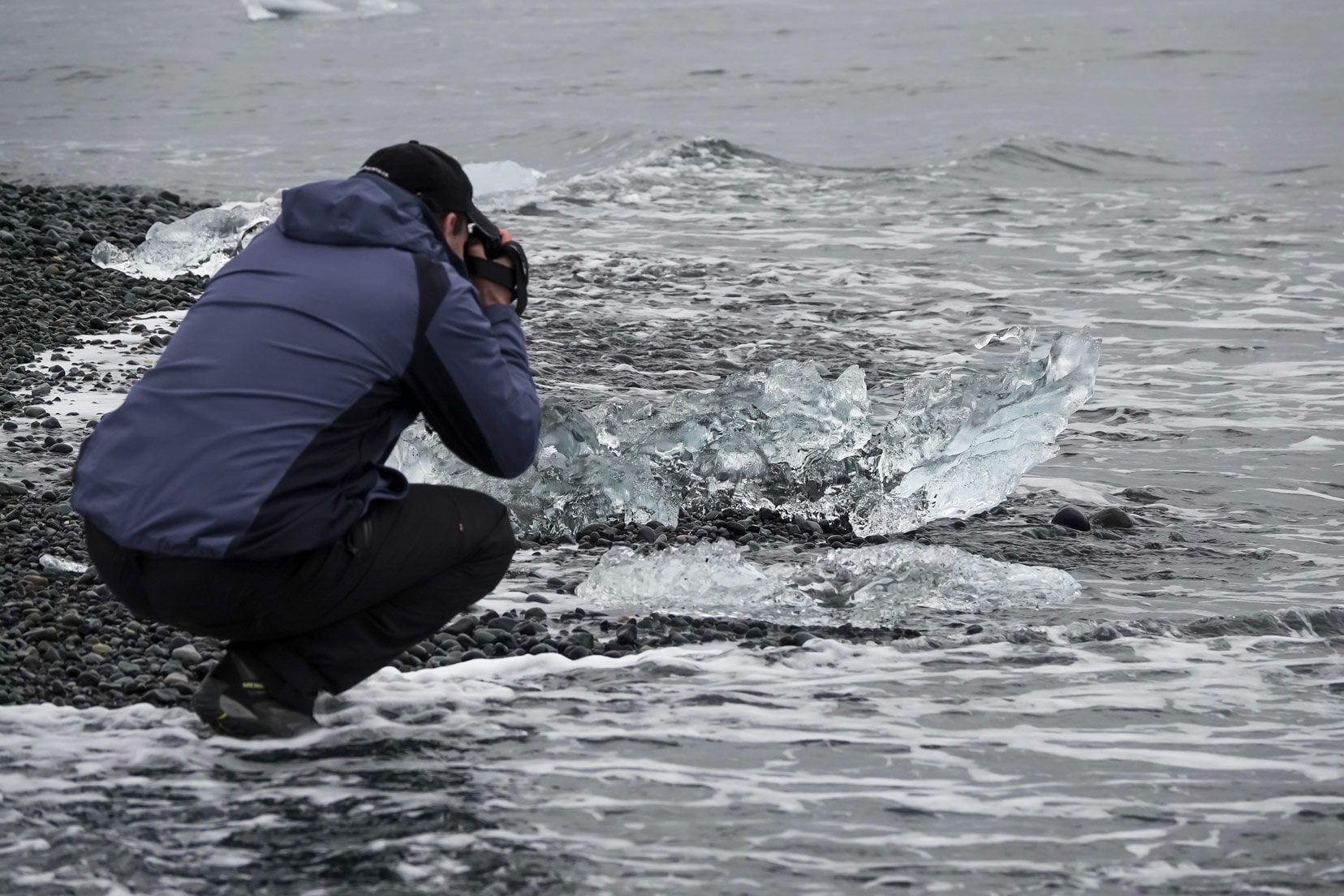
Natural Wonders in September
Chasing Northern Lights in September
Iceland is known as one of the best places in the world to see the Northern Lights, and we were determined to try our luck.
I downloaded the free app for the Aurora Borealis daily forecast to help get our timing right and increase our odds of a sighting. I made sure to reference NOAA’s website (The National Oceanic and Atmospheric Administration) for the 3-day Aurora forecast.
In Reykjavik at the time and with a prediction of minimal cloud cover and a Kp index of 4, I took a chance and drove 30km south, avoiding the light pollution of Reykjavik, to Lake Kleifarvatn and onto Grænavatn Lake.
I chose the view over the lakes to give us uninterrupted views of the Northern Lights. As it turned out, everything went according to plan, and we had our best-ever sightings of Northern Lights.

Increase Your Chances of Viewing the Northern Lights
You can’t second guess Mother Nature when it comes to finding the Northern Lights; however, you can tip the odds in your favour by:
- Planning a visit between September and April when the night sky will be dark enough to view the lights,
- Monitoring the weather conditions whilst looking for reduced cloud cover. Gauge the direction of the prevailing wind, which might shift the clouds and open up the sky.
- Using the Icelandic Met Office (vendor.is) predicted KP index to indicate the probability for the Northern Lights appearing.
The Kp Index is 1 to 9, with increasing geomagnetic activity. The higher the Kp index, the greater the probability of the Northern Lights appearing. - Choosing a viewing location away from sources of light pollution.
For more Northern Lights inspiration, check out our post: Northern Lights Experience in Lofoten, Norway
Wild Encounters: Iceland’s September Wildlife Watchlist
🦭Seals
- Description: Harbour and grey seals are permanent residents. Occasional visitors include ringed, hooded, bearded, harp seals, and walruses.
- Best Places to Spot: Westfjords, Jökulsárlón glacier lagoon, Snæfellsnes Peninsula, Vatnsnes Peninsula.
- Additional Info: Seen at all listed locations.
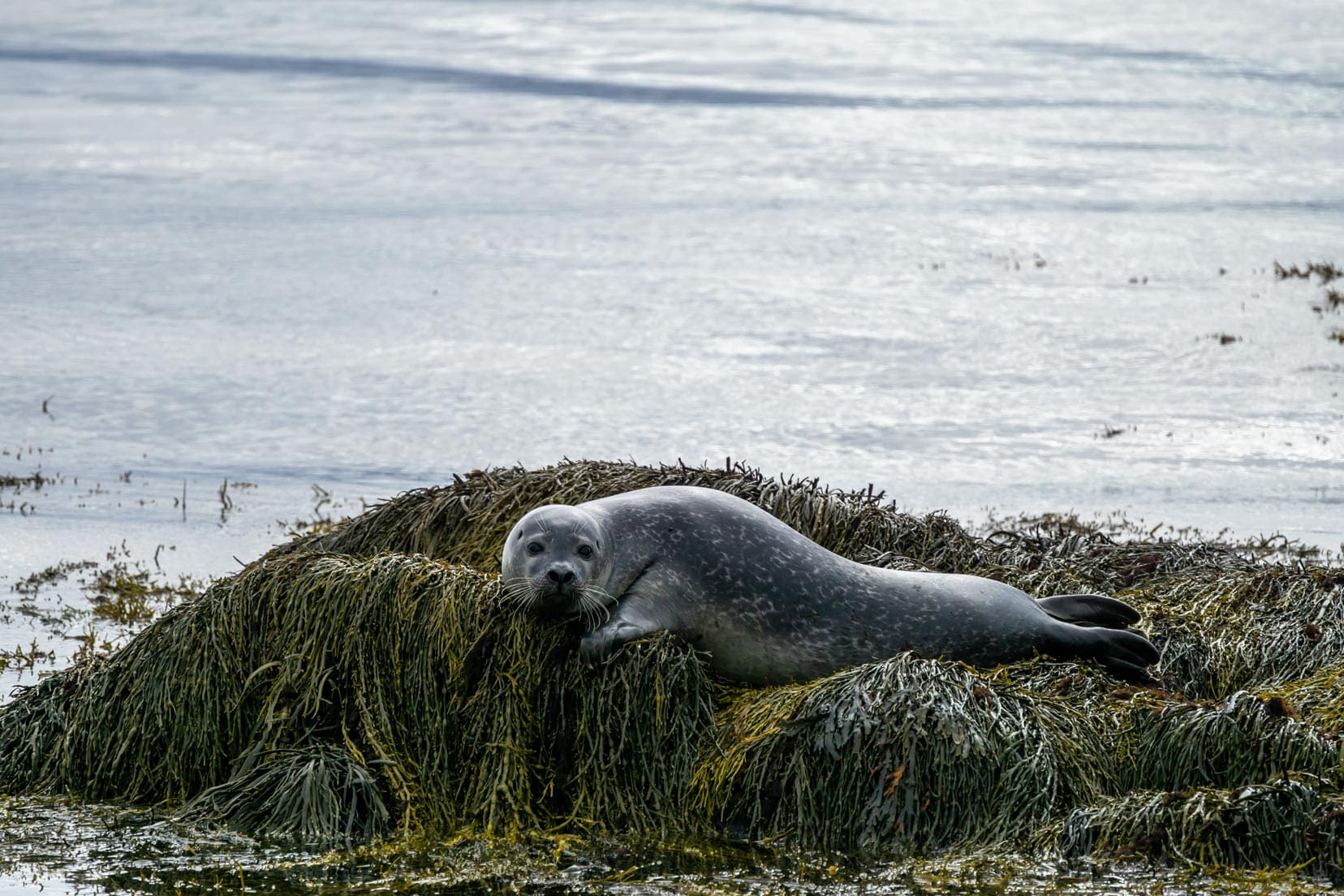
🦊 Arctic Foxes
- Description: Iceland’s only native land mammal, with two types: blue and white Arctic foxes.
- Best Places to Spot: Main habitat is the Hornstrandir Reserve, but found all over Iceland.
- Additional Info: Adapted to various Icelandic environments.
🐋 Whales
- Description: Includes humpback, minke, orcas, fin whales, sperm whales, and blue whales.
- Best Places to Spot: Húsavík, renowned for whale watching tours.
- Additional Info: Húsavík is considered the best place for whale watching in Iceland.
🐴 Icelandic Horses
- Description: Friendly and inquisitive, with a small stature but well-suited to Icelandic conditions.
- Best Places to Spot: Commonly found throughout Iceland.
- Additional Info: Strict disease prevention policy. Opportunities for riding and participating in annual musters. Eating horse meat is a tradition.
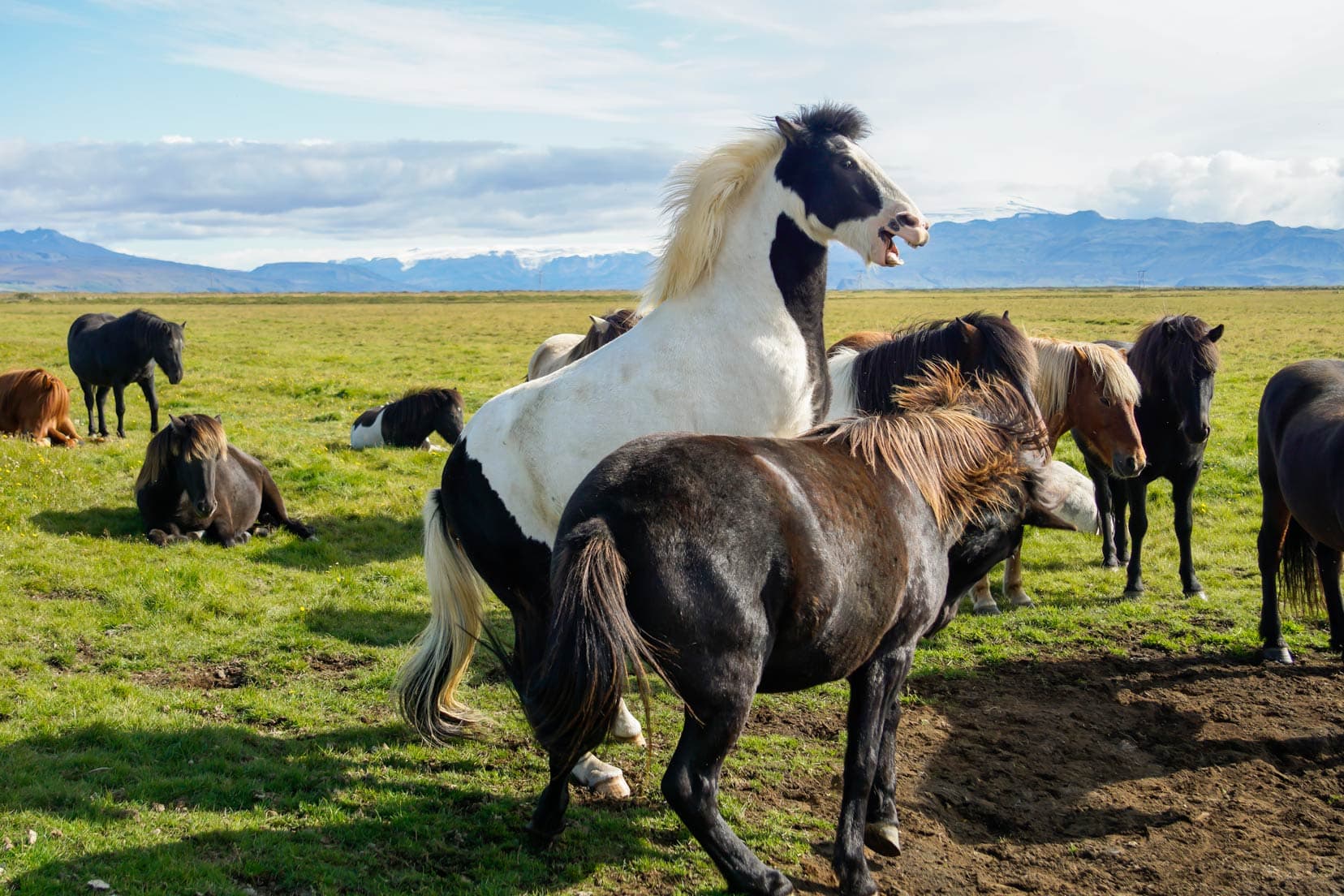
🦌 Icelandic Reindeer
- Description: Main concentration in eastern Iceland. Controlled numbers for land management.
- Best Places to Spot: Found around Snæfell.
- Additional Info: Total population over 3,000.
🪶 Ravens
- Description: Symbolic in old Icelandic beliefs.
- Best Places to Spot: Found all over Iceland.
- Additional Info: Accompanied by Arctic terns, sea eagles, ducks, geese, and swans.
🕊️ Fulmars
- Description: Resemble seagulls but notable for a tubular piece on their beak. Known for eating too much as chicks.
- Best Places to Spot: Found in cliffs all over Iceland.
- Additional Info: Chicks are often found dead or floundering on roadsides due to the inability to avoid vehicles because of overeating.
🚫 Wildlife You Likely Won’t See in September:
- Puffins arrive in April/May and depart by late July/August, primarily roost on the island of Akurey, near Reykjavík.
- Polar Bears are rarely seen as they occasionally drift from Greenland and are considered a danger to humans.
Iceland Cultural Insights in September
Participate in local festivals, taste Icelandic delicacies, and engage with the locals. September hosts various cultural events that provide deep dives into Iceland’s rich heritage.
- 🎬 Reykjavik International Film Festival (RIFF) 2024 (21st edition): Held from September 26 to October 6, it features a wide range of films from global and local artists, marking it as one of Iceland’s prime cultural events.
- 🍺 Oktoberfest in September? Experience Iceland’s version of the famous beer festival with live music and entertainment, hosted by the University of Iceland in Reykjavik, from late September.
- 🍇 Berjamó (Berry Picking): From mid-August to mid-September, Icelandic families gather crowberries and bilberries in the countryside. Picking is permissible on public land.
- 🐑 Réttir (Sheep and Horse Round-Up): Starting mid-September, this traditional event sees families and farmers rounding up sheep across regions like Bjarteyjarsandur, near Reykjavik, Akureyri, and Skagafjörður.
Practical Travel Tips: Planning Your September Itinerary
Before you set off on your Icelandic adventure, it’s essential to consider not only where you’ll stay but how you’ll navigate the unique landscapes and conditions Iceland presents in September.
Here, we cover booking accommodations, road trip planning, and hiring a car or motorhome.
Plan Your Stay for 14 Days in Iceland
Accommodation Tips:
- Book Early: Ensure all accommodation bookings are confirmed six months in advance to avoid the high-season rush.
- Consider Longer Stays: Where possible, plan for at least two-night stays at each location to minimize travel fatigue and enjoy each destination thoroughly.
- Choose B&Bs: Our preference was largely for bed and breakfasts, where we often enjoyed the convenience of early check-ins. This was helpful as it allowed us to dump our luggage, regroup, and venture out for the day.
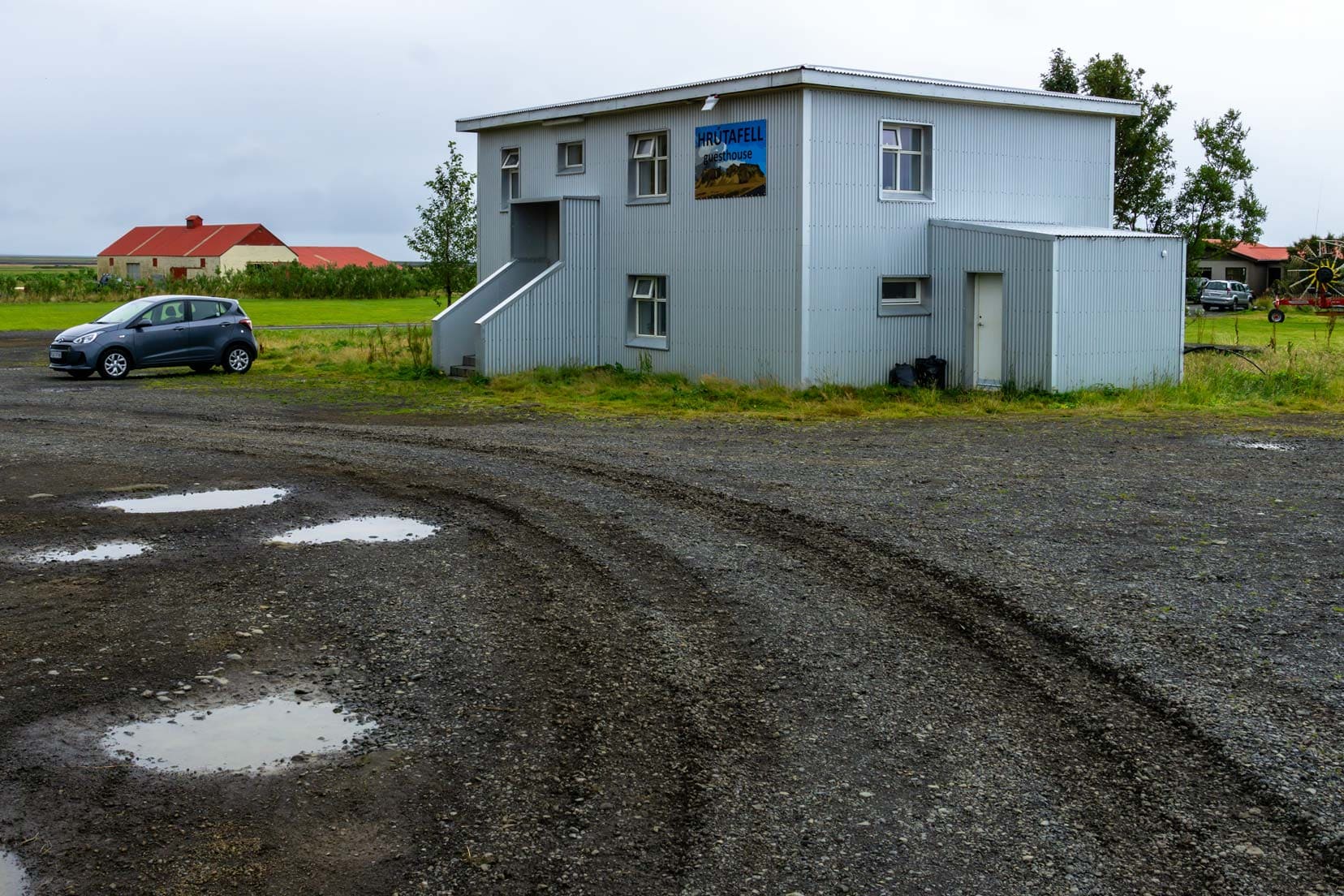
Before You Arrive in Iceland
It’s crucial to understand what to expect before you land:
- Weather and Terrain: September signals the end of summer, so expect milder temperatures and some rainfall, but also long days perfect for exploring.
- Navigating Iceland: Familiarize yourself with local driving conditions, road rules, and how to hire the right vehicle for your journey – whether sticking to the paved Ring Road in a 2WD or adventuring into rougher terrain requiring a 4WD.
- Local Customs and Practical Tips: Understand local customs, essential Icelandic phrases, and other handy tips to enrich your experience.
Iceland’s Weather in September
September heralds the start of fall in Iceland. The weather is good for travelling but can be unpredictable. You can expect a bit of everything – weatherwise except snow.
During our September visit, showers would last a maximum of one hour and then clear. Not hampering our plans at all.
Typical September temperatures range from 5 °C to 15 °C (41°F to 59°F). However, the areas around the glacial lagoons hover near the freezing point.
There is plenty of time to do what you want, with September offering a healthy average of 13 hours of daylight.

Travel Essentials: Packing and Preparation
Packing Essentials:
- Weather Appropriate Gear: Pack waterproof and thermal clothing to adjust to Iceland’s unpredictable weather.
- Photography Equipment: Bring cameras, memory cards, and cleaning equipment to capture the stunning landscapes.
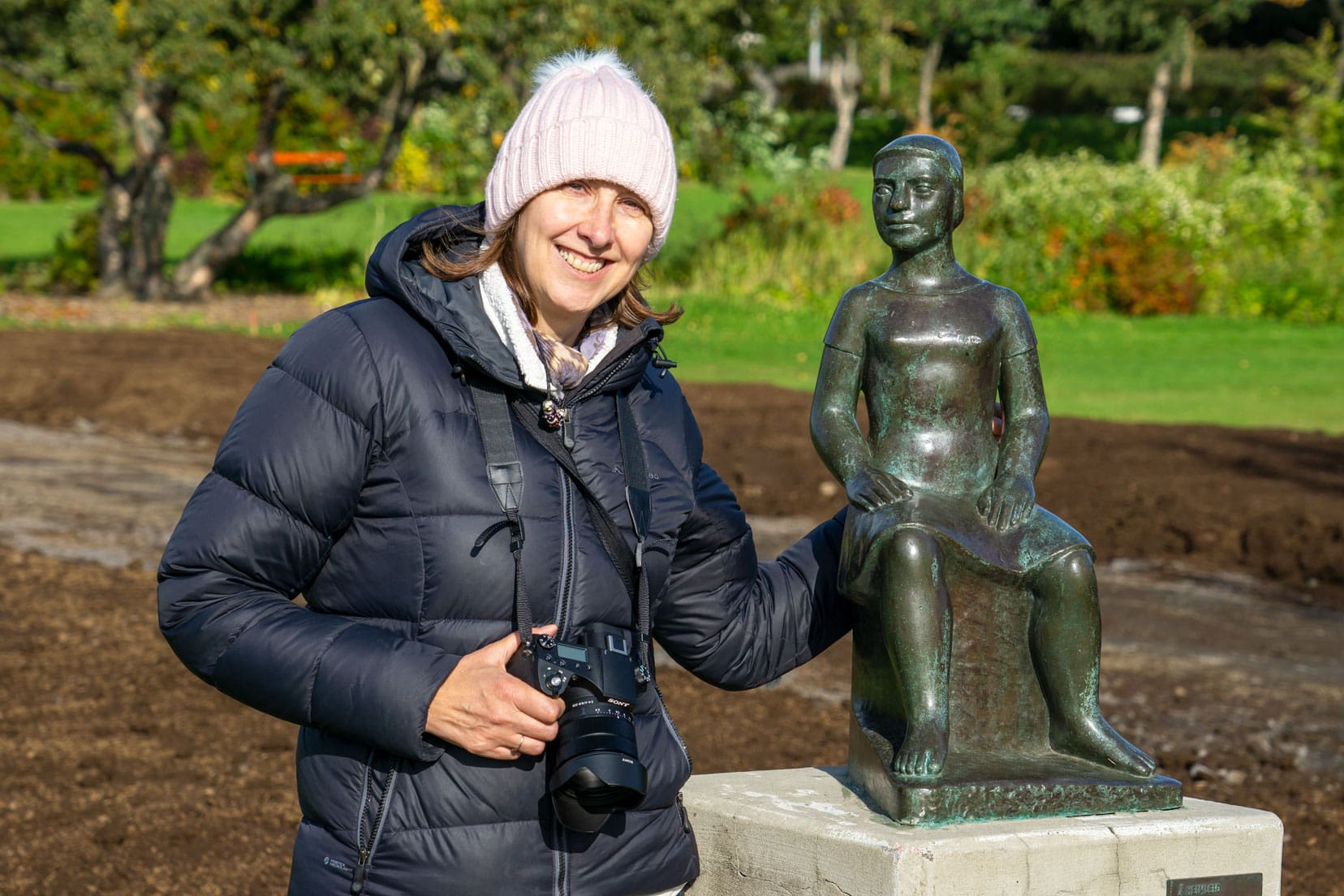
Driving in Iceland
When exploring Iceland, the choice between a 2WD and a 4WD can significantly affect your travel experience.

Here are the essentials:
- Vehicle Choices:
- 2WD vehicles are suitable for main roads like the Ring Road, which are well-maintained and mostly paved.
- 4WD vehicles are recommended for rougher terrains and necessary if planning to drive on ‘F’ roads into the highlands.
- Driving Tips:
- Preparation is key: Ensure all accommodations and vehicle rentals are confirmed well in advance.
- Understand Road Categories: The Ring Road is suitable for 2WD vehicles. ‘F’ roads require a 4WD and are only open seasonally.
- Check Conditions: Always check current road conditions here before setting out.
- Safety:
- Drive cautiously on gravel roads to avoid stone chips.
- Beware of strong winds which can damage car doors; not all damages may be covered by insurance.
- Cost-Effective Options:
- Renting a 2WD tends to be less costly, with lower rental and insurance rates.
- Recommended Rentals:
- 🚘 For car rentals, consider DiscoverCars for competitive pricing and flexibility.
- For motorhome rentals, Motorhome Republic offers comprehensive deals and excellent customer service.
When touring in a motorhome, you have the flexibility to choose spectacular overnight stops, enjoying Iceland’s natural beauty at your own pace.
Note: All the attractions featured in our 14-day Ring Road itinerary can be safely and legally accessed from the Ring Road in a 2WD vehicle.
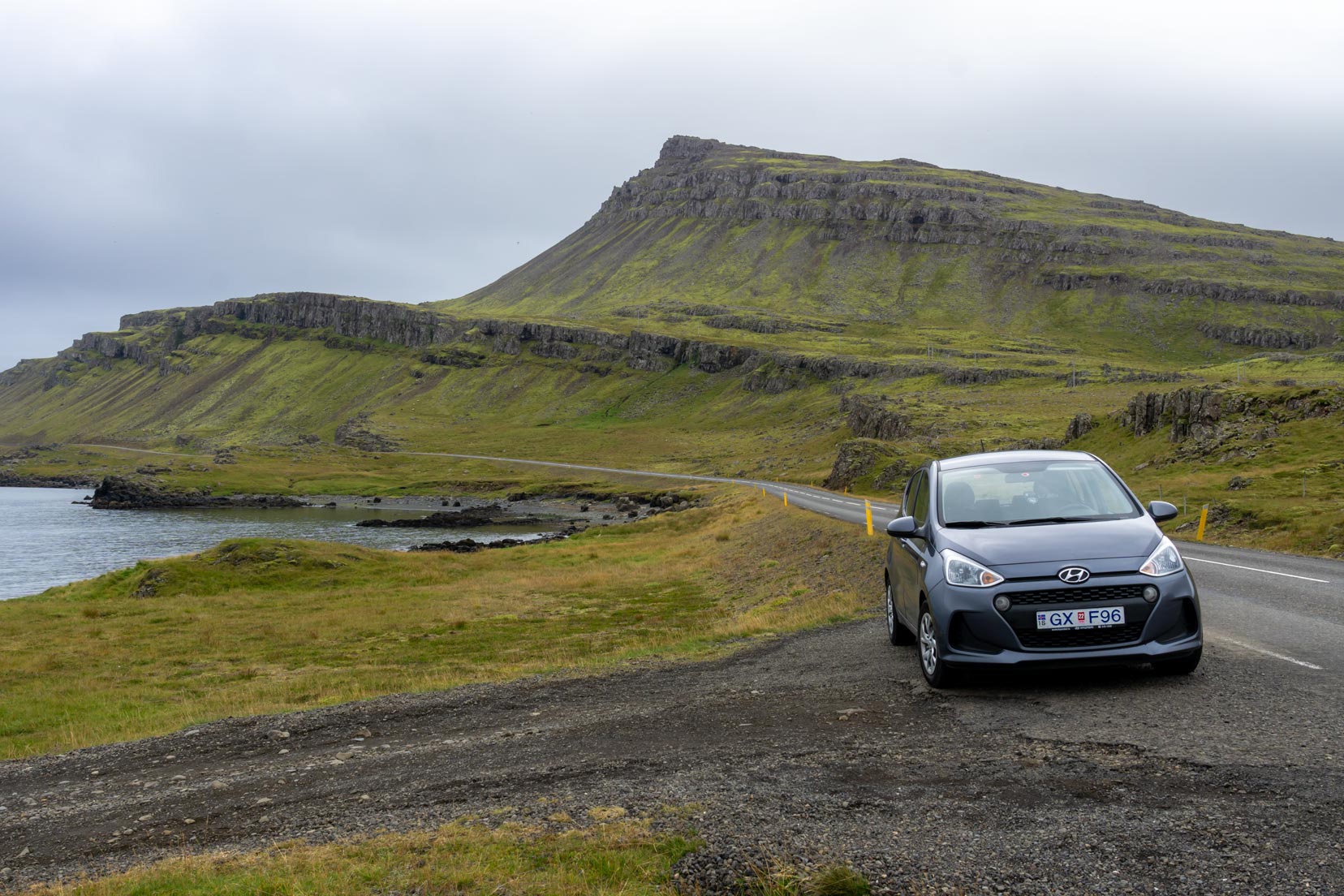
🚘 If you are looking to hire a car, then we recommend DiscoverCars.
- They are winners of the World’s Best Car Rental Booking Website
- They have a Price Match Guarantee.
- 4.5 Rating on Trustpilot
- Free Cancellation
Free: Roadtrip Planner Download
To help you with your road trip planning, we’re giving you a free trip planner to organise all your valuable information in one place. We use this ourselves.
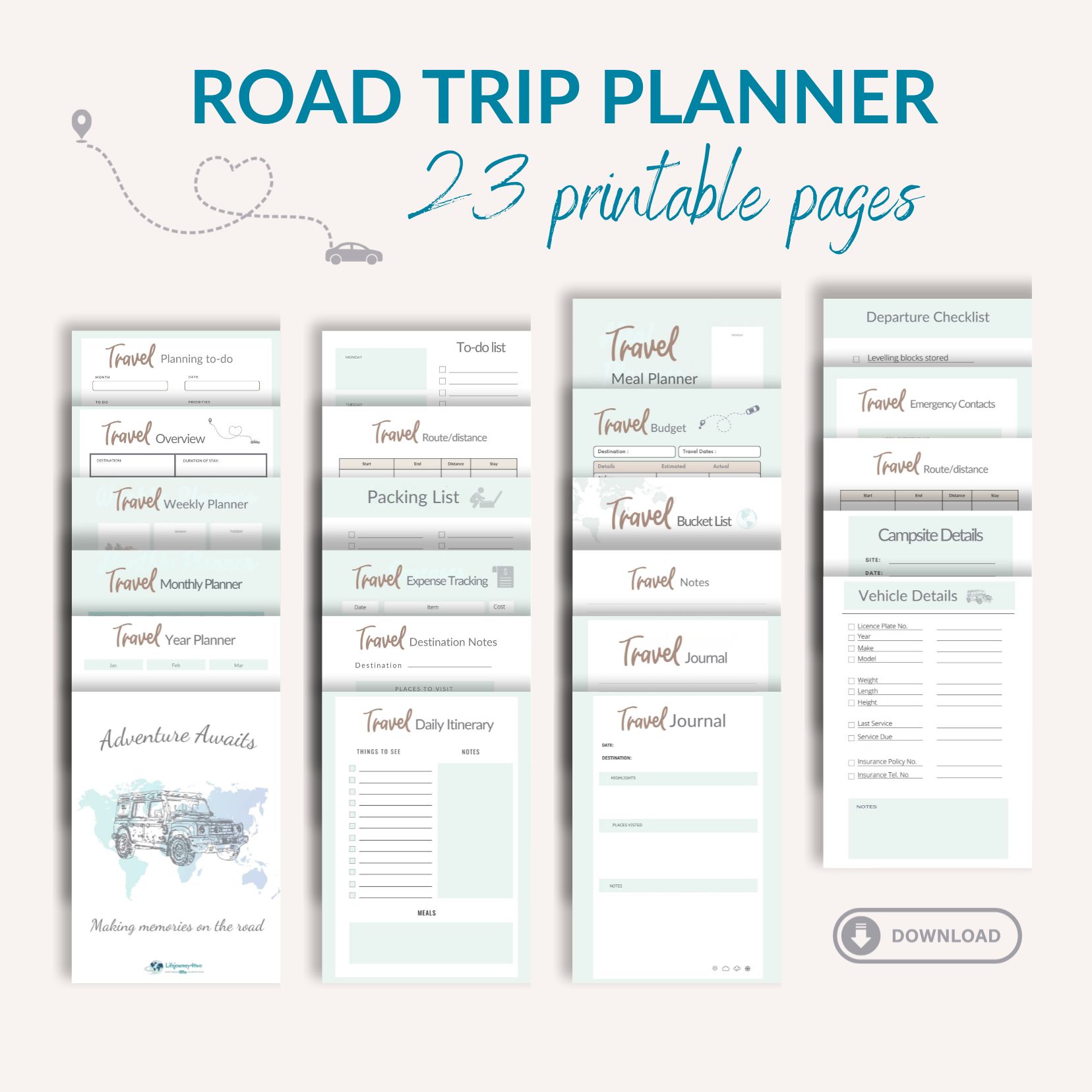
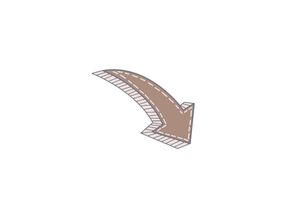
Is 14 days in September Enough Time in Iceland?
Absolutely, 14 days offers an ideal timeframe to fully experience the Iceland Ring Road and all its attractions. We saw the best of Iceland’s attractions, and importantly, we did not need to rush.
Less than 14 days to travel to Iceland?
Tick off your favourite attractions and focus on seeing them. Iceland has a lot to see in all parts of the country, so you’re sure to see interesting sights along the way.
The Snæfellsnes Peninsula (known as ‘Iceland in Miniature’), western and southern coasts of Iceland should be your area of focus; full of wonderful sights.
More than 14 days to travel Iceland?
Extend your stay at any stops mentioned in this itinerary and make the trip more leisurely. With hindsight, we would have stayed an extra night at Höfn to explore more of the area around the Jökulsárlón Glacier Lagoon.
Safe Travels: Essential Contacts and Apps for Iceland
I’ve included some handy information for your September Iceland visit to get you off to a good start.
Emergency Number in Iceland
- 112 is the number to dial for accidents, fire, crime, search and rescue, and natural disasters. You can dial this number in the highlands without having a mobile connection.
Handy Phone Apps for Iceland
- ve∂ur: A weather app for iOS and Android generated by the Icelandic Met Office, providing temperature, rain, and wind forecasts up to 5 days in advance.
- maps.me: An offline maps app for iOS and Android that allows you to navigate without an active network connection and allows you to mark places of interest.
Handy Websites for Your Iceland Trip
- Aurora Borealis Daily Forecast: Visit the Icelandic Meteorological Office at https://en.vedur.is/weather/forecasts/aurora/ for daily updates.
- Aurora Borealis 3-Day Forecast: The NOAA provides a 3-day Aurora forecast at https://www.swpc.noaa.gov/products/3-day-forecast.
- Check Road Conditions: Before travelling, check current road conditions here.
- Submit an Online Travel Plan: Use https://safetravel.is/travel-plan to submit your itinerary. This helps search and rescue services locate you in emergencies. Activate and deactivate this service via text message.
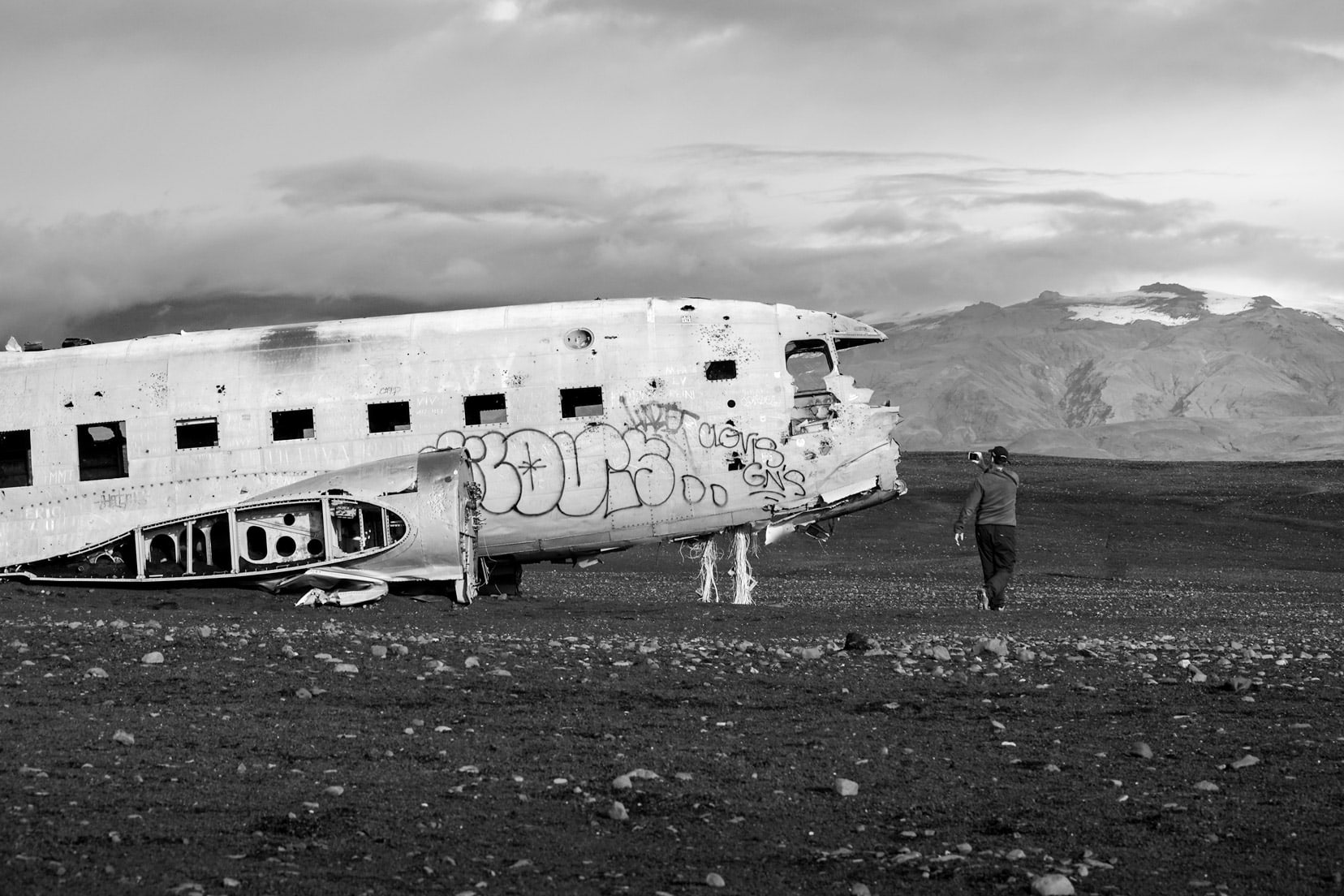
Iceland September Itinerary … That’s a Wrap
As our journey through Iceland’s remarkable landscapes draws to a close, it’s obvious that this country is one of profound beauty and raw nature. You can see why September is such a great time to visit Iceland.
Our 14-day Iceland guide has whisked you through the best of what Iceland offers during this magical month. From the tranquillity of less-travelled paths to the awe-inspiring power of nature’s creations, each day has been planned to ensure you experience the essence of Iceland.
With photography tips, travel insights, and a comprehensive day-by-day breakdown, planning your Icelandic odyssey should now be much easier.
Tailor each day to fit your pace, leaving room for spontaneous exploration and those quiet moments of reflection that often become the most cherished memories.
If Iceland’s September skies are calling, it’s time to answer the call.
If you are travelling as a couple, why not brush up on some essential road trip tips for couples to keep the fun turned up and the stress on the low down?
Before you go, did you remember to download our free travel planner?
Pin and Save for Later
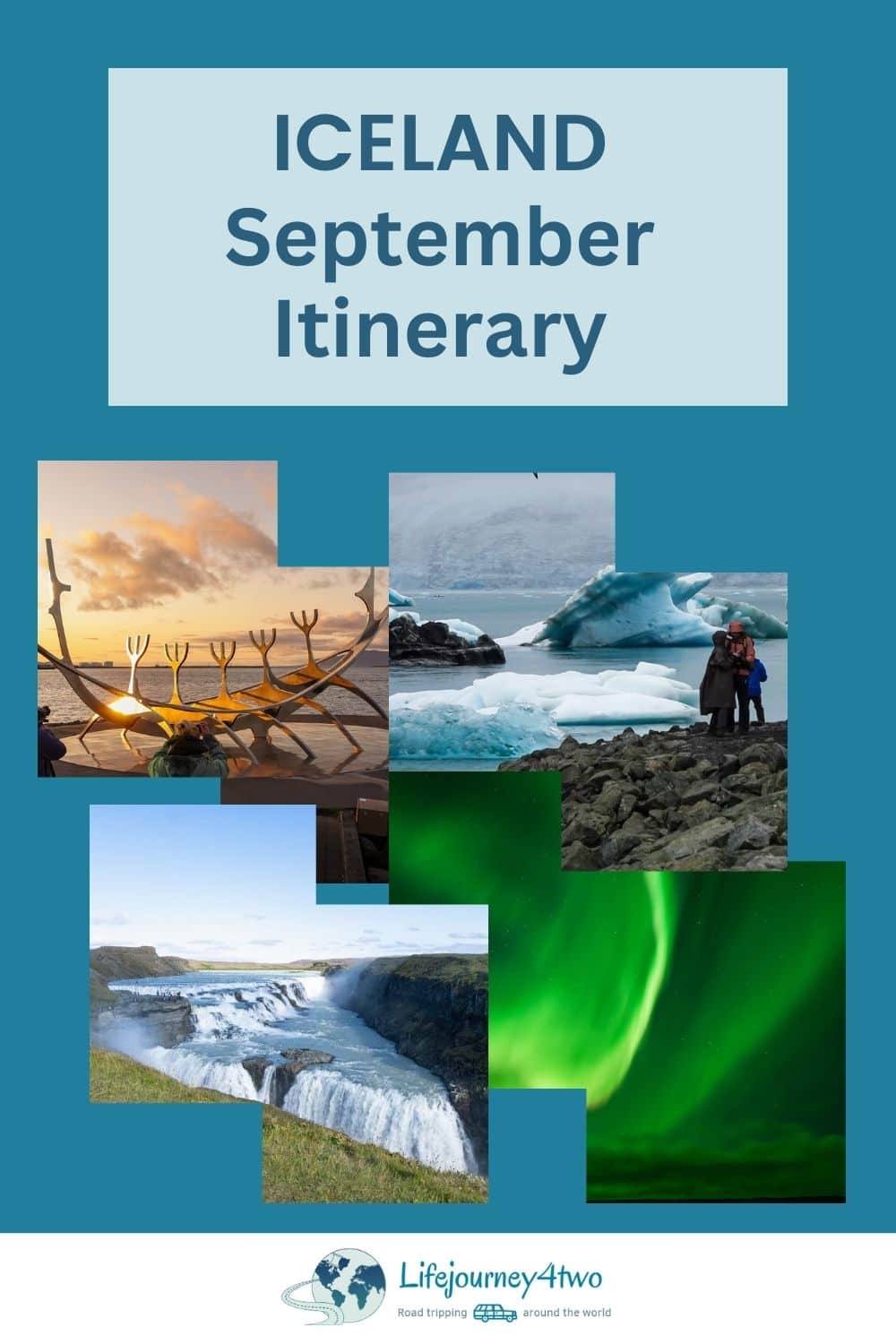
Before You Go – Are You Planning Your Travels?
These are the travel resources we recommend and use when planning our trips.
- 🚘 Car Hire: We use DiscoverCars.com
- Motorhome/Campervan Rental: We highly recommend the Motorhome Republic
- 🪪 Order your International Driver’s Licence online here
- 🛏 Book Accommodation: We use Booking.com to find accommodation that suits our budget
- 🐶 Pet Sitting/Pet Sitters: Check Out TrustedHousesitters here (Use our Discount code: LIFEJOURNEY25 for 25% off. )
- Activities and Experiences: Get Your Guide and Viator
- Travel Insurance: Safetywing or World Nomads
- 🥾 Travel Gear and Accessories: Check out our top picks here — Lifejourney4two page on Amazon
For a more thorough list, visit our Travel Resources page here.

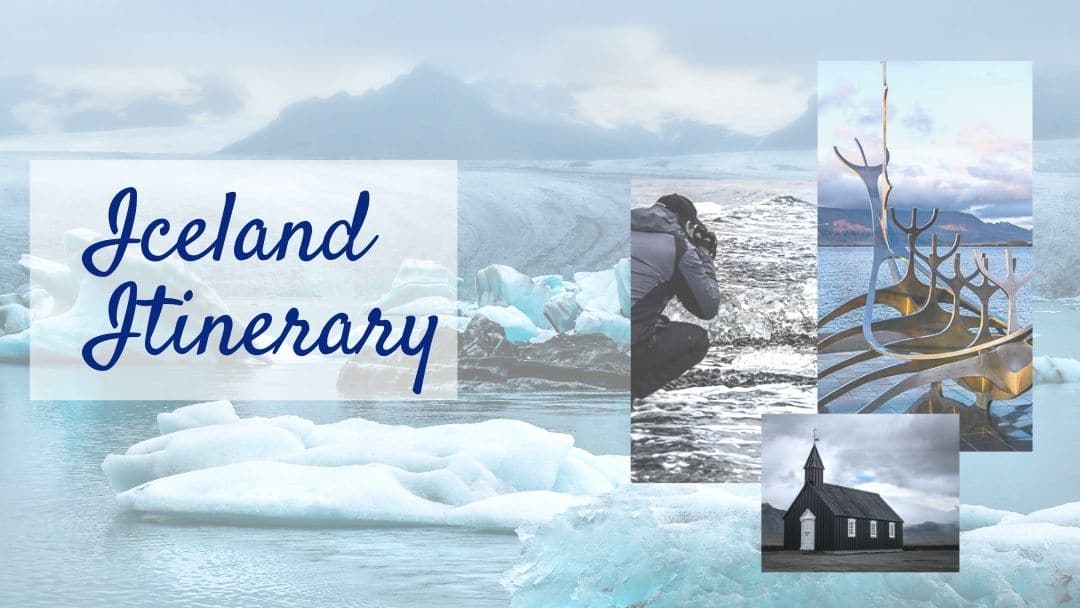
Excellent article about Iceland. Well done!!
Thanks so much Arndis – We loved this diverse country.